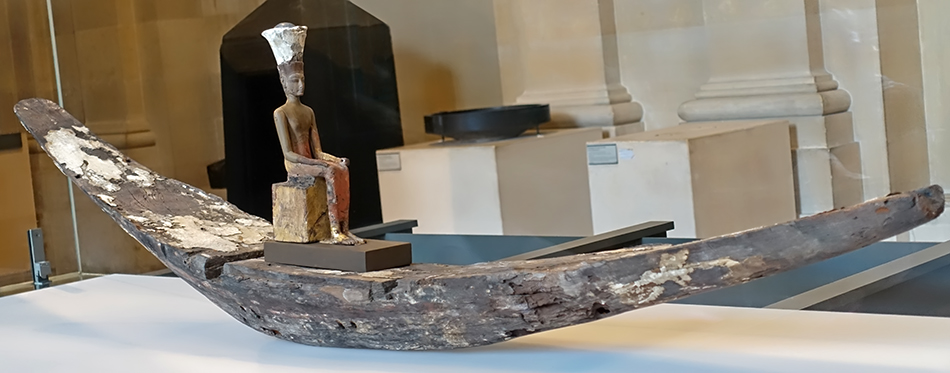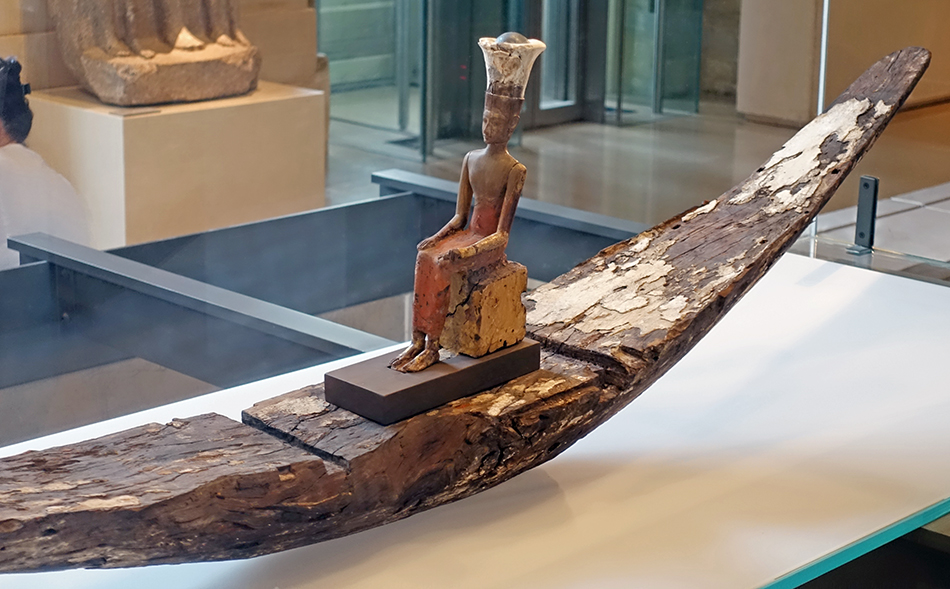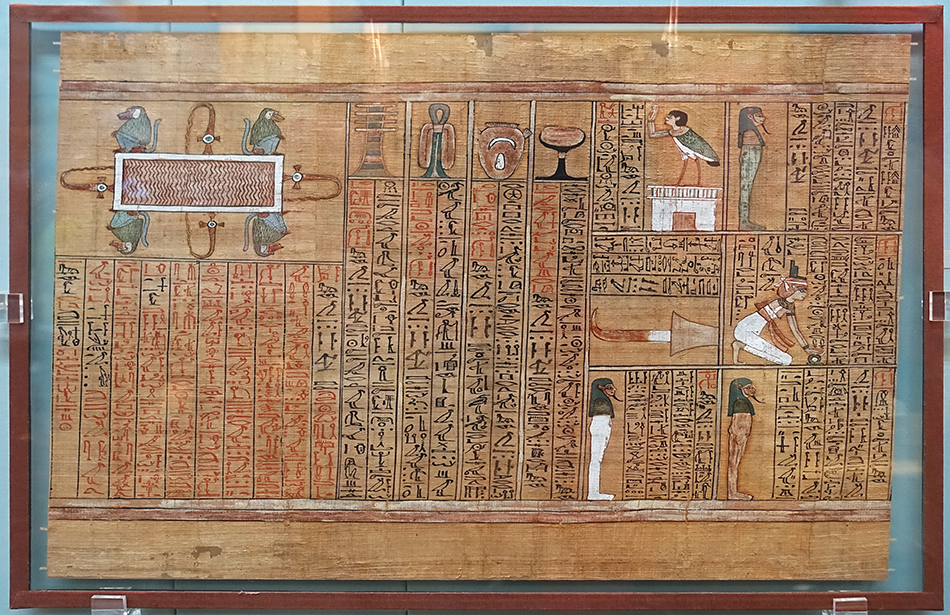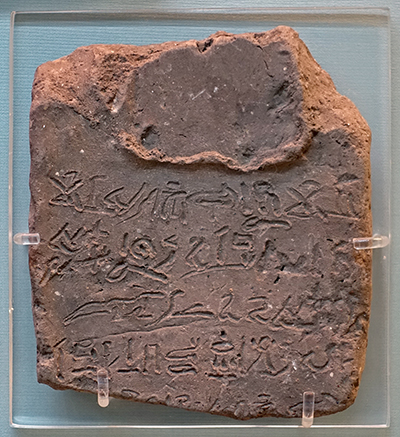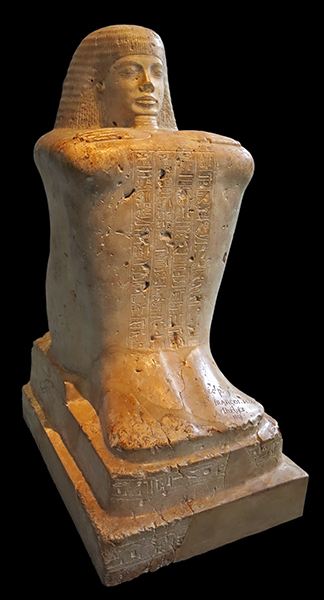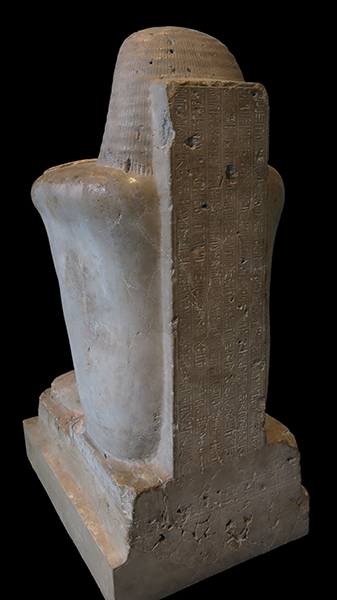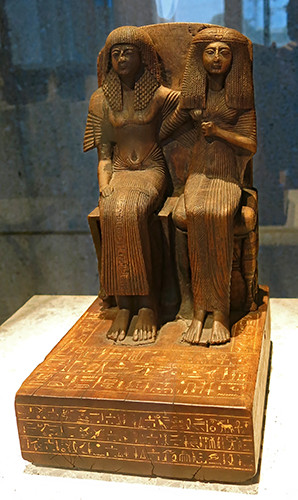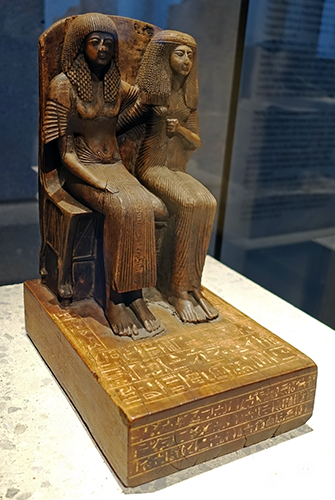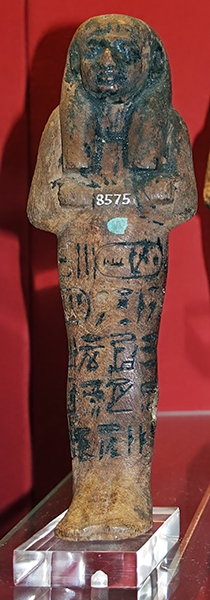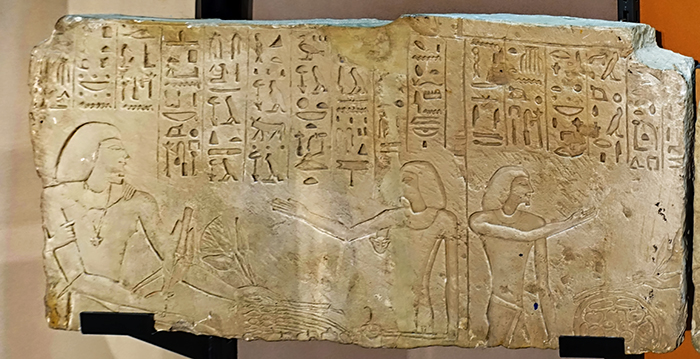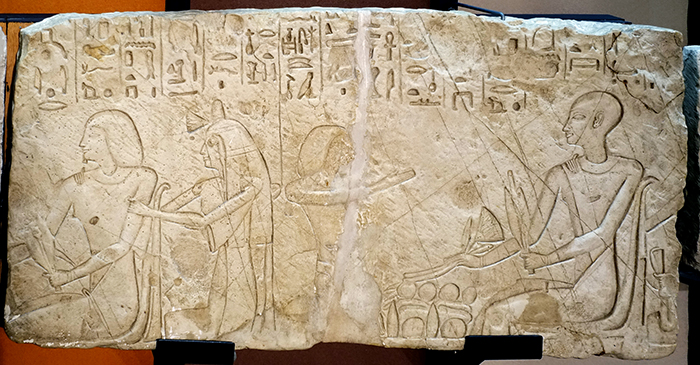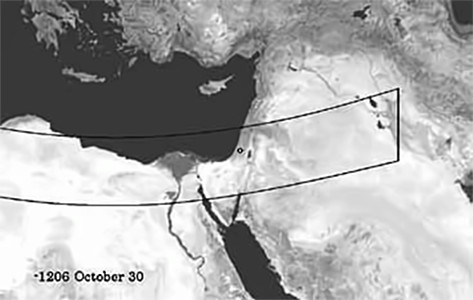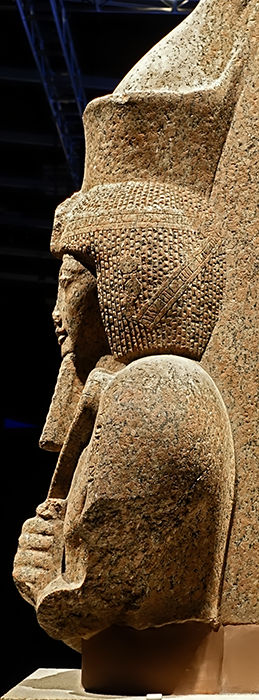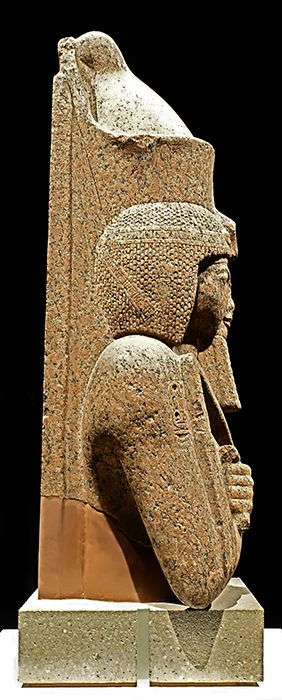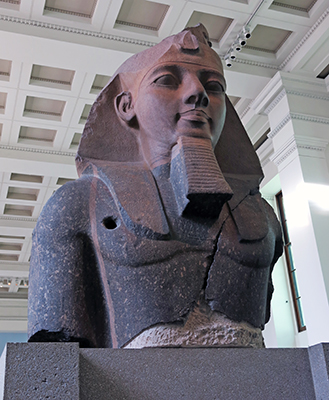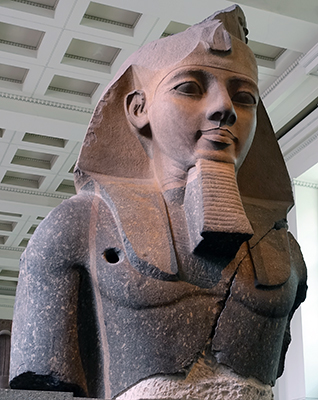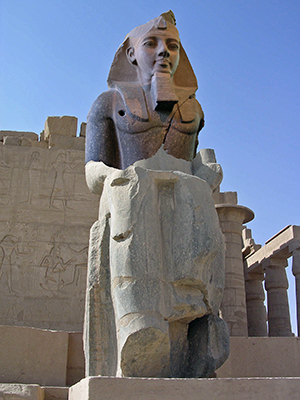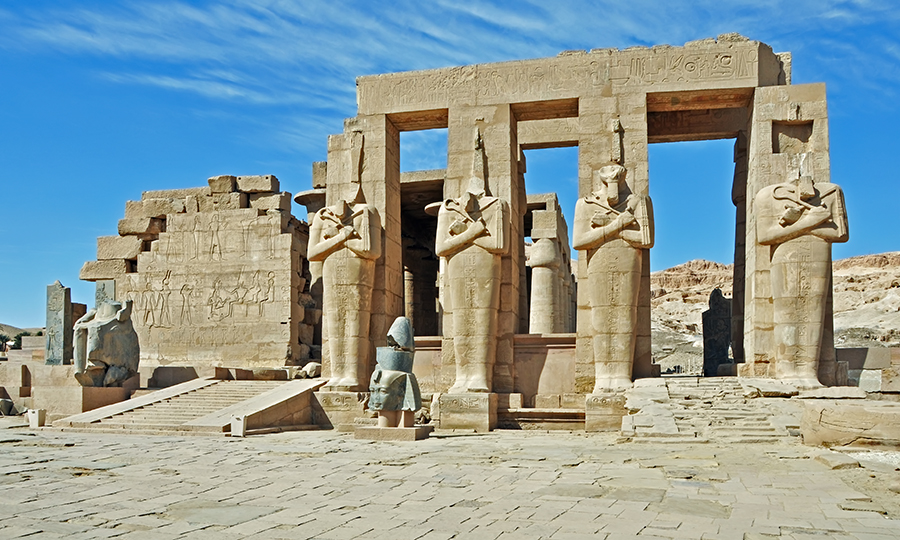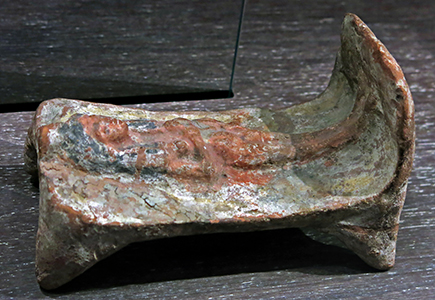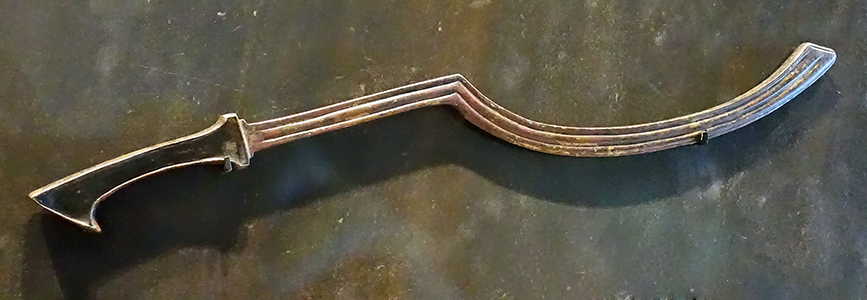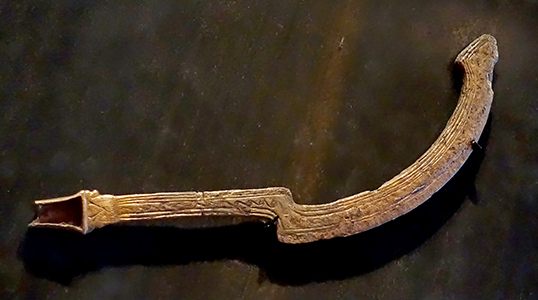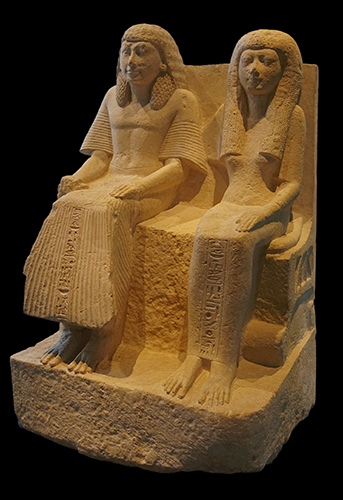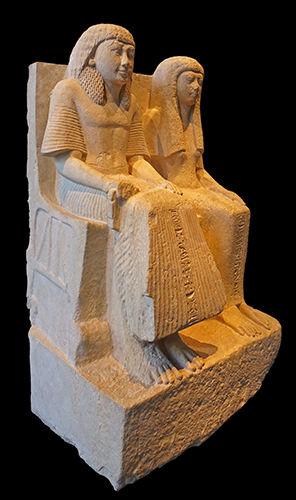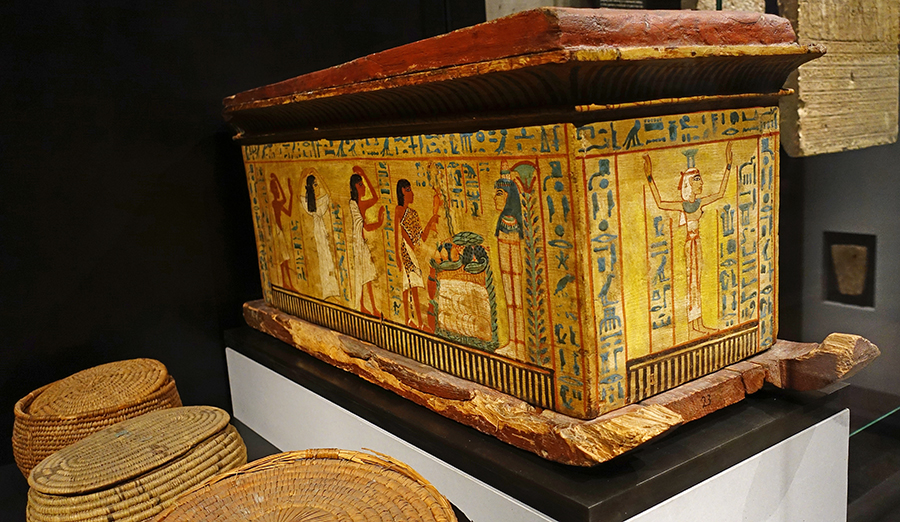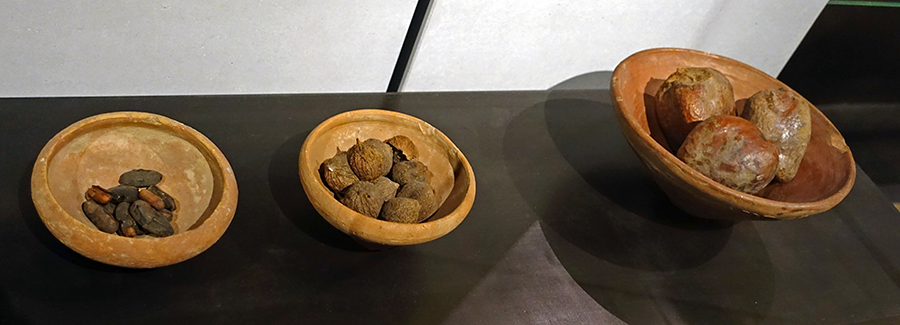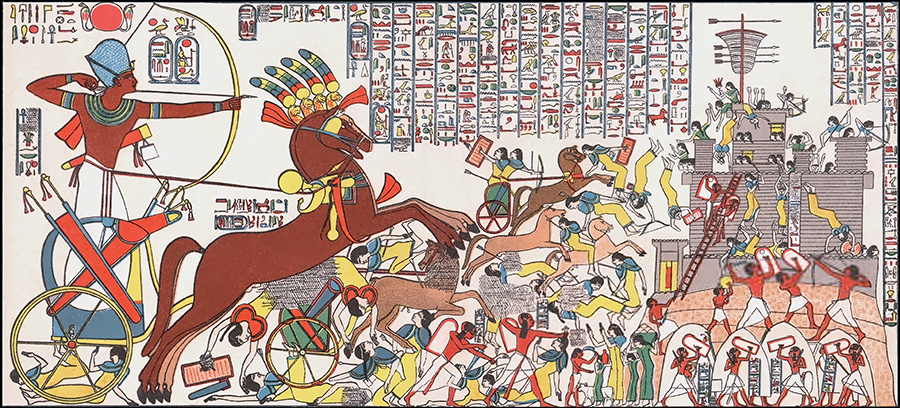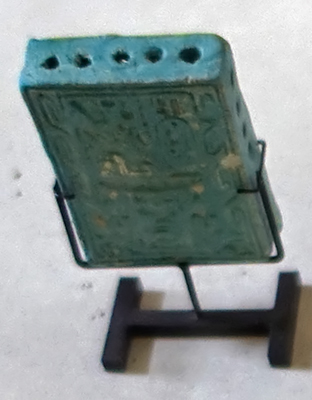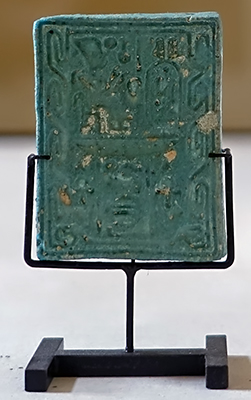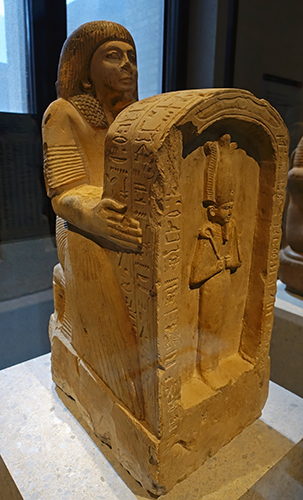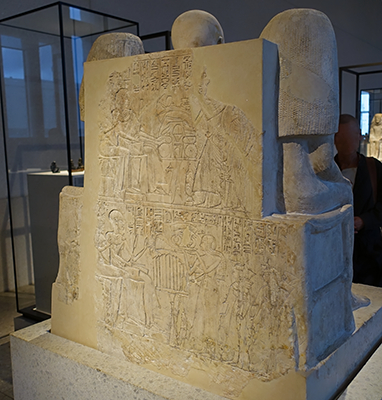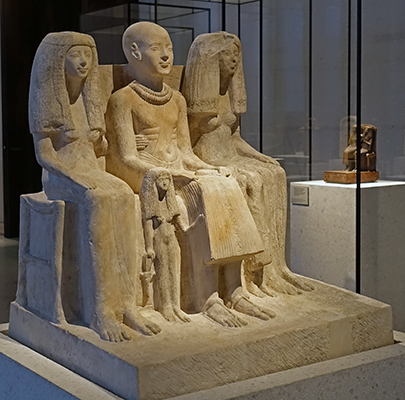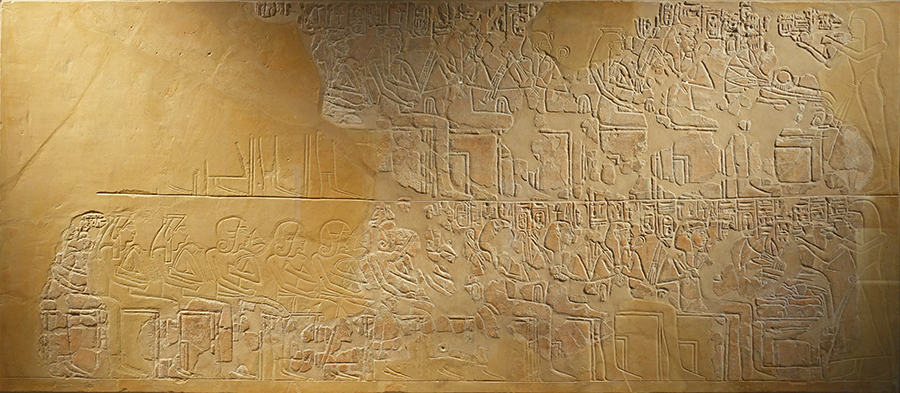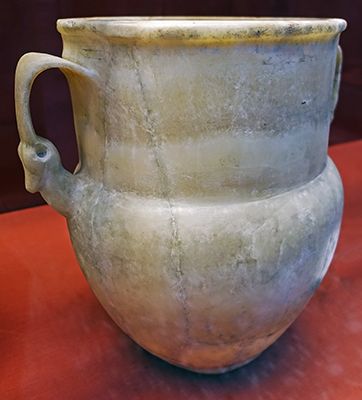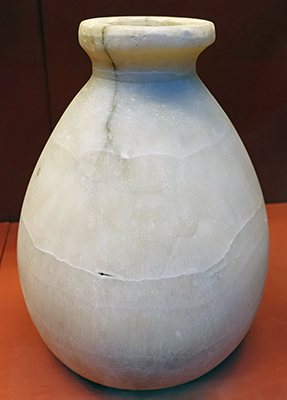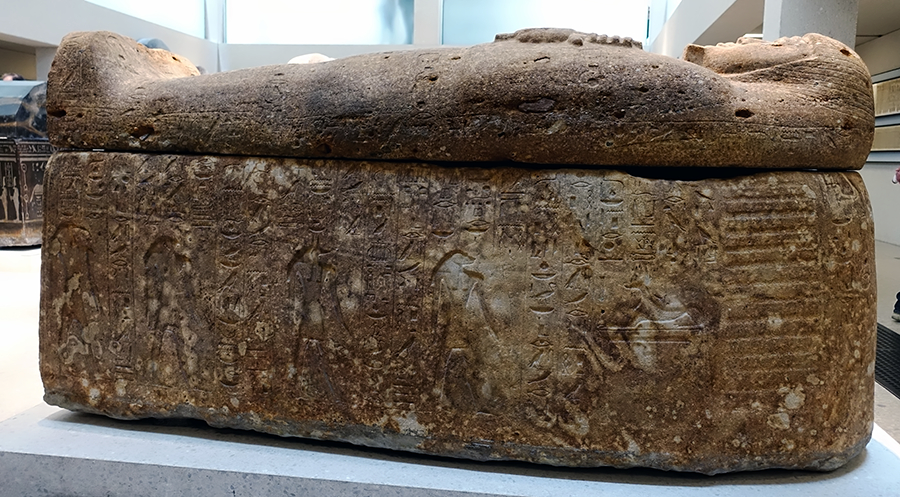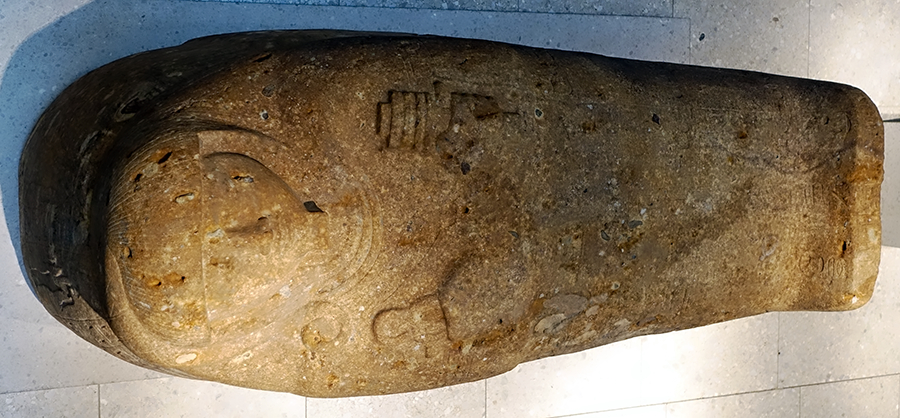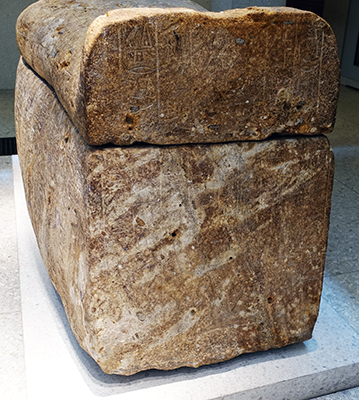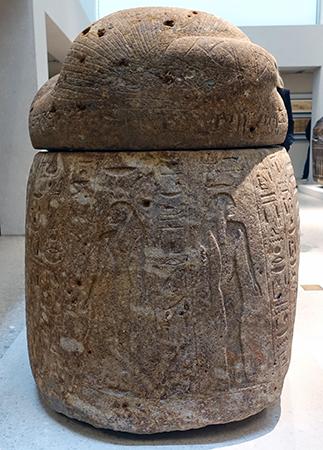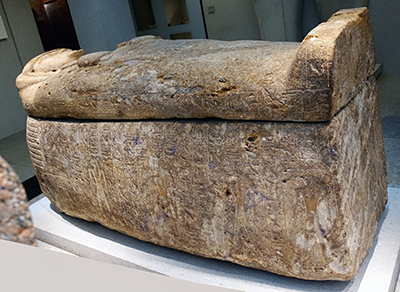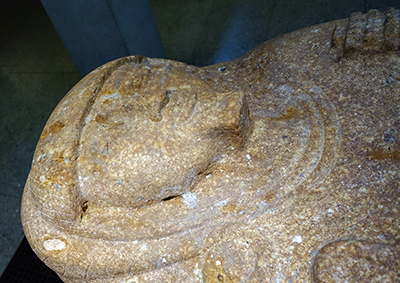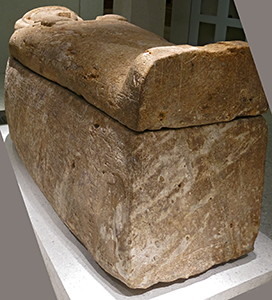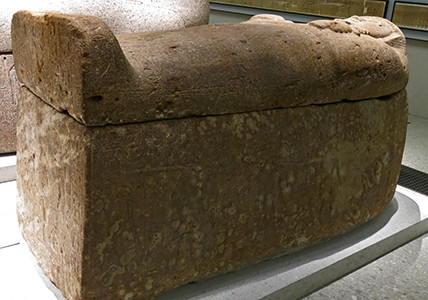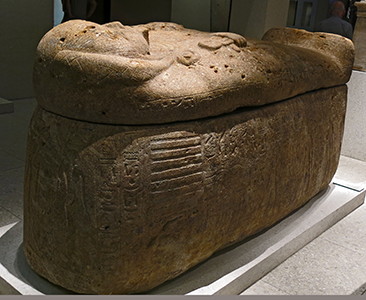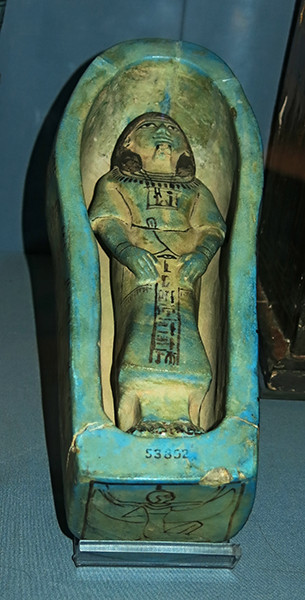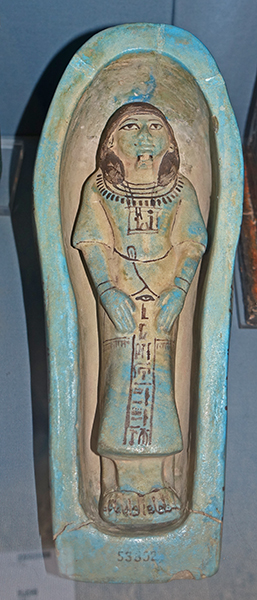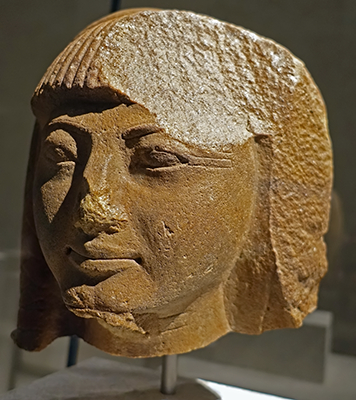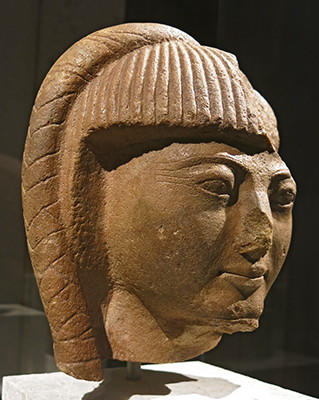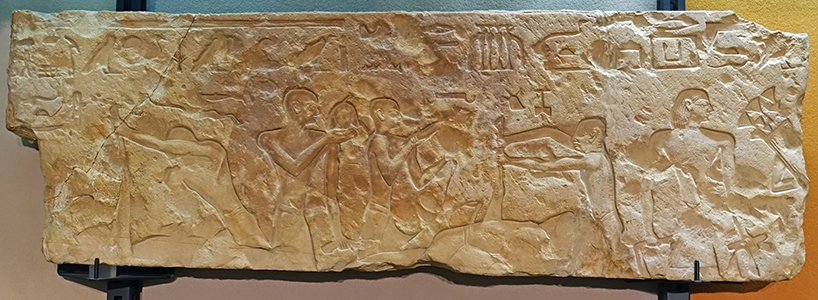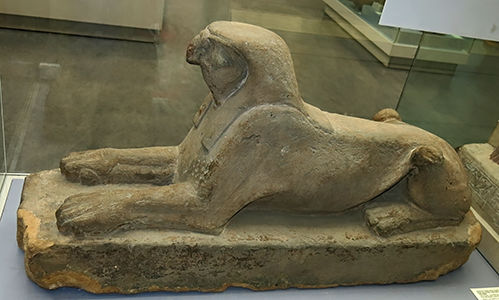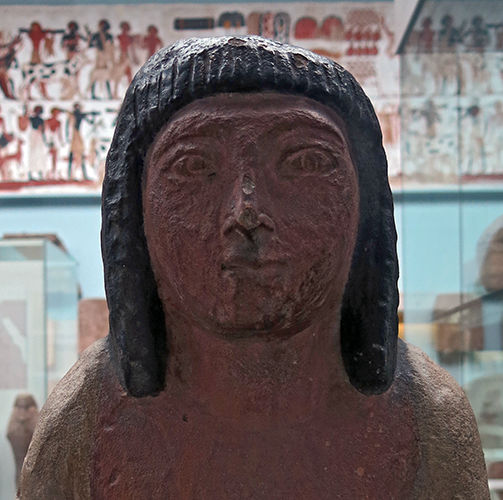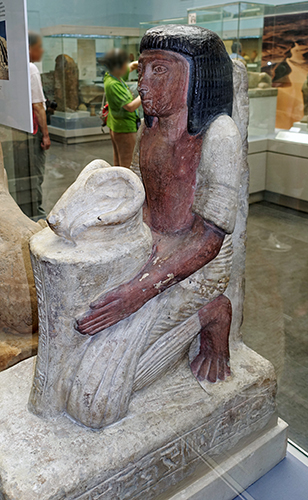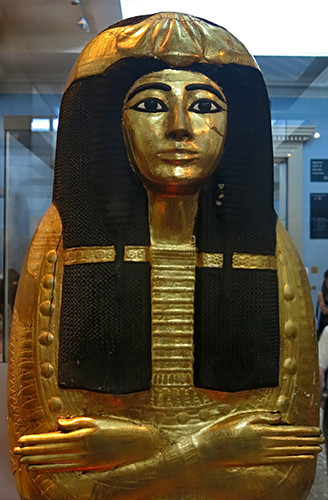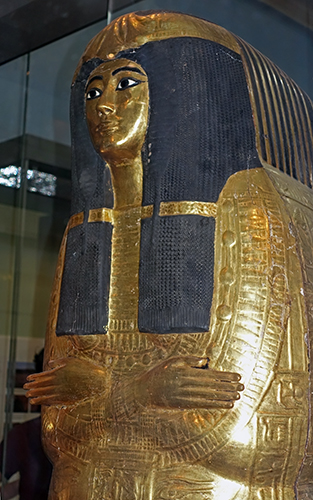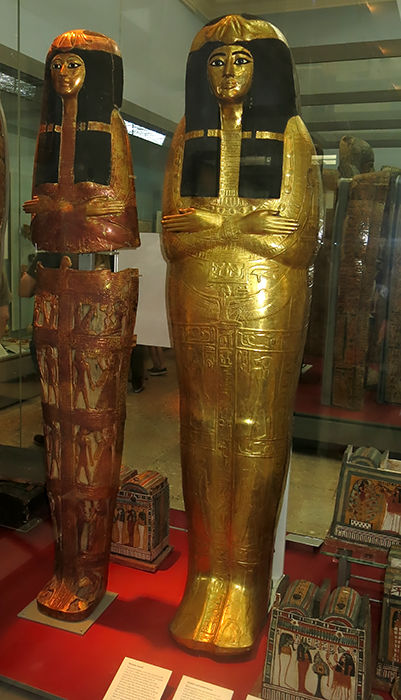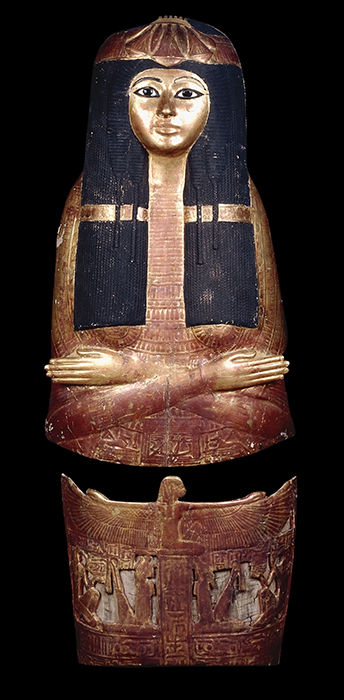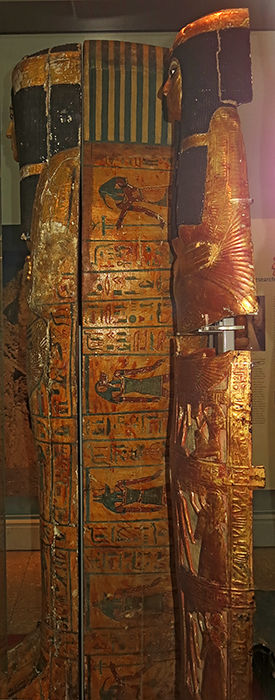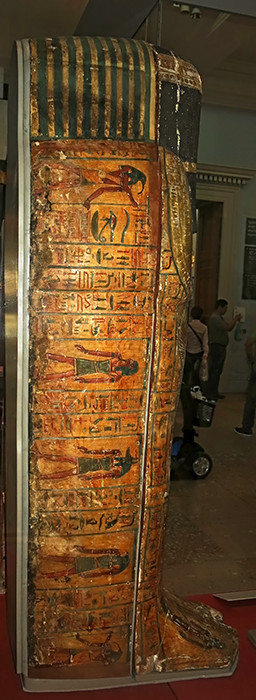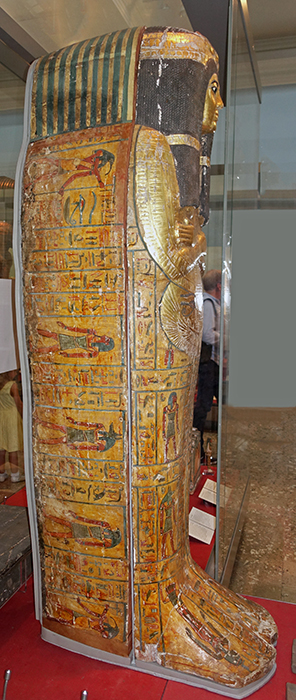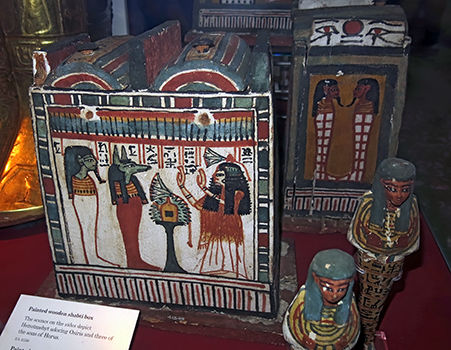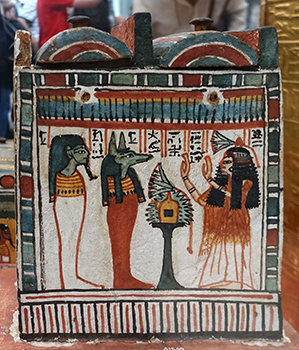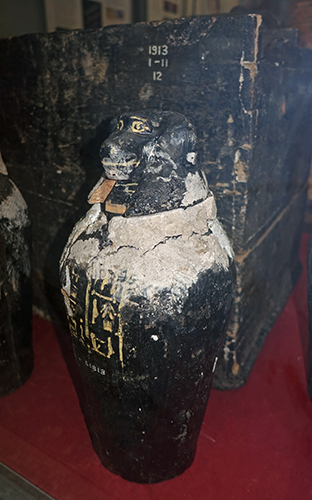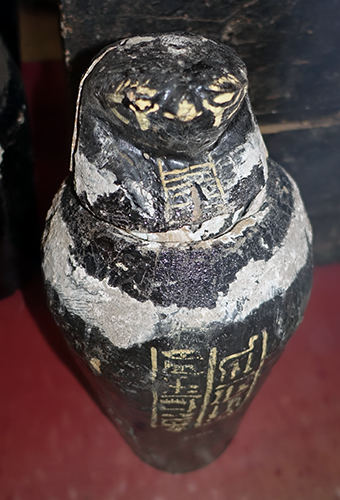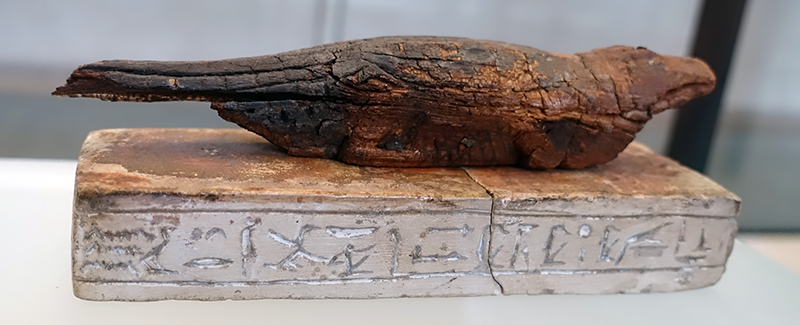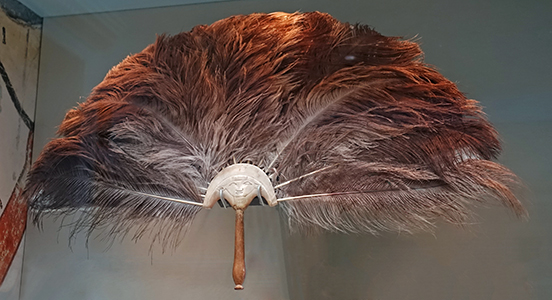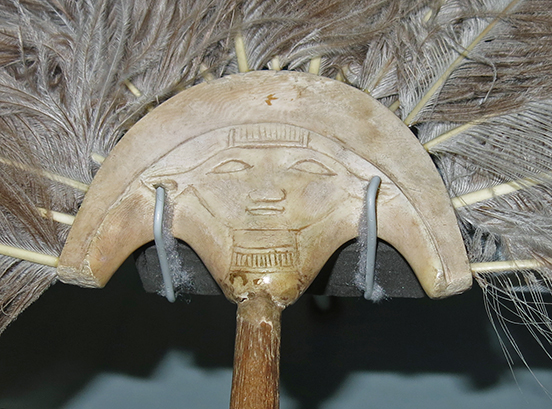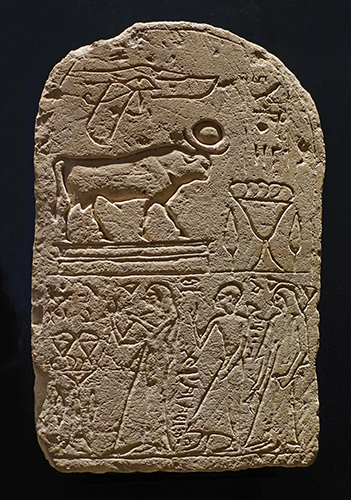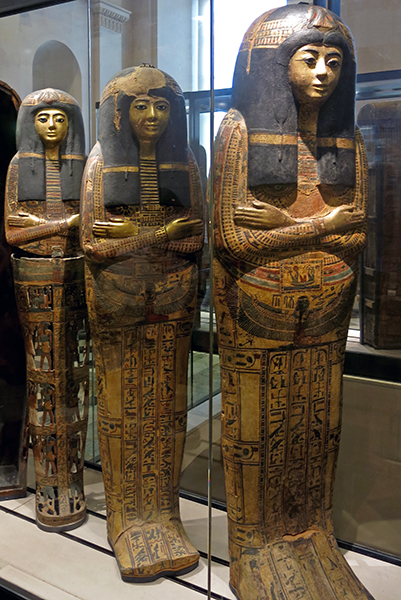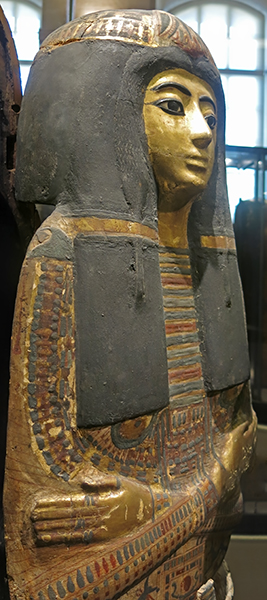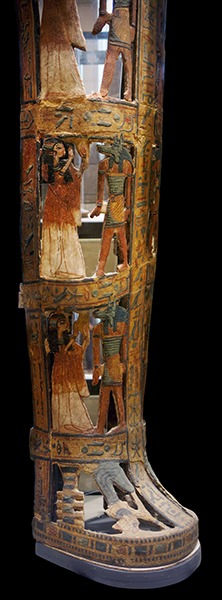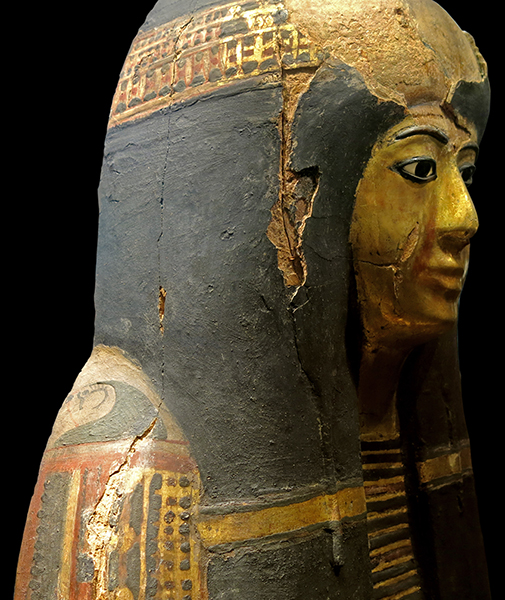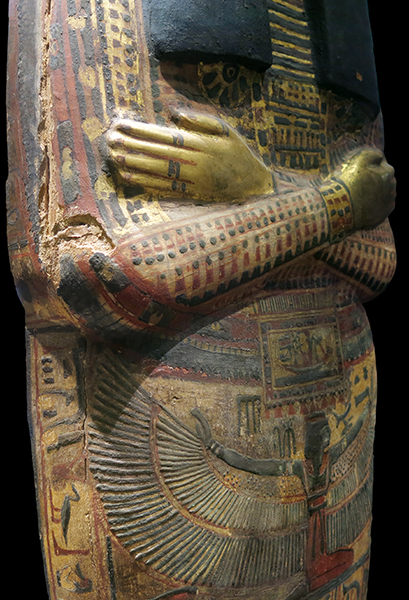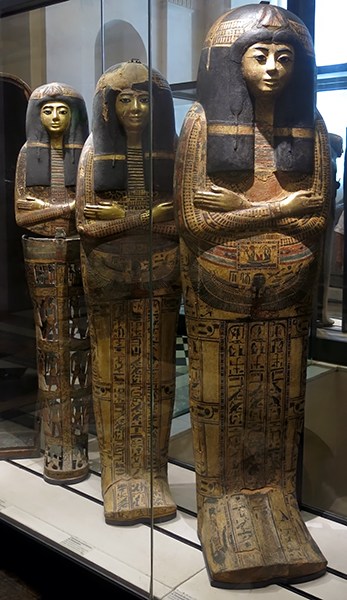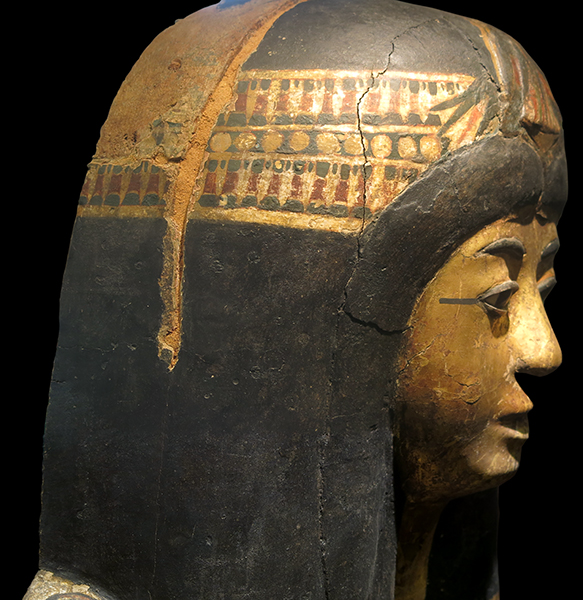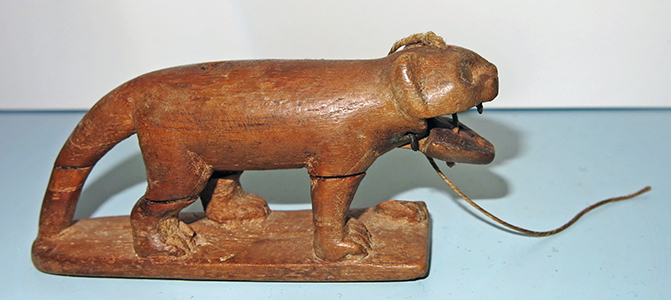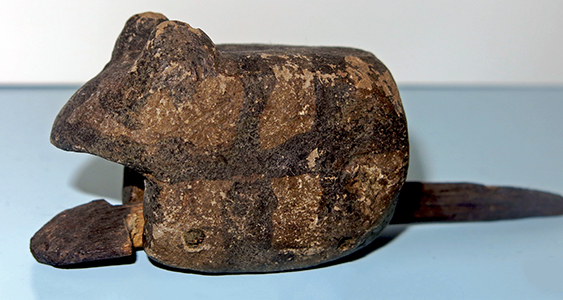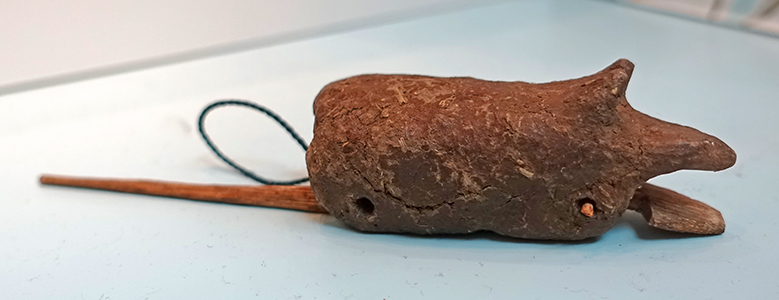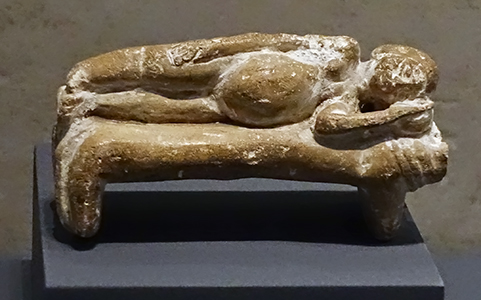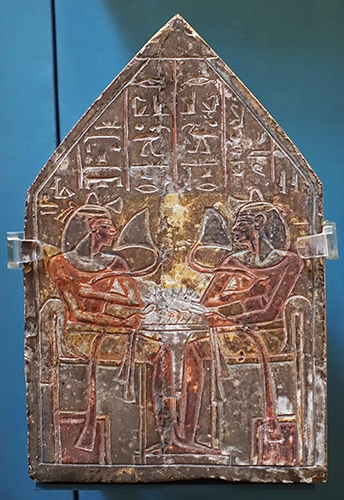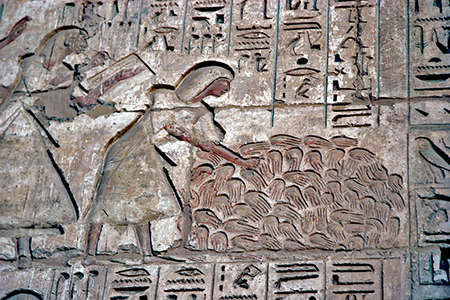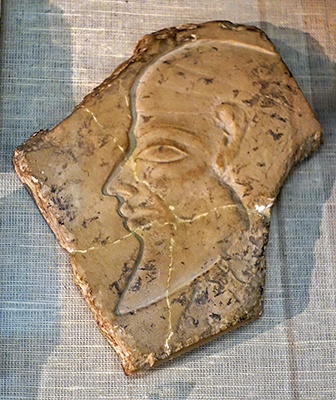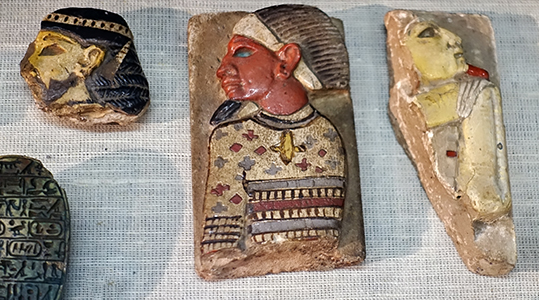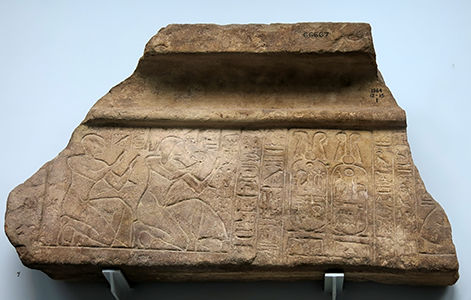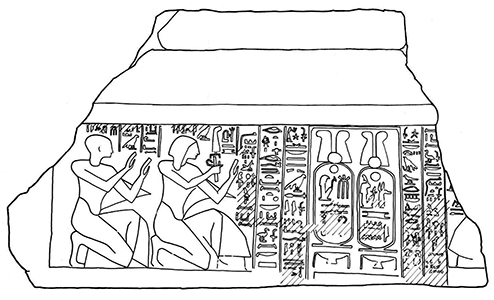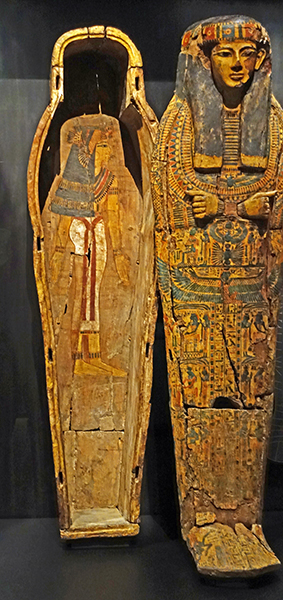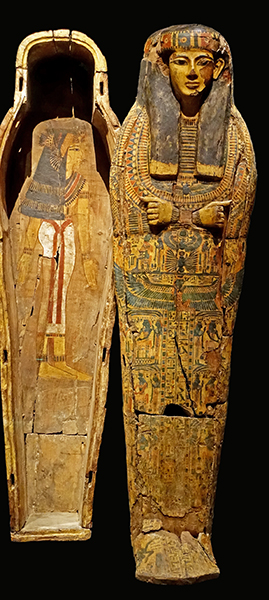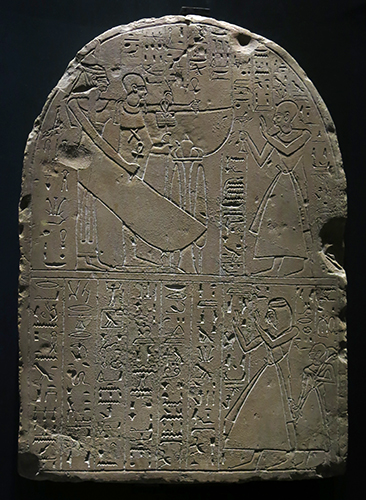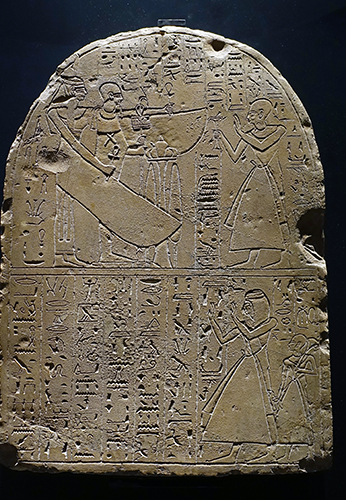Back to Don's Maps
 Back to Archaeological Sites
Back to Archaeological Sites
 Back to Egypt Index Page
Back to Egypt Index Page
Ancient Egyptian culture from the 19th Dynasty to the end of the 20th Dynasty,
the New Kingdom, in 1077 BC, at the end of the reign of Ramesses XI.
Egyptian Chronology
| Egyptian Chronology | ||
|---|---|---|
| Date | Culture | Duration |
| 11 000 BC | Jebel Sahaba | |
| Before 8 000 BC - Palaeolithic in Europe and Northern Asia | ||
| 8 000 BC - Nominal end of the Ice Age | ||
| 8 600 - 4 400 BC | Nabta Playa Neolithic | 4 200 years |
| 6 100 - 5 180 BC | Qarunian (formerly known as Fayum B) | 920 years |
| 5 200 - 4 200 BC | Fayum A | 1 000 years |
| 4 800 - 4 200 BC | Merimde | 600 years |
| 4 600 - 4 400 BC | El Omari | 200 years |
| 4 400 - 4 000 BC | Badarian | 400 years |
| 4 000 - 3 300 BC | Maadi | 700 years |
| 3 900 - 3 650 BC | Naqada I | 250 years |
| 3 650 - 3 300 BC | Naqada II | 350 years |
| 3 300 - 2 900 BC | Naqada III | 400 years |
| 3 100 - 2 670 BC | Early Dynastic | 430 years |
| 2 670 - 2 181 BC | Old Kingdom | 489 years |
| 2 181 - 2 025 BC | First Intermediate Period | 156 years |
| 2 025 - 1 700 BC | Middle Kingdom | 325 years |
| 1 700 - 1 550 BC | Second Intermediate Period | 150 years |
| 1 550 - 1 077 BC | New Kingdom | 473 years |
| 1 077 - 664 BC | Third Intermediate Period | 413 years |
| 664 - 332 BC | Late Period | 332 years |
| 525 - 404 BC | First Persian Period | 121 years |
| 404 - 343 BC | Late Dynastic Period | 61 years |
| 343 - 332 BC | Second Persian Period | 11 years |
| 332 - 305 BC | Macedonian Period | 27 years |
| 305 - 30 BC | Ptolemaic Period | 275 years |
| 30 BC - 395 AD | Roman Period | 425 years |
| 395 AD - 640 AD | Byzantine Period | 245 years |
| 640 AD - 1517 AD | Islamic Period | 877 years |
| 1517 AD - 1867 AD | Ottoman Period (French Occupation 1798-1801) |
350 years |
| 1867 AD - 1914 AD | Khedival Period | 47 years |
| 1914 AD - 1922 AD | Sultanate under Hussein Kamel, as a British Protectorate |
8 years |
| 1922 AD - 1953 AD | Monarchy | 31 years |
| 1953 AD - Present Day | Republic | |
| First to Twentieth Dynasties | |||
|---|---|---|---|
| Date | Dynasty | Period | Duration (years) |
| 3 100 - 2 890 BC | First Dynasty | Archaic/Early Dynastic Period | 214 |
| 2 890 - 2 670 BC | Second Dynasty | Archaic/Early Dynastic Period | 220 |
| 2 670 - 2 613 BC | Third Dynasty | Old Kingdom | 57 |
| 2 613 - 2 494 BC | Fourth Dynasty | Old Kingdom - Golden Age | 119 |
| 2 494 - 2 345 BC | Fifth Dynasty | Old Kingdom | 149 |
| 2 345 - 2 181 BC | Sixth Dynasty | Old Kingdom | 164 |
| 2 181 - 2 160 BC | Seventh and Eighth Dynasties | First Intermediate Period | 21 |
| 2 160 - 2 134 BC | Ninth and Tenth Dynasties | First Intermediate Period | 26 |
| 2 134 - 1 991 BC | Eleventh Dynasty | Middle Kingdom | 43 |
| 1 991 - 1 802 BC | Twelfth Dynasty | Middle Kingdom | 189 |
| 1 802 - 1 649 BC | Thirteenth Dynasty From Memphis, over Middle and Upper Egypt |
Middle Kingdom | 153 |
| 1 805 - 1 650 BC | Fourteenth Dynasty From Avaris, Nile Delta, over Lower Egypt |
Second Intermediate Period | 155 |
| 1 650 - 1 550 BC | Fifteenth Dynasty First Hyksos dynasty, ruled from Avaris, without control of the entire land |
Second Intermediate Period | 100 |
| 1 649 - 1 582 BC | Sixteenth Dynasty Ruled the Theban region in Upper Egypt The Hyksos ruled the delta The Kingdom of Kush ruled Upper Egypt |
Second Intermediate Period | 67 |
| 1 580 - 1 550 BC | Seventeenth Dynasty Ruled Thebes, Hyksos ruled the delta |
Second Intermediate Period / New Kingdom | 30 |
| 1 543 - 1 292 BC | Eighteenth Dynasty Egypt reaches the peak of its power |
New Kingdom | 251 |
| 1 292 - 1 187 BC | Nineteenth Dynasty Conquests in Canaan |
New Kingdom | 105 |
| 1 187 - 1 077 BC | Twentieth Dynasty | End of the New Kingdom | 110 |

Timeline for early Egypt, from 11 000 BC to 2 500 BC.
Photo: Poster, British Museum © Trustees of the British Museum, CC BY-NC-SA 4.0
Rephotography: Don Hitchcock 2015
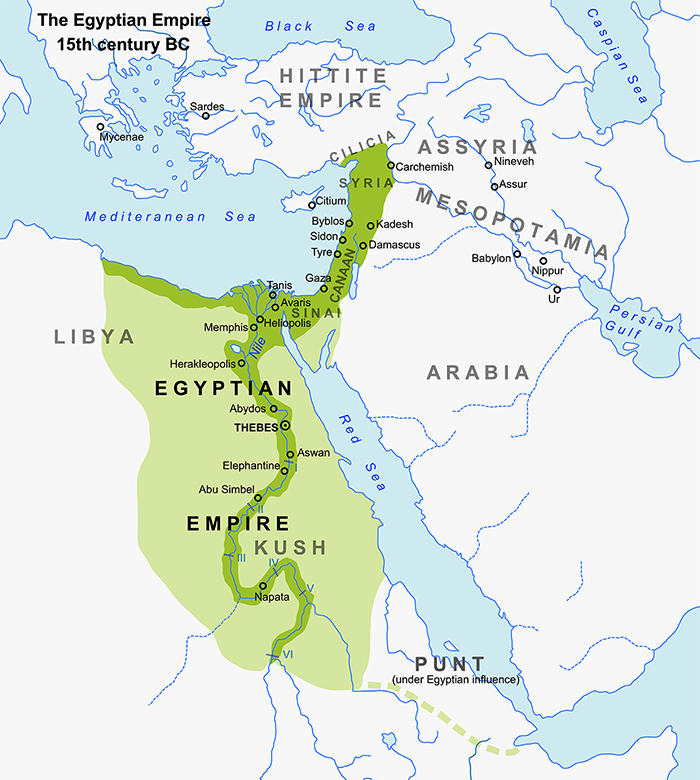
The maximum extent of the New Kingdom during the Eighteenth, Nineteenth, and Twentieth dynasties of Egypt.
Photo: Andrei Nacu, Jeff Dahl
Permission: Creative Commons Attribution-Share Alike 3.0 Unported license.
The Nineteenth Dynasty
1 292 BC - 1 187 BC
The Pharaohs of the 19th dynasty ruled for approximately one hundred and ten years. Seti I's reign is today considered to be 11 years and not 15 years by both J. von Beckerath and Peter Brand, who wrote a biography on this pharaoh's reign. Consequently, it will be amended to 11 years or 1290-1279 BC. Therefore, Seti's father and predecessor would have ruled Egypt between 1292-1290 BC. Many of the pharaohs were buried in the Valley of the Kings in Thebes (designated KV). More information can be found on the Theban Mapping Project website.
| Nineteenth Dynasty | ||||||
|---|---|---|---|---|---|---|
| Name | Horus (Throne) Name | Consort | Burial | Years | Dates | Comments |
| Ramesses I | Menpehtire | Sitre | KV16 | 2 | 1 292 BC - 1 290 BC | |
| Seti I | Menmaatre | (Mut-)Tuya | KV17 | 14 | 1 290 BC - 1 276 BC | |
| Ramesses II, Ramses II, Ozymandias |
Usermaatre Setepenre | Nefertari Isetnofret Maathorneferure Meritamen Bintanath Nebettawy Henutmire |
KV7 | 66 | 1 276 BC - 1 210 BC | Recalibrated date using a solar eclipse mentioned in the OT, Joshua 10:12-14 as well as the Merneptah Stele which mentions a campaign in Canaan in which Merneptah defeated the people of Israel, the first mention of them outside of the Christian Bible. |
| Merneptah | Baenre Merynetjeru | Isetnofret II | KV8 | 7 | 1 210 BC - 1 200 BC | |
| Seti II | Userkheperure | Twosret Takhat Tiaa |
KV15 | 6 | 1 200 BC - 1 197 BC | |
| Amenmesse | Menmire-Setepenre | KV10 | 3 | 1 201 BC - 1 198 BC | ||
| Siptah | Sekhaienre Meryamun/ Akhenre Setepenre |
KV47 | 6 | 1 197 BC - 1 191 BC | ||
| Queen Twosret | Sitre Meritamun | None | KV14 | 4 | 1 191 BC - 1 187 BC | |
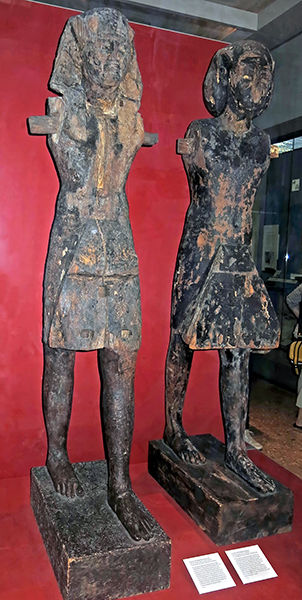

Nineteenth Dynasty: 1 292 BC - 1 187 BC
Ramesses I
Twentieth Dynasty: 1 187 BC - 1 077 BC
Ramesses IX
Centre and right: Statue of King Ramesses I
Height 2007 mm.
The statue is made from the wood of the sycomore fig and was coated with black bitumen. It is one of two life-size statues found in the tomb of Ramesses I. The king wears the bag-like Khat headdress, and would originally have been depicted holding a staff and a mace. Headdress, kilt and other details were originally gilded over a thin layer of gesso, and the eyes and eyebrows were inlaid.
It can be seen from this statue that it is made from separate pieces, notably the arms and the front of the kilt. It is also likely that gilding was placed over certain parts of the statue, but this was stripped off when the tomb was robbed.
Catalog: EA883
Far left: Statue of King Ramesses IX, (also written Ramses) (originally named Amon-her-khepshef Khaemwaset), 1129 BC – 1111 BC was the eighth king of the Twentieth dynasty of Egypt.
Statue from Tomb 6 in the Valley of the Kings. This figure is carved from sycomore fig and represents the king wearing the Nemes Headdress. The surface of this statue was finished using less costly materials than that of Ramesses I. Black paint took the place of resin, and polychrome paint was applied instead of gold leaf. The eyes and eyebrows were carved directly from the wood, instead of being inlaid.
Catalog: EA882
Photo: Don Hitchcock 2015
Source: Original, British Museum
Text: © Card with the display at the British Museum, © Trustees of the British Museum, CC BY-NC-SA 4.0, Wikipedia, http://www.britishmuseum.org/
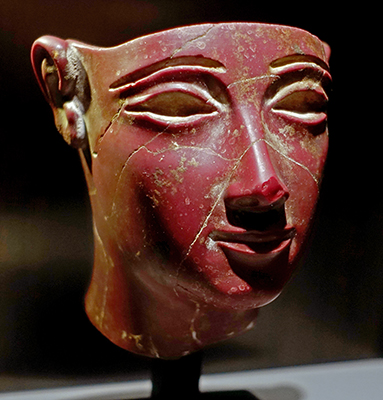
Nineteenth Dynasty: 1 292 BC - 1 187 BC
Seti I
Head from a statue of Seti I, 1 290 BC - 1 276 BC.
Catalog: Jasper, ÄS 7276
Photo: Don Hitchcock 2018
Source: Original, Ägyptischen Museum München
Text: Museum card, © Ägyptischen Museum München
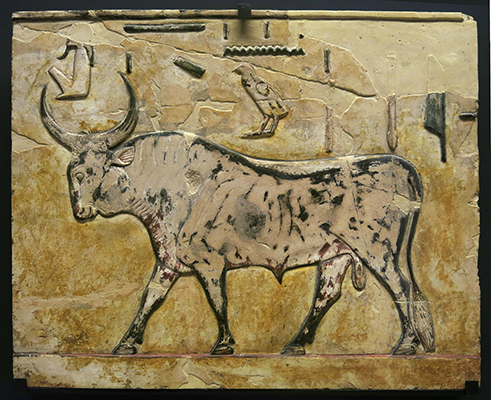
Nineteenth Dynasty: 1 292 BC - 1 187 BC
Apis
Wall relief and painting of Apis, the most important and highly regarded bull deity of ancient Egypt.
Reign of Seti I,
1 290 BC - 1 276 BC.
As with the other sacred beasts, Apis' importance increased over the centuries. During colonisation of the conquered Egypt, Greek and Roman authors had much to say about Apis, the markings by which the black calf was recognised, the manner of his conception by a ray from heaven, his house at Memphis, the mode of prognostication from his actions, his death, the mourning at his death, his costly burial, and the rejoicings throughout the country when a new Apis was found.
Height 360 mm, width 432 mm, thickness 32 mm.
Catalog: Limestone, bas relief, paint, KV 17 Tomb of Sety I, Valley of the Kings, N 3521
Location: Abydos, El-Araba el-Madfouna
Photo: Don Hitchcock 2015
Source and text: Original, Louvre Museum, Paris, France, https://collections.louvre.fr/
Additional text: Wikipedia.
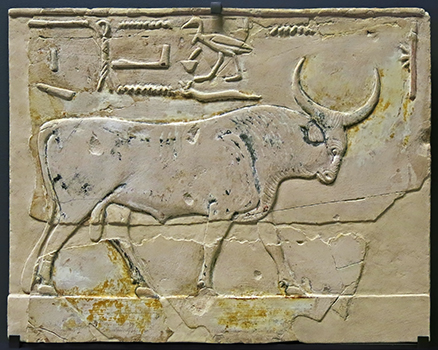
Nineteenth Dynasty: 1 292 BC - 1 187 BC
Apis
Wall relief and painting of Apis, the most important and highly regarded bull deity of ancient Egypt.
Reign of Seti I,
1 290 BC - 1 276 BC.
Worship of an Apis bull, experienced by ancient Egyptians as holy, has been known since the First Dynasty in Memphis, while worship of the Apis as a proper god, at least according to Manetho's Aegyptiaca, seems to be a later adoption, purportedly started during the reign of King Kaiechos (possibly Nebra) of the Second Dynasty.
Apis is named on very early monuments, but little is known of the divine animal before the New Kingdom. Ceremonial burials of bulls indicate that ritual sacrifice was part of the worship of the early cow deities, Hathor and Bat, and a bull might represent her offspring, a king who became a deity after death. He was entitled 'the renewal of the life' of the Memphite deity Ptah: but after death he became Osorapis, i.e. the Osiris Apis, just as dead humans were assimilated to Osiris, the ruler of the underworld.
Apis was the most popular of three great bull cults of ancient Egypt, the others being the cults of Mnevis and Buchis. All are related to the worship of Hathor or Bat, similar primary goddesses separated by region until unification that eventually merged as Hathor. The worship of Apis was continued by the Greeks and after them by the Romans, and lasted until almost 400 AD.
Height 360 mm, width 455 mm.
Catalog: Limestone, bas relief, paint, KV 17 Tomb of Sety I, Valley of the Kings, N 4363
Location: Abydos, El-Araba el-Madfouna
Photo: Don Hitchcock 2015
Source and text: Original, Louvre Museum, Paris, France, https://collections.louvre.fr/
Additional text: Wikipedia.
Nineteenth Dynasty: 1 292 BC - 1 187 BC
Barque
Anuket, seated, on a cubic seat, wearing a robe and the crown of Anuket, a headdress of either reeds or ostrich feathers.
Reign of Seti I, 1 290 BC - 1 276 BC.
Length 395 mm, width 80 mm, depth 170 mm.
Catalog: Painted wood, earthenware crown, gilding, Elephantine, Temple of Satet , E 12710
Location: Salle 324, Le temple, Vitrine 9
Photo: Don Hitchcock 2018
Source and text: Original, Louvre Museum, Paris, France, https://collections.louvre.fr/
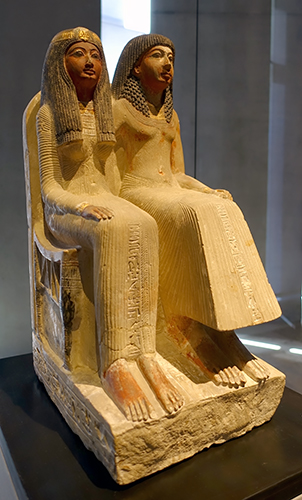
Nineteenth Dynasty: 1 292 BC - 1 187 BC
Neye
Seated figure of the priest Neye and his mother Mutnofret, circa 1 250 BC.
Photo: Don Hitchcock 2018
Catalog: Thebes West, Gl.WAF 25
Source: Original, Ägyptischen Museum München
Text: Museum card, © Ägyptischen Museum München
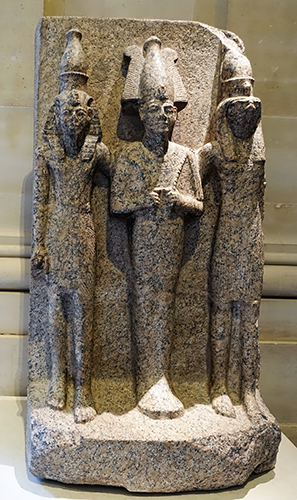
Nineteenth Dynasty: 1 292 BC - 1 187 BC
Statue of a triad
Ramesside period.
Osiris standing, wearing a shroud, atef crown, Usekh necklace, holding a crook and flagellum; king standing, loincloth, uraeus-fringed cloak, nemes headdress, pschent crown, false beard; Horus, god with falcon head, standing, pschent crown.
Height 1300 mm, width 770 mm, depth 670 mm, weight 800 kg.
Catalog: Pink granite, Abydos, El-Araba el-Madfouna, N 12, A 12, LL 75
Location: Aile Sully, Salle 324, Le Temple, not in a vitrine
Photo: Don Hitchcock 2018
Source and text: Original, Louvre Museum, https://collections.louvre.fr/

Nineteenth Dynasty: 1 292 BC - 1 187 BC
Amenhotep Cult Chamber
Amenhotep was an Ancient Egyptian official and chief physician of the early 19th Dynasty. He is mainly known from his decorated tomb chapel that was excavated in 1913/14 by Ahmed Bey Kamal at Asyut, in Middle Egypt.
Amenhotep held several titles, such as king's scribe, chief lector priest, overseer of wab priests of Sakhmet and chief physician. His wife is depicted in the tomb chapel. She was the songstress of Wepwawet and songstress of Amun-Ra Renenutet. His son Yuny is known from a statue found not far away and was also overseer of wab priests of Sakhmet and chief physician. His grandson Khay also held the latter position.
The tomb chapel of Amenhotep was relatively small, perhaps 300 cm long, 152 cm wide and 240 cm high. The ceiling was vaulted. The walls are decorated with a combination of painted, raised and sunken relief. The workmanship is of highest quality.
Photo: Don Hitchcock 2018
Catalog: Valley of the Kings, Thebes West, Limestone, plastered, painted, ÄM 31010/1-4
Source: Original, Staatliche Museen zu Berlin, Neues Museum, Germany
Text: © Card at the Staatliche Museen zu Berlin, (CC BY-NC-SA 3.0 DE)
Additional text: Wikipedia
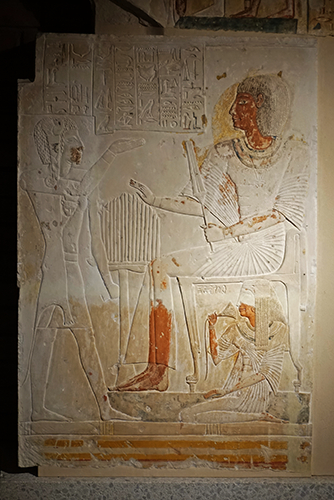
Nineteenth Dynasty: 1 292 BC - 1 187 BC
Amenhotep Cult Chamber
On the back wall, Amenhotep is shown twice sitting at an offering table.
Photo: Don Hitchcock 2018
Catalog: Valley of the Kings, Thebes West, Limestone, plastered, painted, ÄM 31010/1-4
Source: Original, Staatliche Museen zu Berlin, Neues Museum, Germany
Text: © Card at the Staatliche Museen zu Berlin, (CC BY-NC-SA 3.0 DE)
Additional text: Wikipedia
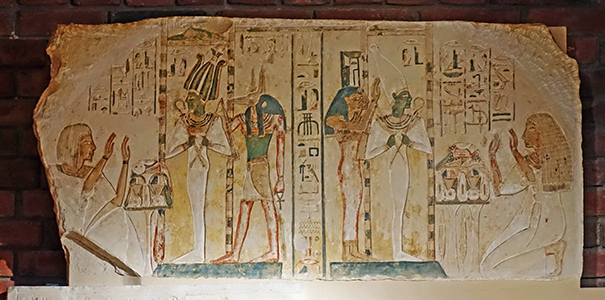
Nineteenth Dynasty: 1 292 BC - 1 187 BC
Amenhotep Cult Chamber
On a second, higher register he is shown twice in front of Osiris.
Photo: Don Hitchcock 2018
Catalog: Valley of the Kings, Thebes West, Limestone, plastered, painted, ÄM 31010/1-4
Source: Original, Staatliche Museen zu Berlin, Neues Museum, Germany
Text: © Card at the Staatliche Museen zu Berlin, (CC BY-NC-SA 3.0 DE)
Additional text: Wikipedia
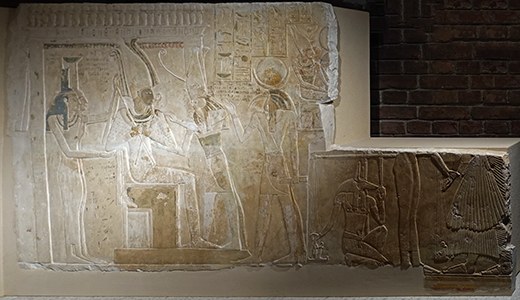
Nineteenth Dynasty: 1 292 BC - 1 187 BC
Amenhotep Cult Chamber
On the right side of the chapel he is again shown in front of Osiris in the judgement scene. On the left wall, Amenhotep and his family are shown guided by Hathor to the sun god Ra and Anubis.
( note that the scene of 'Amenhotep and his family being guided by Hathor to Ra and Anubis' has been attributed to both the right and left wall, depending whether we refer to Wikipedia or the Cleveland Museum of Art. I have been unable to find a plan of the chapel as it was first found. Note also that on the right hand wall of this display, we can see another apparently undescribed, partial panel which clearly shows Anubis weighing the heart of the deceased - Don )
The chapel was found well preserved and even substantial remains of the colouring remained. Today the fragments are in different collections. Substantial parts of the back and the right wall are in the Egyptian Museum of Berlin, the main parts of the left wall are in the Cleveland Museum of Art.
Photo: Don Hitchcock 2018
Catalog: Valley of the Kings, Thebes West, Limestone, plastered, painted, ÄM 31010/1-4
Source: Original, Staatliche Museen zu Berlin, Neues Museum, Germany
Text: © Card at the Staatliche Museen zu Berlin, (CC BY-NC-SA 3.0 DE)
Additional text: Wikipedia
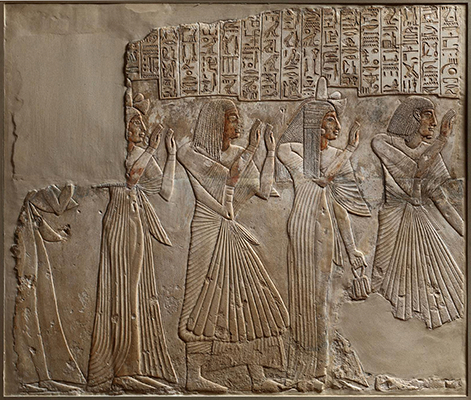
Nineteenth Dynasty: 1 292 BC - 1 187 BC
Amenhotep Cult Chamber
Tomb Relief of the Chief Physician Amenhotep and Family, circa 1 279 BC - 1 257 BC
Ancient Egyptian medicine was held in high esteem, and doctors made a good living. In this scene, the chief physician Amenhotep leads his family in prayer. Arms uplifted in worship, they all wear the intricately styled wigs and elaborately layered, pleated, billowing linen garments that were the height of fashion during the long and prosperous reign of Ramesses II.
Amenhotep's tomb chapel at Asyut was excavated in 1913-14 by the Egyptian Antiquities Service. Its reliefs are now divided among four cities in three countries. The right side of the wall directly adjoining the Cleveland relief is in Zurich, Switzerland. It shows the goddess Hathor taking Amenhotep by the hand and leading him and his family into the presence of the gods. The other sections are in the Toledo Museum of Art and the Egyptian Museum, Berlin, Germany.
Dimensions: 1280 x 1195 mm
Catalog: Limestone with traces of paint, Egypt, Asyut, New Kingdom, Dynasty 19, reign of Ramesses II, 1279-1213 BC
Credit line: Leonard C. Hanna, Jr. Fund
Source and text: https://www.clevelandart.org/art/1963.100#
Permission: Creative Commons (CC0 1.0)
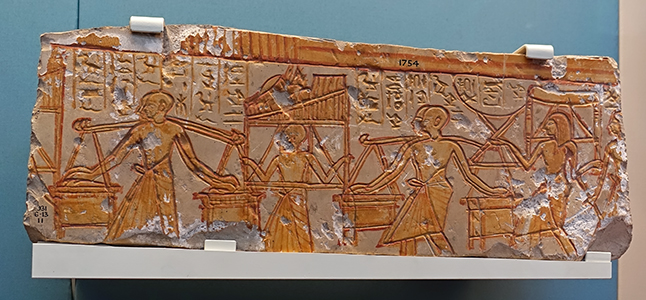
Nineteenth Dynasty: 1 292 BC - 1 187 BC
Stela of Neferabu
Relatives of the deceased carrying funerary goods to the tomb, circa 1 250 BC.
Dimensions: Height 175 mm, length 520 mm.
On this fragment of a limestone stela of Neferabu the dead man's sons and other family members are shown carrying boxes, stools, and other items to the tomb.
Neferabet is the owner of TT5. This stela may have come from this tomb or perhaps one of the shrines at Deir el-Medina. There are a number of other stelae and objects from this tomb in the British Museum.
Catalog: Limestone, Deir el-Medina, Luxor (Thebes), EA1754
Photo: Don Hitchcock 2018
Source: Original, British Museum
Text: © Card with the display at the British Museum, http://www.britishmuseum.org/ , © Trustees of the British Museum, CC BY-NC-SA 4.0
Nineteenth Dynasty: 1 292 BC - 1 187 BC
Book of the Dead of Ani
Book of the Dead of Ani; frame 33; full colour vignettes. Spell 42 rubric; spell 155; spell 156; spell 29b; spell 166; spell 151 (start).
Length 587 mm (frame), width 420 mm (frame)
Titles/epithets include : True Scribe of the King; His Beloved Scribe Reckoning Divine Offerings of All the Gods; Overseer of the Double Granary of the Lord of Tawer Titles/epithets include : Lady of the House; Chantress of Amun.
The pigments are faded, friable, and flaking.
Catalog: Papyrus, black and red ink, Tomb of Ani (Thebes), EA10470,33
Photo: Don Hitchcock 2018
Source: Original, British Museum
Text: © Card with the display at the British Museum, http://www.britishmuseum.org/ , © Trustees of the British Museum, CC BY-NC-SA 4.0
Osirian statuettes
A feature of high-status burials of the 20th - 22nd Dynasties was a wooden figure of the god Osiris. These figures usually contained a cavity, either in the body or in the plinth, into which a rolled funerary papyrus was placed. The figure thus provided both and image of the god of the dead and a location for the essential funerary texts.
Text above: © Card with the display at the British Museum, http://www.britishmuseum.org/ , © Trustees of the British Museum, CC BY-NC-SA 4.0
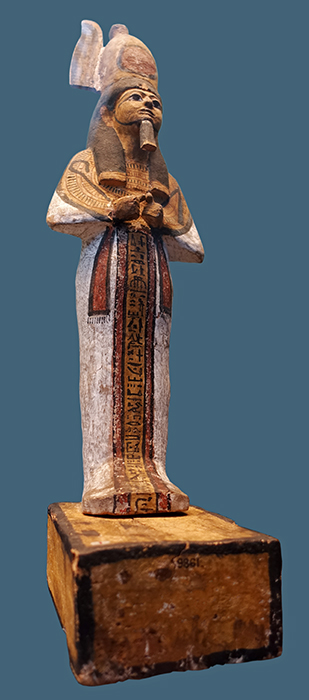
Nineteenth Dynasty: 1 292 BC - 1 187 BC
Figure of Osiris
Figure of Osiris, made for Hunefer, made of wood and painted black, red, yellow, white and green, on a solid pedestal. The figure served as the container for Hunefer's Book of the Dead papyrus (EA 9901).
Height 685 mm, 760 mm. ( Presumably the height of the figure itself and the height of the figure on its plinth - Don )
Inscription translation: prayer for movement in necropolis made to Osiris and Anubis for the Osiris Hunefer.
Curator's comments:
The figure contained the papyrus EA9901.
The description of the figure in the MLA acquisition register (1852,0525,2) ends, 'in right hand bronze whip inlaid with coloured glass.' This implement was associated with the figure as late as 1925 (Budge, The Mummy, 2nd ed., 382; Raven, OMRO 59/60 (1978/79), 252, n. 5), but was later removed. It is probably to be recognised as EA71408 (q.v.).
Catalog: Painted wood, EA9861
Photo: Don Hitchcock 2018
Source: Original, British Museum
Text: © Card with the display at the British Museum, http://www.britishmuseum.org/ , © Trustees of the British Museum, CC BY-NC-SA 4.0
Nineteenth Dynasty: 1 292 BC - 1 187 BC
Magical brick of Djehutymose
Portion of the base of a clay magical brick incised with the text of the eastern quadrant.
Length 115 mm, thickness 20 mm, width 100 mm.
Named in inscription: Djehutymose
Circa 1 295 BC - 1 186 BC
As described in Chapter 151 of the Book of the Dead, four bricks of unbaked mud, each surmounted by an amulet, were to be placed in the burial chamber facing the cardinal points. Their purpose was to repel the forces of evil which might threaten the deceased. This example, inscribed for a man named Djehutymose, was to be located on the east side of the chamber.
Four mud-bricks inscribed with spells from Chapter 151 of the Book of the Dead are often found in the burial chambers of royal and elite tombs dating from the New Kingdom. These bricks can be shown to represent the four bricks that supported women during childbirth. The use of bricks in a mortuary context is thus metaphorical, replicating the equipment of an earthly birth in order to ensure the deceased's rebirth into the other world. Such bricks may also have been used in the 'Opening of the Mouth' ritual, both at funerals and in temple foundation ceremonies. In connection with their role at birth, bricks also appear at the judgment a person faced after death. Like other artefacts surrounding birth in Egypt, bricks of birth had parallels in ancient Mesopotamia.
During the New Kingdom, four magical bricks were often placed in niches in the burial chambers of royal tombs, and in some private tombs and burials of the Apis bull as well. The bricks and their associated figures were preserved in the tomb of Tutankhamun.
Each of these four bricks was associated with one of four amuletic figures: a recumbent jackal on a shrine, a mummiform image, a reed that represented a flame, and a djed pillar. Usually the bricks bore the text of a spell from Chapter 151 of the Book of the Dead.
Catalog: Tomb of Djehutymose (Thebes) (?), EA65845
Photo: Don Hitchcock 2018
Source: Original, British Museum
Text: © Card with the display at the British Museum, http://www.britishmuseum.org/ , © Trustees of the British Museum, CC BY-NC-SA 4.0
Additional text: Roth and Roehrig (2002)
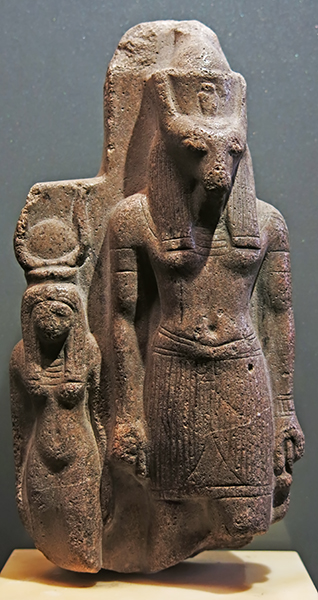
Nineteenth Dynasty: 1 292 BC - 1 187 BC
Seth
The god Seth shown with the head of an animal, arms dangling, with a shining crown, necklace, tripartite wig, loincloth, holding an ankh sign. Nephthys standing, arms dangling, tripartite wig, Usekh necklace.
Reign of Ramses II, 1 276 BC - 1 210 BC.
Seth was the Egyptian god of war, chaos and storms, brother of Osiris, Isis, and Horus the Elder, uncle to Horus the Younger, and brother-husband to Nephthys. His other consort was the goddess Tawaret, a hippo-headed deity who presided over fertility and childbirth.
Height 171 mm, width 89 mm, depth 43 mm.
Catalog: Soapstone, Aile Sully, Le Nil, Salle 336, Vitrine 7, E 3374
Photo: Don Hitchcock 2015
Source and text: Original, Louvre Museum, https://collections.louvre.fr/
Additional text: https://westportlibrary.libguides.com
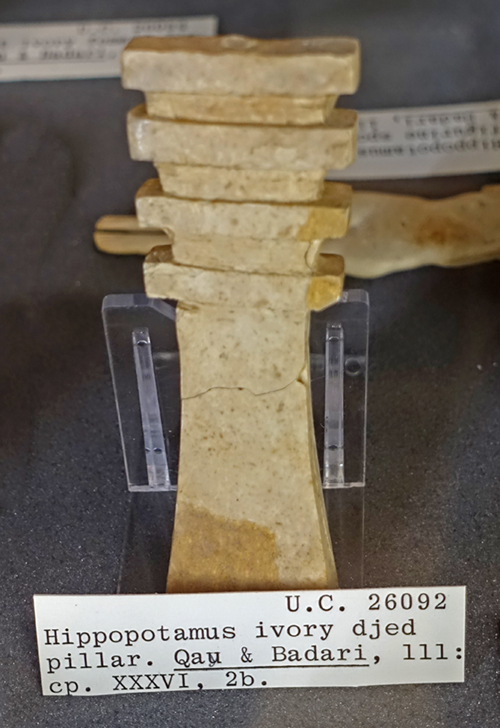
Nineteenth Dynasty: 1 292 BC - 1 187 BC
Djed pillar
Ivory djed pillar, possibly for inlay.
Collected at Qua, Tomb 562, Brunton, Guy, Qau and Badari III, cf. XXXVI, 26
Length 95 mm, top width 35 mm, base width 27 mm, depth 8 mm, Accession Number LDUCE-UC26092.
Photo: Don Hitchcock 2018
Source: Original, Petrie Museum, London, England
Text: Card / online catalogue, the Petrie Museum, © 2015 UCL. CC BY-NC-SA license
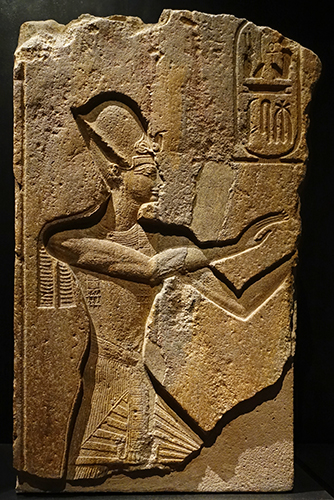
Nineteenth Dynasty: 1 292 BC - 1 187 BC
Ramses II
Temple relief: Pharaoh Ramses II praying.
Circa 1250 BC.
Catalog: Sandstone, Memphis, Gl. 124
Photo: Don Hitchcock 2018
Source: Original, Ägyptischen Museum München
Text: © Ägyptischen Museum München
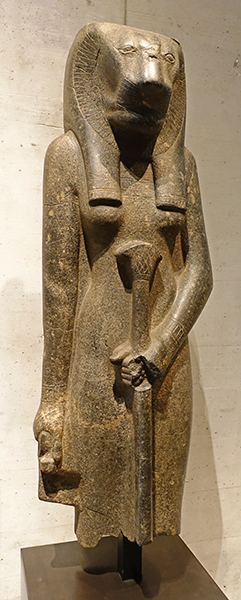
Nineteenth Dynasty: 1 292 BC - 1 187 BC
Sekhmet
Standing figure of the goddess Sekhmet.
Circa 1250 BC.
Catalog: Granite, Karnak, Mut Temple, Gl. 67
Photo: Don Hitchcock 2018
Source: Original, Ägyptischen Museum München
Text: © Ägyptischen Museum München
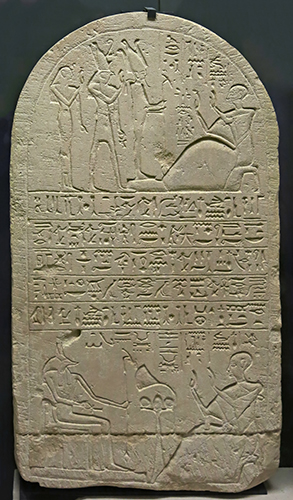
Nineteenth Dynasty: 1 292 BC - 1 187 BC
Arched stele
Reign of Ramses II, 1 276 BC - 1 210 BC.
In the arch: adoration scene. A man kneels, wearing a skirt with a puffed up front, shirt with sleeves, shaved head, adoring.
Osiris stands on a pedestal, Horus is shown with a hawk's head, and wearing the Pschent crown. Isis is standing behind, wearing a tripartite wig and a uraeus.
Below the hieroglyphics is another adoration scene, with a man kneeling with a puffed up skirt, sleeved shirt, shaven head, and in the adoring posture.
Below an adoration scene. A man is kneeling, wearing a puffed-up skirt, sleeved shirt, shaven head, and adoring Wepwawet, a dog-headed god, a war deity, seated.
Names and titles: Ounennefer, first servant of the god of Isis, Iyouyou, father, first servant of the god of Osiris, Osiris.
Height 850 mm, width 485 mm.
Catalog: Limestone, sunken bas-relief, Aile Sully, Salle 323, Crypte d'Osiris, Vitrine 9, N 249, C 98, LP 1678, Mimaut n° 411
Location: Abydos, El-Araba el-Madfouna
Photo: Don Hitchcock 2015
Source and text: Original, Louvre Museum, Paris, France, https://collections.louvre.fr/
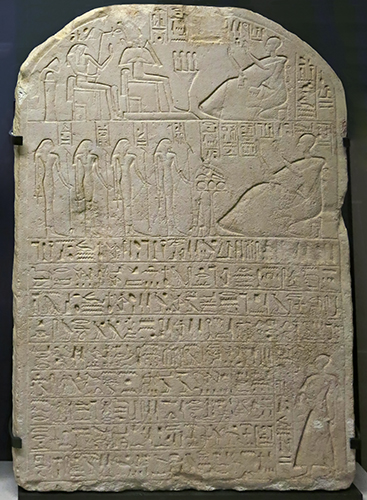
Nineteenth Dynasty: 1 292 BC - 1 187 BC
Arched stele
Reign of Ramses II, 1 276 BC - 1 210 BC.
In the arch: adoration scene. A man kneels, wearing a skirt, shirt with sleeves, panther skin, shaved head, worshipping. Before him on the left is a seated Osiris, and the hawk headed Horus, son of Isis. The four sons of Horus stand on a lotus flower.
In the register below is a kneeling man worshipping, before an offering table heaped with offerings, with four goddesses on the left, standing, wearing tripartite wigs, each holding an ankh and a Was sceptre.
Below at the right is a man with shaved head standing, wearing a skirt and panther skin.
Height 1000 mm, width 700 mm, thickness 100 mm.
Catalog: Limestone, sunken bas-relief, Aile Sully, Salle 323, Crypte d'Osiris, Vitrine 9, E 582, C 219, N 321
Location: Abydos, El-Araba el-Madfouna
Photo: Don Hitchcock 2015
Source and text: Original, Louvre Museum, Paris, France, https://collections.louvre.fr/
Nineteenth Dynasty: 1 292 BC - 1 187 BC
Bakenkhonsu
Block statue of the High Priest of Amun, Bakenkhonsu
Originally sculpted in the late 18th dynasty, circa 1 320 BC, it was used again during the 19th dynasty, circa 1 220 BC, during the reign of Ramesses II.
Bakenkhonsu ('Servant of Khonsu') was a High Priest of Amun in ancient Egypt during the reign of Pharaoh Ramesses II, 1 276 BC - 1 210 BC. Information about his life was found on the back of this block statue. The information on the statue provides details about the education of young Egyptian noblemen at that time and the career of priests.
According to the information inscribed on his statue, Bakenkhonsu was the son of Ipui, a priest of Amun (other sources suggest that he was the son of Roma, whose wife was also called Roma). His two younger brothers were Roma-Roi and Ipui. He spent four years at school, starting at the age of four, as was customary at that time. He then worked at the stables of Pharaoh Seti I for eleven years. There he learned to shoot with a bow and to drive a chariot. It is possible that he also served in the Pharaoh's army.
Bakenkhonsu's career as a priest then began when he joined Amun's priesthood in Thebes where his father already served as a priest (Ipui later became Second Prophet of Amun). Bakenkhonsu served as a wab priest (lowest priestly rank) for four years. He was then promoted to the rank of prophet and, twelve years later, he was the Third Prophet of Amun, the third highest ranking priest in the most powerful priesthood of the era. Later he was promoted to second, then to first prophet or high priest, a position he held for twenty-seven years. He died in the last regnal year of Ramesses II, at the age of ninety, and was succeeded as High Priest by his brother Roma-Roi.
Bakenkhonsu was responsible for several building projects for the Pharaoh , including the eastern temple in the Karnak Temple complex.
Bakenkhonsu was married to Meretseger, who held the titles of Chief of the Harem of Amun. Two of their sons, Paser and Amenmesse became governors of Thebes. Their daughter, Nefertari married Tjanefer, the Third Prophet of Amun and three of her sons and a grandson became high ranking priests (fourth, third, or second prophets of Amun). The family is related to another important family of priests which included Ramessesnakht, who was High Priest of Amun during the 20th dynasty, as Nefertari's son Amenemopet married Ramessesnakht's daughter Tamerit/Aatmerit.
Bakenkhonsu was buried in TT35 in Thebes. In the hallway there are several depictions of Bakenkhonsu and his wife Meretseger. A niche contains seated statues of Bakenkhonsu and his wife. The tomb also had a pyramid associated with it.
Catalog: Limestone, Thebes, Karnak, Gl. WAF 38
Photo: Don Hitchcock 2015, 2018
Source: Original, Ägyptischen Museum München
Text: Museum card, © Ägyptischen Museum München
Additional text: Wikipedia
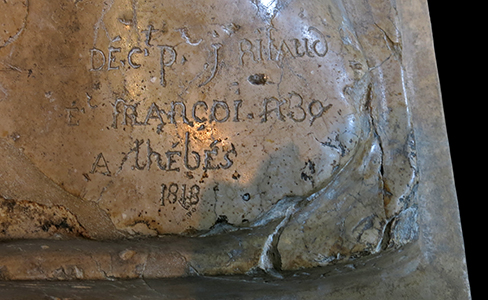
Nineteenth Dynasty: 1 292 BC - 1 187 BC
Bakenkhonsu
Carving on the block statue of the High Priest of Amun, Bakenkhonsu
This modern carving on the foot of the statue shown above has been done carefully, but not by a skilled mason. It would appear that the statue was found in 1818.
Catalog: Limestone, Thebes, Karnak, Gl. WAF 38
Photo: Don Hitchcock 2015
Source: Original, Ägyptischen Museum München
Text: Museum card, © Ägyptischen Museum München
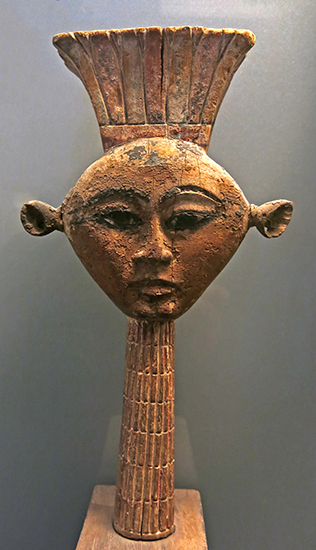
Nineteenth Dynasty: 1 292 BC - 1 187 BC
Anuket
Anuket was usually depicted as a woman with a headdress of either reed or ostrich feathers. She was often shown as holding a sceptre topped with an ankh, and her sacred animal was the gazelle. She was also shown suckling the pharaoh through the New Kingdom and became a goddess of lust in later years, and was associated with the cowrie shell, which resembled the vagina.
Ceremonially, when the Nile started its annual flood, the Festival of Anuket began. People threw coins, gold, jewelry, and precious gifts into the river, in thanks to the goddess for the life-giving water and returning benefits derived from the wealth provided by her fertility. The taboo held in several parts of Egypt, against eating certain fish which were considered sacred, was lifted during this time, suggesting that a fish species of the Nile was a totem for Anuket and that they were consumed as part of the ritual of her major religious festival
Height 275 mm, width 135 mm, depth 126 mm.
Catalog: Painted tamarisk wood, Deir el-Medina, West Thebes, Aile Sully, salle 336, Le Nil, Vitrine 7, N 3534, Salt n°559
Photo: Don Hitchcock 2015
Source and text: Original, Louvre Museum, Paris, France, https://collections.louvre.fr/
Additional text: Wikipedia
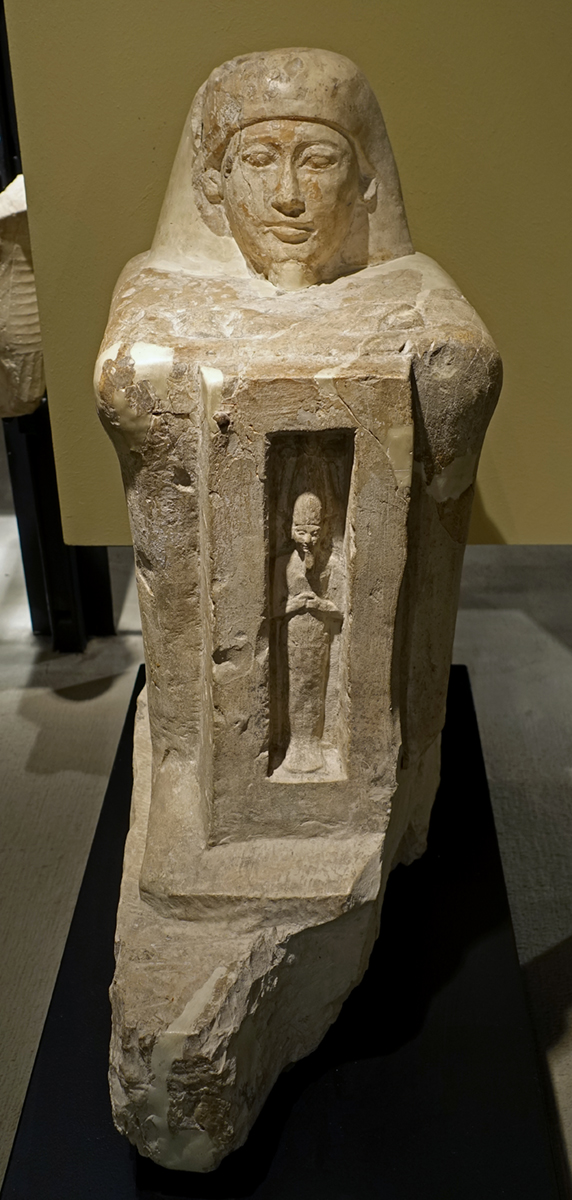
Nineteenth Dynasty: 1 292 BC - 1 187 BC
Pa-sh
Limestone statue of Pa-sh (i.e. 'He from the Lake')
New empire, around 1200 BC.
The 'Royal Scribe and General' Pa-sh crouches behind a shrine with a statuette of Osiris.
Inv. No. 2947
Photo: Don Hitchcock 2018
Source and text: Original, Museum August Kestner, Hannover

Nineteenth Dynasty: 1 292 BC - 1 187 BC
General of Ramses II
Thot depicted as a baboon protects a general of Ramses II, circa 1 279 BC - 1 213 B
Catalog: Basalt, Sully, Rez-de-chaussée, L'écriture et les scribes, Salle 335, Vitrine 5 : Les dieux qui patronnent l'écriture, E 25398
Photo: Don Hitchcock 2018
Source and text: Original, Louvre Museum, Paris, France
Additional text: http://cartelfr.louvre.fr/cartelfr/visite?srv=car_not_frame&idNotice=3389&langue=fr
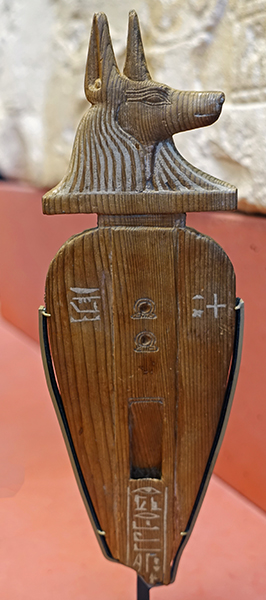
Nineteenth Dynasty: 1 292 BC - 1 187 BC
Pseudo palette
Pseudo palette of Bakenkhonsou, high priest of Amon.
Reign of Ramses II, painted wood. In the form of a vase with the head of Anubis, it is certainly destined for the tomb.
The object names Bakenkhonsu as nobleman, prince, father of the god loved by the god (?), first servant of the god of Amun.
Height 200 mm, width 62 mm, thickness 9 mm.
Catalog: Wood, (yew, jujube tree), Aile Sully, Room 335 - Writing and Scribes, Vitrine 2
N 3018
Photo: Don Hitchcock 2018
Source and text: Original, Louvre Museum, Paris, France
Additional text: http://cartelfr.louvre.fr/cartelfr/visite?srv=car_not_frame&idNotice=3389&langue=fr
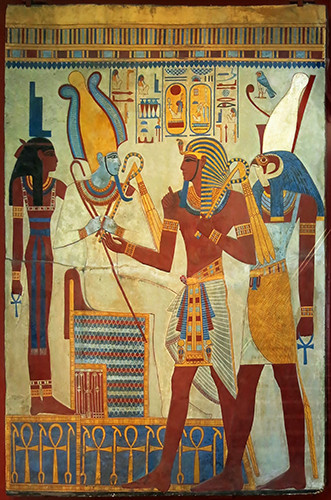
Nineteenth Dynasty: 1 292 BC - 1 187 BC
Seti I
Cast from the Tomb of King Sety I
Valley of the Kings, Egypt
Tomb carved 1 290 - 1 279 BC.
Cast made by Joseph Bonomi 1824 - 1834.
Catalog: Hay Collection AES
Photo: Don Hitchcock 2015
Source: Original, British Museum
Text: Card at the British Museum, © Trustees of the British Museum, CC BY-NC-SA 4.0
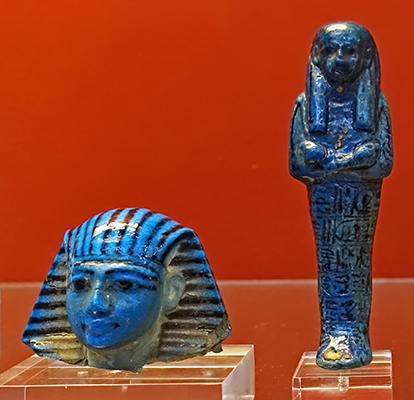
Nineteenth Dynasty: 1 292 BC - 1 187 BC
Seti I
Faience shabtis of Sety I.
Circa 1 292 BC - 1 279 BC
Left: EA9216: Blue glazed composition head of a shabti of Sety I, representing the king wearing the striped 'nemes' headcloth, here without the uraeus serpent which usually rears up at the brow.
Dimensions: Height 58 mm, width 78 mm, depth 57 mm.
Among the hundreds of shabtis that were placed in the tomb of Sety I, there was also a series of larger figures of high quality. These were of glazed composition and are distinguished by their skilful modelling and the excellent quality of their blue glaze. None of the surviving examples have votive texts mentioning officials, yet the possibility exists that they were gifts to the king, in the manner of the fine shabtis of Tutankhamun. It is to one of these larger shabtis that this head belonged.
From more complete examples it can be deduced that the king also wore an elaborate collar and bracelets, and grasped two hoes in his crossed hands. The standard shabti-spell would have been inscribed in horizontal lines around the body and legs.
Right: EA8896: Blue glazed composition shabti of Sety I with black detail: a striated lappet-wig, a modelled face and crossed hands in relief holding two hoes; six rows of Hieroglyphic text on the leg section; seed-basket on the back.
Dimensions: Height 138 mm, width 43 mm, depth 29 mm.
Catalog: Blue faience, Biban el-Muluk (Valley of the Kings - Thebes), Tomb of Sety I, EA9216, EA8896
Photo: Don Hitchcock 2015
Source: Original, British Museum
Text: Card at the British Museum, http://www.britishmuseum.org/, © Trustees of the British Museum, CC BY-NC-SA 4.0
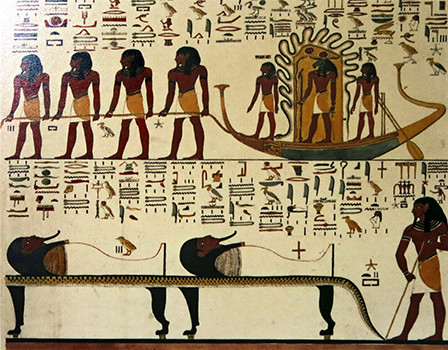
Nineteenth Dynasty: 1 292 BC - 1 187 BC
Sety I
The sun god sailing through the underworld and bringing new life to the mummified dead, from the tomb of Sety I.
Copy made by Henry Salt (1780 - 1827).
Tomb carved 1 290 - 1 279 BC.
Rephotography: Don Hitchcock 2015
Source: Poster, British Museum
Text: Card at the British Museum, © Trustees of the British Museum, CC BY-NC-SA 4.0
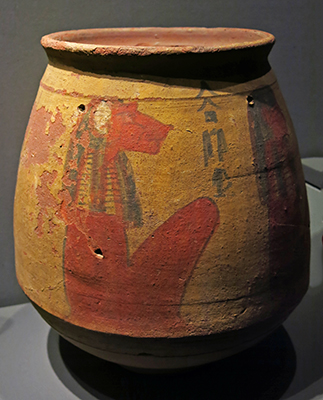
Nineteenth Dynasty: 1 292 BC - 1 187 BC
Container for Ushebtis
Photo: Don Hitchcock 2015
Catalog: Ceramic, Abydos, ÄS 6935
Source: Original, Ägyptischen Museum München
Text: Museum card, © Ägyptischen Museum München
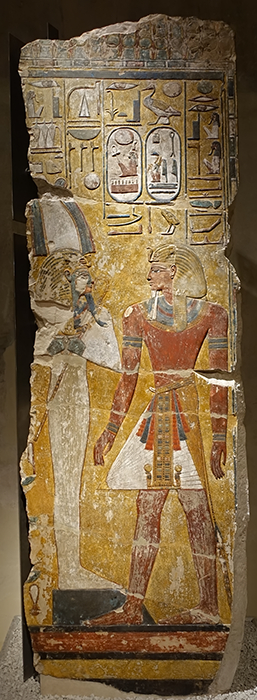
Nineteenth Dynasty: 1 292 BC - 1 187 BC
Seti I
King Seti I in front of the God Osiris. Fragment of a pillar. Limestone. New Kingdom. 19th Dynasty. 1290 BC. Grave of Seti I.
Dimensions: 261 x 88 x 47 cm
Seti I (KV 17), Hall J, Pillar B, Side a (Grave)
Photo: Don Hitchcock 2018
Catalog: Valley of the Kings, Thebes West, Limestone, plastered, painted, ÄM 2058
Source: Original, Staatliche Museen zu Berlin, Neues Museum, Germany
Text: © Card at the Staatliche Museen zu Berlin, http://www.smb-digital.de/ (CC BY-NC-SA 3.0 DE)
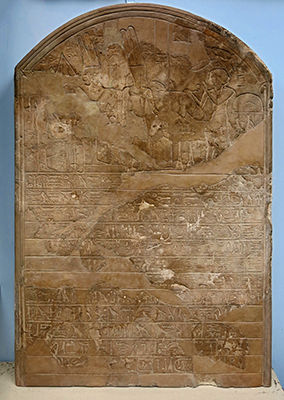
Nineteenth Dynasty: 1 292 BC - 1 187 BC
Sandstone stela of Pharaoh Seti I (also Sety I), circa 1 310 BC
This fragmentary round-topped stela consists of twelve horizontal lines of text below a main scene. All texts are incised and all figures are in sunk relief. Sety I is shown on the right of the scene with one arm raised and the other holding an incense-burner. In front of him are two altars on which rest water-pots cooled by lotus-flowers. Facing him are Amun-Ra, Min-Kamutef and Isis. This stela has been broken into several fragments and has been restored in modern times. The surviving portions are worn and chipped in places. There are no traces of colour. The hieroglyphs describe Seti's decision to endow the temple at Buhen with offerings, priests and servants.
Height: 1265 mm, width 830 mm.
Condition is fair, though incomplete. This stela has been broken into several fragments and has been restored in modern times. The surviving portions are worn and chipped in places.
Buhen was an ancient Egyptian settlement situated on the West bank of the Nile below (to the North of) the Second Cataract in what is now Northern State, Sudan. It is now submerged in Lake Nasser, Sudan. On the East bank, across the river, there was another ancient settlement, where the town of Wadi Halfa now stands. The earliest mention of Buhen comes from stelae dating to the reign of Senusret I. Buhen is also the earliest known Egyptian settlement in the land of Nubia.
Catalog: From Buhen, EA1189
Photo: Don Hitchcock 2015
Source: Original, British Museum
Text: Card with the display at the British Museum, http://www.britishmuseum.org/, © Trustees of the British Museum, CC BY-NC-SA 4.0
Nineteenth Dynasty: 1 292 BC - 1 187 BC
Amenemope / Amenemopet
Seated figure of the foreman of the craftsmen, Amenemope, and his wife Hathor.
Circa 1 280 BP.
The royal clerk Amenemope sits on an armchair with lion's feet, while his wife Hathor has taken a lower stool that is padded with a pillow. Under her chair is a monkey eating figs. The inscriptions on the separately worked base and on the backrest have been engraved and filled with a yellowish mass. The texts contain sacrificial prayers.
Dimensions: 330 x 181 x 255 mm.
Catalog: Sethos I, Wood, White putty (hieroglyphs), Deir el-Medine, TT 265 (grave), ÄM 6910
Photo: Don Hitchcock 2015, 2018
Source: Original, Staatliche Museen zu Berlin, Neues Museum, Germany
Text: © Card at the Staatliche Museen zu Berlin, F. Seyfried at http://www.smb-digital.de/ (CC BY-NC-SA 3.0 DE)
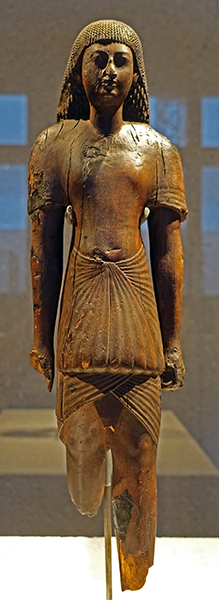

Nineteenth Dynasty: 1 292 BC - 1 187 BC
Unknown Officer
Standing-striding figure of an unknown officer with military kilt.
Circa 1 292 BC - 1 279 BC.
Catalog: Seti I / Sethos I (?), Wood, Thebes, ÄM 10269
Photo: Don Hitchcock 2018
Source: Original, Staatliche Museen zu Berlin, Neues Museum, Germany
Text: © Card at the Staatliche Museen zu Berlin, (CC BY-NC-SA 3.0 DE)
Nineteenth Dynasty: 1 292 BC - 1 187 BC
Shabti of Sety I
(left) Acacia wood shabti of Sety I with a lappet-wig, a modelled face and crossed arms, circa 1 294 BC - 1 279 BC.
The leg section is inscribed with five rows of Hieroglyphic text, there are traces of bitumen, and there is an Inscription from the Book of the Dead inscribed on the shabti.
Dimensions: Height 200 mm, width 66 mm, depth 42 mm.
(centre) Acacia(?) wood shabti of Sety I with a lappet-wig, a modelled face and parallel hands. The leg section is inscribed with five rows of Hieroglyphic text from the Book of the Dead, and there are traces of bitumen.
Dimensions: Height 195 mm, width 57 mm, depth 34 mm.
(right) Wooden shabti of Sety I with a lappet-wig, a modelled face and crossed hands; covered in a layer of bitumen, circa 1 294 BC - 1 279 BC.
Dimensions: Height 201 mm, width 60 mm, depth 40 mm.
Catalog: Wood, Biban el-Muluk (Valley of the Kings - Thebes), Tomb of Sety I, EA8575, EA8578, EA15299
Photo: Don Hitchcock 2018
Source: Original, British Museum
Text: Card with the display at the British Museum, http://www.britishmuseum.org/,© Trustees of the British Museum, CC BY-NC-SA 4.0
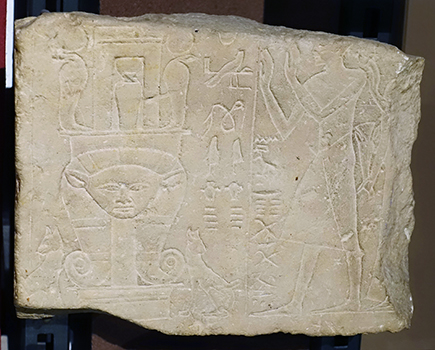
Nineteenth Dynasty: 1 292 BC - 1 187 BC
Hathor
Fragment of a stele, prayer before Hathor emblem, circa 13th Century BC.
Catalog: Limestone, Hermupolis, Inv. Nr. 1935.200.220
Photo: Don Hitchcock 2018
Source and text: Original, Museum August Kestner, Hannover
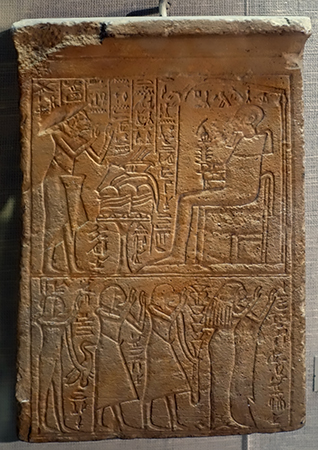
Nineteenth Dynasty: 1 292 BC - 1 187 BC
Tutuja
The officer Tutuja in front of Ptah, circa 1 200 BC.
Catalog: Limestone, probably from Memphis, Inv. Nr. 1935.200.207
Photo: Don Hitchcock 2018
Source and text: Original, Museum August Kestner, Hannover

Nineteenth Dynasty: 1 292 BC - 1 187 BC
Stele of Huy
Stele of Huy, Limestone, possibly from the Sakkara site, circa 1 292 - 1 275 BC.
Huy was a scribe of the treasure house of Pharaoh, presumably in Memphis. On this stone he and his wife worship the god Osiris. On the left his parents and other family members do the same. Among them is included Huy's grandfather, who was still working in the Aten Temple at the time of Akhenaten's revolution. The stele is remarkable for its well-preserved colours.
Photo: Don Hitchcock 2014
Source and text: Original, Rijksmuseum van Oudheden, National Museum of Antiquities, Leiden.
Additional text: Wikipedia
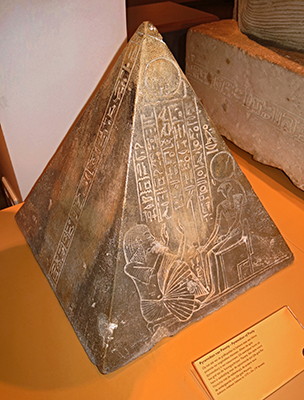
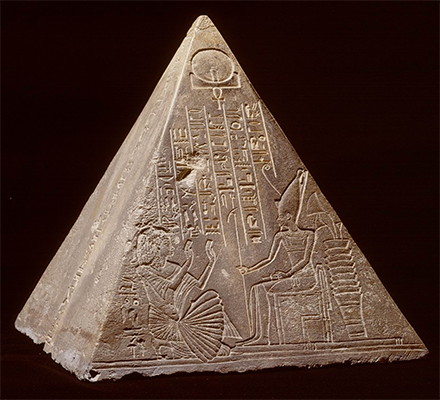
Nineteenth Dynasty: 1 292 BC - 1 187 BC
Pyramidion of Pauty
On the roof of the burial chapels in Saqqara there is a small pyramid of unbaked clay. Only the spire (pyramidion) is made of natural stone. This copy comes from the grave of the 'king writer' Pauty. One side shows him in adoration for the rising sun (the god Re-Horachte with a falcon head), the other for the setting sun (the god Atum).
Catalog: limestone, Saqqara, circa 1 275 BC, AM 7-c
Photo (left): Don Hitchcock 2014
Photo (right): Rijksmuseum van Oudheden
Source and text: Original, Rijksmuseum van Oudheden, National Museum of Antiquities, Leiden, http://www.rmo.nl/
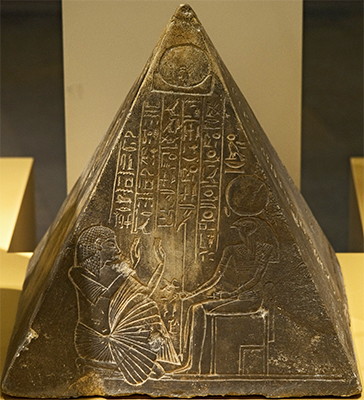
Nineteenth Dynasty: 1 292 BC - 1 187 BC
Pyramidion of Pauty
Dimensions: 470 x 470 x 470 mm.
Weight: circa 60 kg.
A pyramidion is the uppermost piece or capstone of an Egyptian pyramid or obelisk. They were called benbenet in the Ancient Egyptian language, which associated the pyramid as a whole with the sacred benben stone. During Egypt's Old Kingdom, pyramidia were generally made of diorite, granite, or fine limestone, which were then covered in gold or electrum; during the Middle Kingdom and through the end of the pyramid-building era, they were built from granite. A pyramidion was covered in gold leaf to reflect the rays of the sun; during Egypt's Middle Kingdom, they were often inscribed with royal titles and religious symbols.
Very few pyramidia have survived into modern times. Most of those that have are made of polished black granite, inscribed with the name of the pyramid's owner. Four pyramidia – the world's largest collection – are housed in the main hall of the Egyptian Museum in Cairo. Among them are the pyramidia from the so-called Black Pyramid of Amenemhat III at Dahshur and of the Pyramid of Khendjer at Saqqara.
The 19th dynasty (circa Seti I) royal writer Pauty is presumably buried in the Saqqara necropolis as the superstructure of the newlyweds graves there usually contains a small pyramid located at the back of the middle chapel. This clay pyramid is finished with a limestone pyramidion, like the great stone pyramids of the Old Kingdom era of Egypt.
This aspect of the Old Kingdom solar cult was continued in the New Empire, where pyramids have also occurred in a non-royal context ever since. The inscriptions on this copy clarify the association with the solar cult. On the eastern side, Pauty glorifies the rising sun Re-Harakhte, and on the west side, the god Atum, the setting sun on the western horizon. His wife Lyemoenoe is also mentioned. On the north and south side, sacrifices are dedicated to Osiris and Anubis.
Catalog: limestone, Saqqara, circa 1 275 BC, AM 7-c
Photo: Rob Koopman, Wikimedia commons, Creative Commons Attribution-Share Alike 2.0 Generic license.
Source and text: Original, Rijksmuseum van Oudheden, National Museum of Antiquities, Leiden, http://www.rmo.nl/
Additional text: Wikipedia
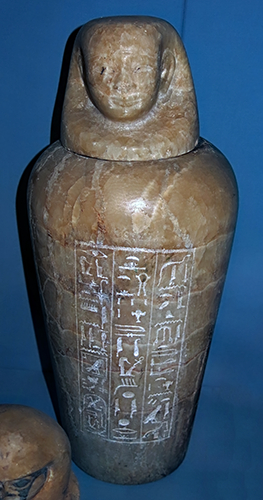
Nineteenth Dynasty: 1 292 BC - 1 187 BC
Queen Mutnodjmet
Calcite canopic jar of Queen Mutnodjmet. Lid in the form of a human head, with three columns of incised Hieroglyphic text on the body including the cartouche of Queen Mutnodjmet. Circa 1 290 BC.
Queen Mutnodjmet appears to have been buried at Saqqara in the tomb which her husband, King Horemheb, had prepared
for himself before his accession to the throne.
Diameter 180 mm, height 410 mm.
Catalog: Calcite, Saqqara, tomb of King Horemheb, EA36635
Photo: Don Hitchcock 2015
Source: Original, British Museum
Text: Card with the display at the British Museum, https://www.britishmuseum.org/, © Trustees of the British Museum, CC BY-NC-SA 4.0
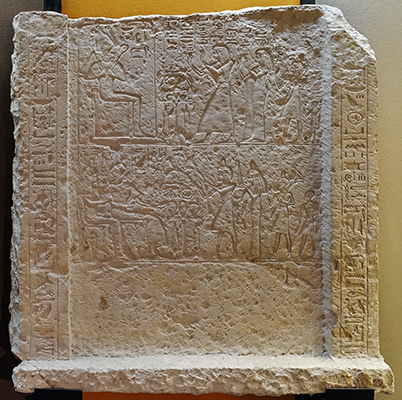
Nineteenth Dynasty: 1 292 BC - 1 187 BC
Stele of Patschu
Stele of the Sculptor Patschu with his family.
Catalog: Limestone, Saqqara (?), Inv. Nr. 1935.200.211
Photo: Don Hitchcock 2018
Source and text: Original, Museum August Kestner, Hannover
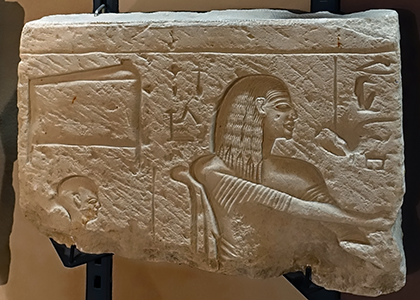
Nineteenth Dynasty: 1 292 BC - 1 187 BC
Relief of Neferher
Catalog: Limestone, Saqqara, Inv. Nr. 1935.200.184
Photo: Don Hitchcock 2018
Source and text: Original, Museum August Kestner, Hannover
Nineteenth Dynasty: 1 292 BC - 1 187 BC
Moses
Two relief blocks from the tomb of Moses, circa 1 240 BC.
Catalog: Limestone, Saqqara, Inv. Nr. 1935.200.190
Photo: Don Hitchcock 2018
Source and text: Original, Museum August Kestner, Hannover
Dating of Egyptian Pharoahs using Astronomical Events
The Egyptians and Assyrians were competent astronomers, and several of their observations have been used to help date various Pharoahs and Dynasties. Pre-telescopic eclipse records are of considerable chronological interest; the total solar eclipse of 15 June 763 BC, for example, was recorded in Assyrian records (Rawlinson (1867) in Humphreys and Waddington (2017)) and is now used as a key fixed point to date Assyrian kings objectively over most of the surrounding three centuries.
Recently a report by Humphreys and Waddington (2017) has allowed the precise dating of Ramesses II, also known as Ozymandias, and as Ramesses the Great.
The researchers write:
A puzzling event in The Bible that mentions both the Moon and the Sun can be interpreted as describing a solar eclipse. We have dated it to 30 October 1207 BC, making it possibly the oldest datable solar eclipse recorded. The Merneptah Stele mentions a campaign in Canaan in which Merneptah defeated the people of Israel.
This enables us to refine the dates of certain Egyptian pharaohs, including Ramesses the Great. It also suggests that the expressions currently used for calculating changes in the Earth's rate of rotation can be reliably extended back 500 years, from 700 BC to 1200 BC.
The map shows the path of the annular solar eclipse of 30 October 1207 BC, which passed directly over the land of Canaan in the afternoon. The shadow leaves the Earth's surface at sunset over modern day Iraq.
The map is centred on Azekah, which is marked with a circle.
The dates agreed by mainstream Egyptologists for the reign of Ramesses II are c. 1279–1213 BC, with his son Merneptah reigning from circa 1213–1203 BC (Shaw 2003, Horning et al. 2006, Kitchen 2013). These dates are subject to some uncertainty, with the latest possible dates for Ramesses II being 1270–1204 BC, and for Merneptah 1204–1194 BC (Kitchen 2013). The fifth year of Merneptah was therefore probably circa 1209/08 BC, with the latest possible date being 1200/1199 BC.
Thus Ramesses II reigned from 1276-1210 BC, with a precision of plus or minus one year, the most accurate dates available.
The standard Egyptian chronology gives the dates of Merneptah as 1213 – 1203 BC, with the latest possible dates being 1204 – 1194 BC. If the confrontation with Israel was in year 4 of the reign of Merneptah, then his reign would have started in 1211/1210 BC, if in year 3, 1210/1209 BC, and if in year 2, 1209/1208 BC.
Hence we can pinpoint the first year of Merneptah as 1210/1209±1 year. As the length of his reign is known from Egyptian texts, his reign would have lasted between 1210 BC and 1200 BC (with ±1 year in each case). The dates of the previous and subsequent pharaohs can be similarly adjusted; for example, the reign-dates of Ramesses II (Ramesses the Great) would be 1276–1210 BC ±1 year.
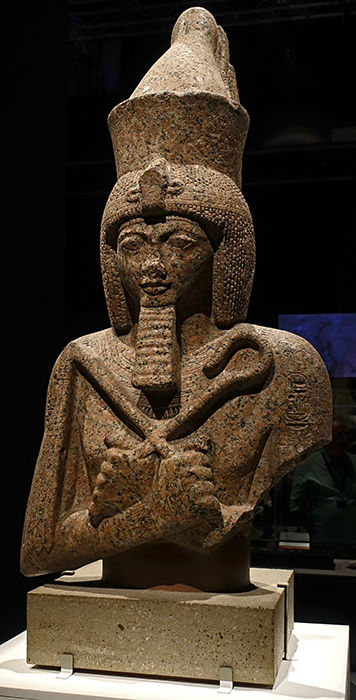
Nineteenth Dynasty: 1 292 BC - 1 187 BC
Ramesses II
Statue of Ramesses II
Temple of Khnum, Elephantine, Egypt, Granite
Dynastic rule began in Egypt in around 3 000 BC. Ramesses II was Pharaoh, King of Egypt, between around 1 279 BC and 1 213 BC. He was an extremely successful ruler, presiding over a golden age of prosperity and imperial power across the kingdom. He founded a new capital city in the north called Pi-Ramesses, 'House of Ramesses II' Here he holds a crook and flail and wears a double crown, symbolising his rule over a united country: Upper and Lower Egypt.
Upper part of a red granite colossal statue of Ramses II: the middle part of the statue has not been found, and the left elbow is broken. Aside from the damage to the nose, the sculpture is in good condition and displays very good workmanship. The surfaces are smoothly polished, with the exception of the band on the forehead, the eyebrows, and the cosmetic bands around the eyes, which were left unpolished, probably to facilitate the application of paint.
Catalog: EA67, 1840, 1114.3, Elephantine, Temple of Khnum
Photo: Don Hitchcock 2017
Text: Card, http://www.britishmuseum.org/, © Trustees of the British Museum, CC BY-NC-SA 4.0
Source: Exhibition by the British Museum at the National Museum of Australia, Canberra
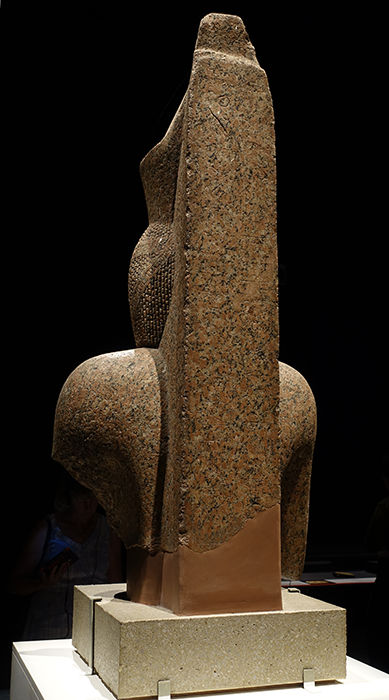
Nineteenth Dynasty: 1 292 BC - 1 187 BC
Ramses II
All the decorated elements of the king's attire are finely chiselled. Ramses II wears a double crown upon a curled wig. The royal uraeus (snake) is fixed at the forehead. A decorated fillet, tied in the back, encircles the wig and ends with two streamers falling on the sides, each supporting a uraeus crowned by the sun disk. A ceremonial beard is attached under the royal chin. A broad collar, fringed by a row of drop-like pearls, surrounds his neck, and a bracelet adorns each of his wrists, the one on the right decorated with an incised 'wedjat' eye, symbol of soundness.
The visage is almost round, with full cheeks. Under the wide forehead, the eyebrows, depicted in raised relief, form two symmetrical arches on the protruding brow-bone. A faint depression separates them from the heavy upper eyelids. The eyes, placed horizontally and framed by cosmetic bands, gaze slightly downward. The narrow root of the nose expands gently toward the base, which is broken. The mouth, slightly slanting, is articulated by well-defined edges. Two little hollows mark the corners of the lips. The rounded chin overlaps the top of the tapering beard. The neck is broad, the chest schematic, with large shoulders. On the arms of the sovereign are engraved his birth and throne names.
Catalog: EA67, 1840, 1114.3, Elephantine, Temple of Khnum
Photo: Don Hitchcock 2017
Text: Card, http://www.britishmuseum.org/, © Trustees of the British Museum, CC BY-NC-SA 4.0
Source: Exhibition by the British Museum at the National Museum of Australia, Canberra
Nineteenth Dynasty: 1 292 BC - 1 187 BC
Ramses II
The statue of Ramesses II has two cartouches on the shoulders.
On the left shoulder: 'Ramesses-meryamun - 'Ra is his creator, beloved of Amuni'.
On the right shoulder: 'Usermaatra-setepenra' - 'Strong in Right is Ra, Chosen by Ra'.
The cartouches are surmounted by a double plume flanking a disk, and placed on the hieroglyphic sign for gold. The back pillar bears two vertical columns of a delicately incised hieroglyphic inscription that ends on the lower part of the statue.
Height 1580 mm (including plinth), width 680 mm, depth 520 mm.
Plinth: Height 150 mm, width 520 mm, depth 520 mm.
Weight 495 kilograms.
Titles/epithets include:
Mighty Bull beloved of Maat (Horus Name)
Who protects Egypt and subdues the foreign countries (Two Ladies' Name)
Rich in years and Great of Victories (Golden Horus Name)
'The perfect god, son of Khnum, and born from Anuket, Lady of Elephantine.'
Catalog: EA67, 1840, 1114.3, Elephantine, Temple of Khnum
Photo: Don Hitchcock 2017
Text: Card, http://www.britishmuseum.org/, © Trustees of the British Museum, CC BY-NC-SA 4.0
Source: Exhibition by the British Museum at the National Museum of Australia, Canberra
Nineteenth Dynasty: 1 292 BC - 1 187 BC
Ramses II / Ramesses II
This is the upper part of a colossal seated statue, one of a pair flanking the entrance to the hypostyle hall in the king's mortuary temple (the 'Ramesseum'). The lower part is still at the Ramesseum, and may be seen in the image below.
The statue was carved from one block, quarried at Aswan almost 200 km further south. Roughly shaped and weighing some 20 tonnes, it was transported on sleds over land and on a purpose-built boat down the river Nile. Once erected, the finer sculpting was completed. Like all Egyptian statues, this was originally painted. Traces of pigment remain: black for the eye pupils, red for the skin, and blue and yellow for the stripes on the headcloth.
Ramesses II erected more colossal statues than any other pharaoh. Those at the Ramesseum are among the finest, showing the technical skills of the sculptors. Ramesses encouraged popular cults in which he was deified. Many of his colossi had their own name and were a focus for prayers.
This statue was saved from almost certain destruction by the Italian explorer, engineer, and amateur archaeologist Giovanni Belzoni, 1778 - 1823.
In early 1810, Belzoni learned from orientalist Johann Ludwig Burckhardt about the Abu Simbel temple in Nubia and the statue of Ramses II, (above) known as the 'Young Memnon' in Luxor. Belzoni first went to Luxor, and with help from the British Consul in Egypt, Henry Salt, unearthed and removed with great skill the colossal bust of the 'Young Memnon' and shipped it to England. This was by no means an easy job, as the statue measured 9 feet high and Belzoni was equipped only with wooden poles and locally-made ropes. Belzoni somehow managed to transport the statue to the Nile River, where an England bound boat was waiting. Many agree that Belzoni probably saved the statue from a certain destruction, since the French had their eye on the statue for some time and had drilled the hole in it (in the right shoulder, as seen above) to remove it with dynamite.
Catalog: Red granite, EA1123
Photo (left, centre): Don Hitchcock 2015, 2018
Photo (right): excellent digital reconstruction using the top part from the British Museum, and the bottom part in situ at the Ramesseum, by Guy de la Bedoyere.
Permission: Creative Commons Attribution 3.0 Unported license.
Attribution: Bedoyere at English Wikipedia
Source: Original, British Museum
Text: Card with the display at the British Museum, https://www.britishmuseum.org/, © Trustees of the British Museum, CC BY-NC-SA 4.0
Additional text: https://www.newworldencyclopedia.org/
Nineteenth Dynasty: 1 292 BC - 1 187 BC
Ramses II / Ramesses II
The Ramesseum is the memorial temple (or mortuary temple) of Pharaoh Ramesses II (Ramesses the Great, also spelled Ramses and Rameses). It is located in the Theban Necropolis in Upper Egypt, on the west of the River Nile, across from the modern city of Luxor.
The name – or at least its French form Rhamesséion – was coined by Jean-François Champollion, who visited the ruins of the site in 1829 and first identified the hieroglyphs making up Ramesses's names and titles on the walls. It was originally called the House of millions of years of Usermaatra-setepenra that unites with Thebes-the-city in the domain of Amon. Usermaatra-setepenra was the prenomen of Ramesses II.
The lower half of the statue of Ramses II shown above may be seen in this photo on the left of this image. On the right of this lower half of the statue above, on the other side of the steps, is the head of the other member of the pair of statues originally flanking the staircase.
Photo: Marc Ryckaert (MJJR)
Permission: Creative Commons Attribution 3.0 Unported license
Text: Card with the display at the British Museum, https://www.britishmuseum.org/, © Trustees of the British Museum, CC BY-NC-SA 4.0
Additional Text: Wikipedia

Nineteenth Dynasty: 1 292 BC - 1 187 BC
Ramses II
Boundary stela of Pharaoh Ramses II smiting his enemies before the god Seth, circa 1 250 BC.
Catalog: Limestone, Wadi Sannur, Gl. 29
Photo: Don Hitchcock 2018
Source: Original, Ägyptischen Museum München
Text: Museum card, © Ägyptischen Museum München
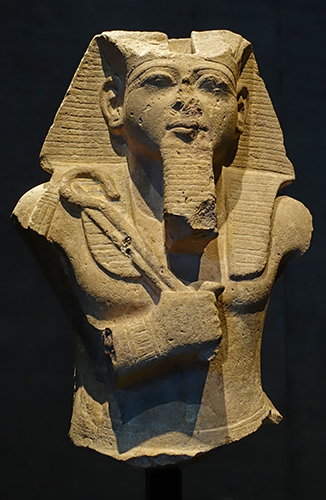
Nineteenth Dynasty: 1 292 BC - 1 187 BC
Ramses II
Upper half of a seated figure of Pharaoh Ramses II holding crook and flail, circa 1 240 BC.
Catalog: Sandstone, Nubian, Gl. 89
Photo: Don Hitchcock 2018
Source: Original, Ägyptischen Museum München
Text: Museum card, © Ägyptischen Museum München
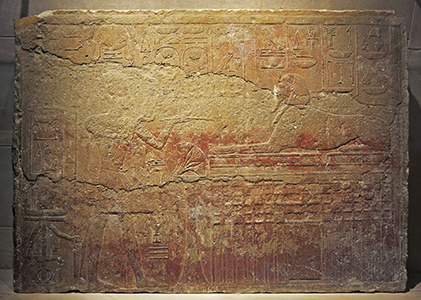
Nineteenth Dynasty: 1 292 BC - 1 187 BC
Ramses II
Limestone relief of Ramses II worshiping the Giza Sphinx, 1 276 BC - 1 210 BC.
This bas-relief and the one shown below were discovered between the feet of the grand sphinx of Giza which, in the time of Ramses II, was considered as the representation of the god 'Horus of the horizon'. The red marking may be paint or an iron deposit.
Ramses II is standing, wearing a loincloth with a triangular front, with a Nemes headdress, wearing the blue crown of Egypt and animal's tail, presenting a censer (burner for incense) to Harmachis, a manifestation of the god Horus, specific to the Giza pyramids zone, with his cult focused on the Great Sphinx – this royal statue, originally carved to represent King Khafre of the 4th Dynasty, Old Kingdom, having become regarded as an image of Harmachis by the early New Kingdom. Harmachis is Harmachis is wearing a Nemes headdress, lying on a plinth, a decoration on the facade of a palace.
He wears a Uraeus and a false beard, rolled up. A spouted ewer is shown pouring liquid.
Height 1120 mm, length 1590 mm, thickness 150 mm.
Catalog: limestone, B 18, N 131 A, Salt n° 3737
Location: Sully, Room 338, Crypt of the sphinx, outside the window
Photo: Don Hitchcock 2015
Source and text: Original, Louvre Museum, https://collections.louvre.fr/
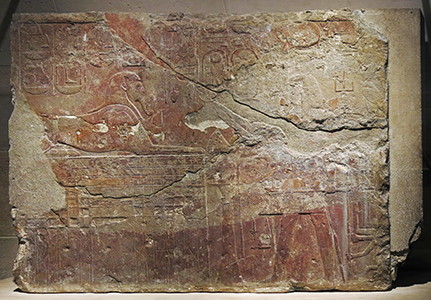
Nineteenth Dynasty: 1 292 BC - 1 187 BC
Ramses II
Limestone relief of Ramses II worshiping the Giza Sphinx, 1 276 BC - 1 210 BC.
This bas-relief and the one shown above were discovered between the feet of the grand sphinx of Giza which, in the time of Ramses II, was considered as the representation of the god 'Horus of the horizon'. The red marking may be paint or an iron deposit.
Ramses II is standing, wearing a loincloth with a triangular front, wearing an animal's tail, presenting a censer (burner for incense) to Harmachis, a manifestation of the god Horus, specific to the Giza pyramids zone, with his cult focused on the Great Sphinx – this royal statue, originally carved to represent King Khafre of the 4th Dynasty, Old Kingdom, having become regarded as an image of Harmachis by the early New Kingdom. Harmachis is wearing a Nemes headdress, lying on a plinth, a decoration on the facade of a palace. He wears a Uraeus and a false beard, rolled up.
Height 1115 mm, length 1435 mm, thickness 150 mm.
Catalog: limestone, B 19, N 131 B, Salt n° 3738
Location: Sully, Room 338, Crypt of the sphinx, outside the window
Photo: Don Hitchcock 2015
Source and text: Original, Louvre Museum, https://collections.louvre.fr/

Nineteenth Dynasty: 1 292 BC - 1 187 BC
Palm-leaf column of Ramesses II
This column is from a temple primarily dedicated to the ram god Heryshef of Herakleopolis. Ramesses is twice shown making offerings to a local form of Osiris.
The god wears his typical feather crown but is in a kilt, not his usual mummy form.
Vertical texts further up and down from this display cartouches with Ramesses' throne and birth names. Those of his son Merenptah, who was already old when inheriting the throne, were hurriedly added in extant spaces near the bottom.
Date: Circa 1250 BC
Description: Red granite column with palm-capital from the temple of Herishef at Heracleopolis: upper section - inscribed with four vertical registers of hieroglyphs, containing the names and titles of Ramses II with two scenes in which the king is shown making offerings to Osiris; lower portion - four vertical registers of hieroglyphs, roughly cut, containing the names and titles of Merenptah.
Height 523 centimetres, diameter at base 75 centimetres.
Catalog: Red granite, Herakleiopolis, (Ihnasya el-Medina), Temple of Heryshef, gift of the Egypt Exploration Fund, 1891, EA1123
Photo: Don Hitchcock 2018
Source: Original, British Museum
Text: Card with the display at the British Museum, https://www.britishmuseum.org/, © Trustees of the British Museum, CC BY-NC-SA 4.0
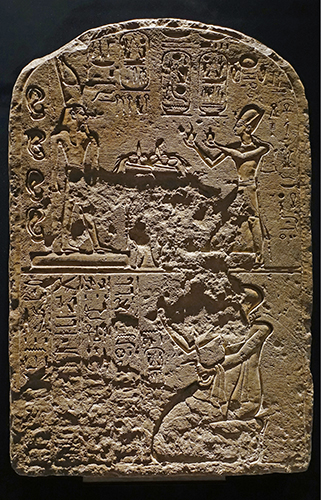
Nineteenth Dynasty: 1 292 BC - 1 187 BC
Stela of Rahotep
Stela of Rahotep for the pharaoh Ramses II, circa 1 250 BC
Catalog: Limestone, Gl. 287
Photo: Don Hitchcock 2018
Source: Original, Ägyptischen Museum München
Text: Museum card, © Ägyptischen Museum München
Nineteenth Dynasty: 1 292 BC - 1 187 BC
Woman in Confinement
Figure of a woman in confinement, lying on a bed, circa 1 250 BC.
Catalog: Ceramic, ÄS 413
Photo: Don Hitchcock 2015
Source: Original, Ägyptischen Museum München
Text: Museum card, © Ägyptischen Museum München
Nineteenth Dynasty: 1 292 BC - 1 187 BC
Khopesh
Khopesh curved sword from Qantir, East Delta.
This example has a flanged hilt in stead of a tang for a wooden handle.
A typical khopesh is 50 – 60 cm in length, though smaller examples also exist. The inside curve of the weapon could be used to trap an opponent's arm, or to pull an opponent's shield out of the way. These weapons changed from bronze to iron in the New Kingdom period. The earliest known depiction of a khopesh is from the Stele of Vultures, depicting King Eannatum of Lagash wielding the weapon. This would date the khopesh to at least 2 500 BC.
The blade is only sharpened on the outside portion of the curved end. The khopesh evolved from the epsilon or similar crescent-shaped axes that were used in warfare.
Qantir is believed to mark what was probably the ancient site of the 19th Dynasty Pharaoh Ramesses II's capital, Pi-Ramesses or Per-Ramesses. It is situated around 9 kilometres north of Faqous in the Sharqiyah province of the eastern Nile Delta, about 100 km north-east of Cairo.
Catalog: Bronze, ÄS 5557
Photo: Don Hitchcock 2018
Source: Original, Ägyptischen Museum München
Text: Museum card, © Ägyptischen Museum München
Additional text: Wikipedia
Nineteenth Dynasty: 1 292 BC - 1 187 BC
Khopesh
Khopesh curved sword from Qantir, East Delta.
This example has a tang to allow it to accept a wooden handle.
Catalog: Bronze, ÄS 5887
Photo: Don Hitchcock 2018
Source: Original, Ägyptischen Museum München
Text: Museum card, © Ägyptischen Museum München
Nineteenth Dynasty: 1 292 BC - 1 187 BC
Sibe and his Wife
Group statue of Sibe and his wife Weretkhenit, circa 1 220 BC
Catalog: Limestone, Memphis, Gl. WAF 33
Photo: Don Hitchcock 2015, 2018
Source: Original, Ägyptischen Museum München
Text: Museum card, © Ägyptischen Museum München
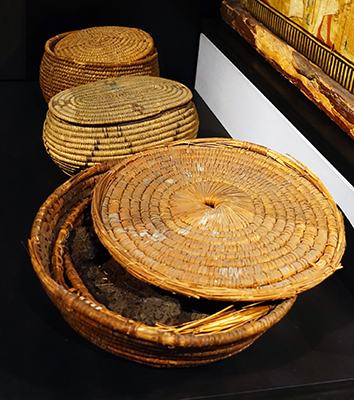
Nineteenth Dynasty: 1 292 BC - 1 187 BC
Nefretiri
Contents of a child's tomb, called Nefretiri, circa 1 220 BC
This coffin, belonging to a little girl called Nefretiti, is in the shape of a divine shrine. The original skids reference the most common means of freight transport over sandy soil, the sled.
The depictions on the long sides are almost identical: their arms raised in exaggerated gestures, family members mourn before the deceased's mummy. On the right side, the grief is expressed for the little girl; the left side, however, mentions her mother Mutemuya instead - mother and daughter may have died at the same time. At the head of the coffin, the goddess Nephthys protects the deceased.
In the same find complex, foodstuffs were found as provisions for her life in the Nether-world: a basket with bread, various nuts, and dates.
Catalog: ÄS 23, 4897, 4898, 1249, 301, 302, 304, 305, 298
Photo: Don Hitchcock 2018
Source: Original, Ägyptischen Museum München
Text: Museum card, © Ägyptischen Museum München



Nineteenth Dynasty: 1 292 BC - 1 187 BC
Ramesses II
Photo: Don Hitchcock 2015, 2018
Source: Original, British Museum
Plaster cast of a relief from the temple of Belt el-Wall, Lower Nubia.
The cast depicts a military expedition by Ramesses II (left) and the presentation to the pharaoh of the produce of Nubia and the lands of tropical Africa (right).
On the left, Ramesses II (1279-1213 BC), followed by two of his sons, Amen-her-wenemef and Khaemwaset, is depicted charging against a body of Nubian bowmen, who are shown with black and brown complexions, dressed in leopard skin kilts, and wearing large earrings. A wounded warrior is escorted to a village. On the right, Ramesses II, enthroned beneath a canopy, receives the produce of the southlands, presented by the viceroy Amenemope. These include bags of gold, gold rings, incense, elephant tusks, ebony logs, ostrich eggs and feathers, pelts, bows, hide-covered shields, fans and chairs. The varied selection of live animals includes a lion, giraffe, ostrich, gazelle, leopard, monkeys, antelopes and dogs, as well as oxen with horns artificially deformed and decorated with miniature human heads and hands. Men, women and children are presented as servants and slaves.
The cast was made for Robert Hay by Joseph Bonomi in 1825. The colours were added by Bonomi and are based on the originals as observed by Bonomi and Arundale. The cast was repainted by Douglas Champion in 1952.
Photo: Don Hitchcock 2015, 2018
Source: Original, British Museum
Text: Card with the display at the British Museum, © Trustees of the British Museum, CC BY-NC-SA 4.0
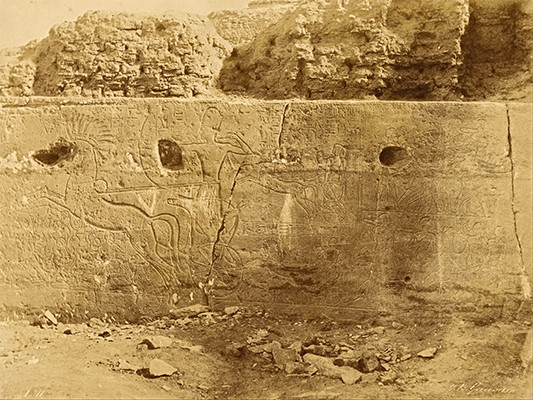
Nineteenth Dynasty: 1 292 BC - 1 187 BC
Temple of Beit el-Wali frieze
This is the earliest photograph of the Temple of Beit el-Wali frieze which celebrates the exploits of Ramesses II. It was taken at the very beginning of practical photography, in 1854, on salted paper, from a calotype negative. The original title is 'Bet-Oualli, Sculptures Historiques de la Paroi de Gauche'.
Dimensions: Height 230 mm, width 305 mm.
Photo: John Beasly Greene (American, born France, 1832 - 1856)
Permission: Public Domain
Text: adapted from Wikipedia
Made available by: Google Art Project
Salted paper technique
The salted paper technique was created in the mid-1830s by English scientist and inventor Henry Fox Talbot. He made what he called 'sensitive paper' for 'photogenic drawing' by wetting a sheet of writing paper with a weak solution of ordinary table salt (sodium chloride), blotting and drying it, then brushing one side with a strong solution of silver nitrate. This produced a tenacious coating of silver chloride in an especially light-sensitive chemical condition. The paper darkened where it was exposed to light. When the darkening was judged to be sufficient, the exposure was ended and the result was stabilized by applying a strong solution of salt, which altered the chemical balance and made the paper only slightly sensitive to additional exposure. In 1839, washing with a solution of sodium thiosulfate ('hypo') was found to be the most effective way to make the results truly light-fast.Text above: Wikipedia
Nineteenth Dynasty: 1 292 BC - 1 187 BC
Ramesses II
Ramesses II storming the Hittite fortress of Dapur.
Ramesses extended his military successes in his eighth and ninth years. He crossed the Dog River (Nahr al-Kalb) and pushed north into Amurru. His armies managed to march as far north as the Hittite fortress of Dapur, where he had a statue of himself erected. The Egyptian pharaoh thus found himself in northern Amurru, 100 km north of Kadesh, in Tunip, where no Egyptian soldier had been seen since the time of Thutmose III, almost 120 years earlier. He laid siege to the city before capturing it.
Painting: Unknown
Source: German lithography published in 1879
Permission: Public Domain
Text: Wikipedia


Nineteenth Dynasty: 1 292 BC - 1 187 BC
Ramesses II shabti
Wooden shabti of Ramesses II, remodelled as an Osirian statue.
Reign of Ramesses II, circa 1279 - 1213 BC, remodelled in the 21st Dynasty, circa 1 070 BC - 945 BC
Wooden shabti of Ramses II, reused as an Osiris-figure in the 21st Dynasty. Original detail: a striped nemes-headdress, modelled face, crossed hands holding two hoes, seed-basket on the back, seven rows of Hieroglyphic text down the legs. Secondary decoration includes: crude cutting of the nemes headdress to resemble a tripartite wig, the addition of a tenon at the top of the head for the attachment of an Atef-crown, remains of black pitch and the addition of a long rectangular plinth.
Dimensions (including plinth): Height: 408 mm, width 101 mm, depth 254 mm.
Catalog: Provenance unknown ( presumably originally from the tomb of Ramesses II - Don ), EA69672
Photo: Don Hitchcock 2018
Source: Original, British Museum
Text: Card with the display at the British Museum, https://www.britishmuseum.org/, © Trustees of the British Museum, CC BY-NC-SA 4.0
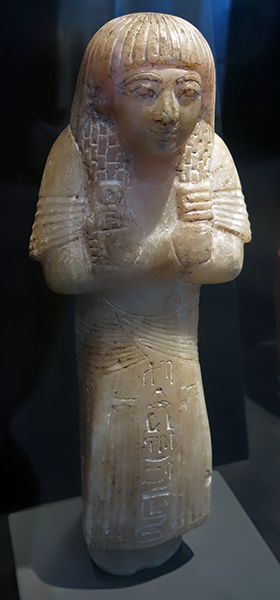
Nineteenth Dynasty: 1 292 BC - 1 187 BC
Neb-Sumenu
Uschebti of Neb-Sumenu. The inscription lists the work that this servant figure is to perform for the tomb lord in the afterlife.
Catalog: Calcite (so-called alabaster), Inv. H 12
Photo: Don Hitchcock 2015
Source and text: Badisches Landesmuseum Karlsruhe Germany
Nineteenth Dynasty: 1 292 BC - 1 187 BC
Ramesses II bead
Bead, part of a cult adornment: lord of the countryside.
19th dynasty, reign of Ramses II, 1279 - 1213 BC, perforated siliceous faience earthenware.
It shows libation vases, papyrus, water lilies and signs of life. On the reverse side, King Ramses II sits enthroned.
Catalog: E 32663
Photo: Don Hitchcock 2018
Source and text: Louvre Museum, Paris, France
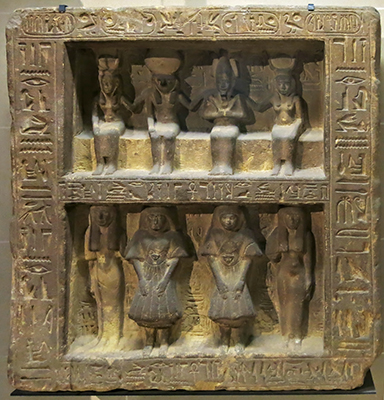
Nineteenth Dynasty: 1 292 BC - 1 187 BC
Rectangular stela
Reign of Ramses II.
First register: series of seated deities. Hathor with a robe, sun disc with horns; Horus, the falcon headed god with a sun disc; Osiris in a tight shroud; Isis in a robe, sun disc with horns.
Second register: series of four standing figures. Two men in the middle, wearing a skirt with a puffed up front, a sleeved shirt, panther skin, hands in front of skirt; two women, one on each side, wearing dresses and long tripartite wigs.
Listed names and titles: Ounnefer (1st servant of the god of Osiris); Maiany (mother, mistress of the house); Mery (father, 1st servant of the god of Osiris); Tiy (wife, mistress of the house, singer-memayt of Isis); Ramses II; Hathor; Horus; Osiris; Isis.
Height 1095 mm, width 1050 mm, thickness 250 mm.
Catalog: Limestone, Abydos, El-Araba el-Madfouna, N 248, Salt n° 3740
Location: Aile Sully, Salle 323, Crypt of Osiris, Vitrine 11
Photo: Don Hitchcock 2015
Source and text: Original, Louvre Museum, https://collections.louvre.fr/
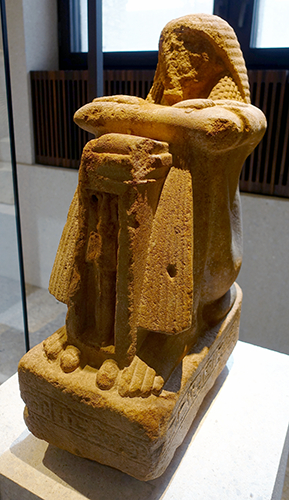
Nineteenth Dynasty: 1 292 BC - 1 187 BC
Jupa
Block statue of Jupa with shrine of a god (Naos)
Circa 1 260 BC.
Like his father Urkhija / Urkhai who came from Hurru, Iupa / Jupa / Yupa was an army commander and construction supervisor, and was involved at one of the building sites of the newly founded Residence Piramesse, i.e. ' the Great Stable of Ramessu-Meryamum ', according to an account book from the fifth year of Ramesses II, the so-called Paris Leather Roll. Later on during his career, he became not only the Superintendant of the Ramesseum at Thebes, but also Director of the Treasury of the King and Director of the Granaries.
( note the grotesquely large feet and toes of this statue. I feel sure that this cannot be an accident, or poor craftsmanship, but it is difficult to conceive of a rationale for this oddity - Don )
Catalog: Quartzite, ÄM 24022
Photo: Don Hitchcock 2018
Source: Original, Staatliche Museen zu Berlin, Neues Museum, Germany
Text: © Card at the Staatliche Museen zu Berlin, (CC BY-NC-SA 3.0 DE)
Additional text: García (2013), http://www.griffith.ox.ac.uk/gri/3berlin.pdf
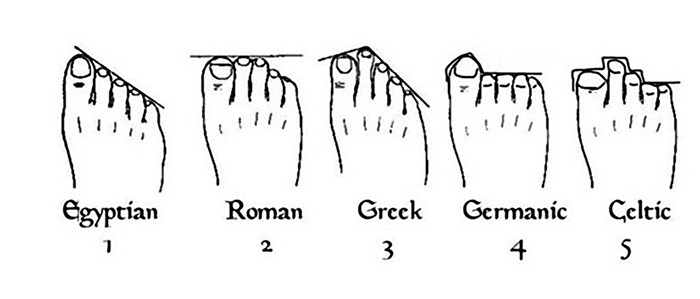
While researching the statue of Jupa above, I stumbled across this delightful image of the size and arrangement of Western European people's toes, determined by their ancestry. Early Egyptian statues have Egyptian toes, Greek statues have Greek toes, but Roman statues also have Greek toes, since many were copies of Greek originals, or were done in the Greek style. See, for example, the giant foot of Roman Emperor Constantine the Great, as part of the Colossus of Constantine statue - Don
Photo: http://www.familytree.com/blog/feet-toes/
Nineteenth Dynasty: 1 292 BC - 1 187 BC
Setau
Kneeling figure of Setau holding a stela (stelophore)
Circa 1 260 BC.
A stelophore is a type of statue where the the kneeling person has a stele in front of him, holding it in a gesture of worship. They were probably erected in the niches of the pyramidial graves of private tombs.
Setau was the Viceroy of Kush in the second half of Ramesses II's reign. Contemporary records show that Setau served in this position from Year 38 until at least Year 63 of Ramesses II's reign.
Setau was ' a graduate of the royal school ' and already enjoyed an impressive record of royal service which is detailed in a long autobiographical inscription carved at Wadi es-Sebua. The temple of Wadi es-Sebua was built for Ramesses II by Setau around 1236 BC or Year 44 of this pharaoh's reign. Eleven of his stela, now in the Cairo Museum, were found in the courtyard of this temple and make it possible to establish his career and understand the precise duties of a viceroy. Setau states:
' I was one whom his Lord caused to instructed....as a ward of the palace. I grew up in the royal abode when I was a youth...I was provided for with bread and beer from all the royal meals. I came forth as a scribe from the school, I was appointed to be Chief Scribe of the Vizier; I assessed the whole land with a scroll. I was equal to the task. '
Setau was determined to set out his mark in Nubia and records that he:
' directed serfs in their thousands and ten-thousands, and Nubians in hundred-thousands, without limit. I brought all the dues of the land of Kush in double measure. I caused the people to come in submission. Then I was commissioned to build the temple of Ramesses II in the Domain of Amun ( ie. Wadi es-Sebua) '
Apart from the temple of Wadi es-Sebua, Setau also erected another temple at Gerf Hussein on the West Bank of the Nile around Year 45 of Ramesses II. Setau's tomb (TT289) is located in the Dra' Abu el-Naga' area of the Theban Necropolis.
Catalog: Limestone, ÄM 2287
Photo: Don Hitchcock 2015, 2018
Source: Original, Staatliche Museen zu Berlin, Neues Museum, Germany
Text: © Card at the Staatliche Museen zu Berlin, (CC BY-NC-SA 3.0 DE)
Additional text: http://www.aegyptologie.com/
Additional text: Wikipedia
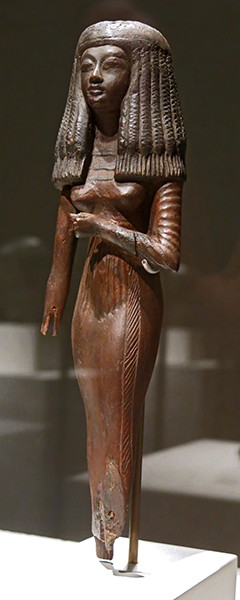
Nineteenth Dynasty: 1 292 BC - 1 187 BC
Young woman
Standing figure of a young woman.
Catalog: Wood, Thebes ÄM 8041
Photo: Don Hitchcock 2015
Source: Original, Staatliche Museen zu Berlin, Neues Museum, Germany
Text: © Card at the Staatliche Museen zu Berlin, (CC BY-NC-SA 3.0 DE)

Nineteenth Dynasty: 1 292 BC - 1 187 BC
Five Kings
Relief fragment showing five enthroned kings of the Old Kingdom.
The reconstruction of the ancient Egyptian chronology is mainly based on rare kinglists mostly found in temples. This makes the few lists found in private context, such as this piece which was discovered in a tomb of the New Kingdom in Abusir / Saqqara, all the more significant. Five enthroned kings are depicted, with their names written in cartouches. Of the severely damaged cartouches, only the one in the middle can be deciphered with certainty as the name of king Menkaure, from the Fourth Dynasty.
Catalog: Limestone, Abusir/Saqqara (?), ÄM 1116
Photo: Don Hitchcock 2018
Source: Original, Staatliche Museen zu Berlin, Neues Museum, Germany
Text: © Card at the Staatliche Museen zu Berlin, (CC BY-NC-SA 3.0 DE)
Nineteenth Dynasty: 1 292 BC - 1 187 BC
Ptah-mai
Family group of Ptah-mai, chief of the Wab-priests of Ptah and his wife Hatshepsut.
From the reign of Ramses II, 1 279 BC - 1 213 BC.
Dimensions: 960 x 870 x 775 mm
In addition to temple statues, portraits are still used in the New Kingdom, which were placed in the cult niches of the tomb chapels. Ptahmai was an officer under Ramses II and was given the office of chief priest at the Ptah temple because of his age. To his left is his wife Hatshepsut, a 'singer of Amun', while on the right is his eldest daughter, a 'harem lady of Pharaoh'.
There is also a son between the couple, who is called the 'servant of Pharaoh', and another daughter to the right of the father. She too was a 'singer of Amun' and holds a sistrum in her right hand as a sign of it. She is also the founder of the 'family group'.
Ptahmai is bald, since he is a priest. He wears a pleated apron that extends from the hip to the calf. A sash runs over his left shoulder. He was twice awarded the 'Gold of Bravery' (chains of golden disc beads) by his king. The fat pads below the chest are a status symbol for its high rank.
Only the man's feet are in sandals, all other people are barefoot. The three women are dressed in ankle-length pleated robes and shoulder collars. Voluminous, multi-part wigs frame the faces. Unfortunately, only a little can be seen of the figure of the son. During the 3rd Dynasty and then again in the New Kingdom, it was customary to have the depicted sit on stools, and in the New Kingdom on armchairs with backrests, the structural details of which appear to be sculpted or at least painted on.
The group figure of the Ptahmai has, as is usual for such sculptures, a high backrest, but on both sides of the women at least on the outer sides, stools are depicted as seating furniture in the typical form of the time.
A relief on the back surface of the backrest shows the couple's children sacrificing to their parents. With this sculpture, too, the formal principles of ancient Egyptian panoramas are clearly visible. This explains the overlapping of the wife's right arm, which is placed around the waist of the man, or the daughter's left arm, which rests on the father's left shoulder. Due to the frontal orientation and the axial constraint of the figures, it was not possible to indicate these limbs in their correct proportions ... the figures of this group have empty, expressionless, schematically shaped faces.
From: Finneiser, Klaus, in: Priese, Karl-Heinz (Hrsg.), Ägyptisches Museum Berlin, Museumsinsel Berlin, Mainz 1991, S. 150.
Catalog: Limestone, Necropolis of Saqqara, ÄM 2297
Photo: Don Hitchcock 2018
Source: Original, Staatliche Museen zu Berlin, Neues Museum, Germany
Text: © Card at the Staatliche Museen zu Berlin, (CC BY-NC-SA 3.0 DE)
The Late Bronze Age collapse
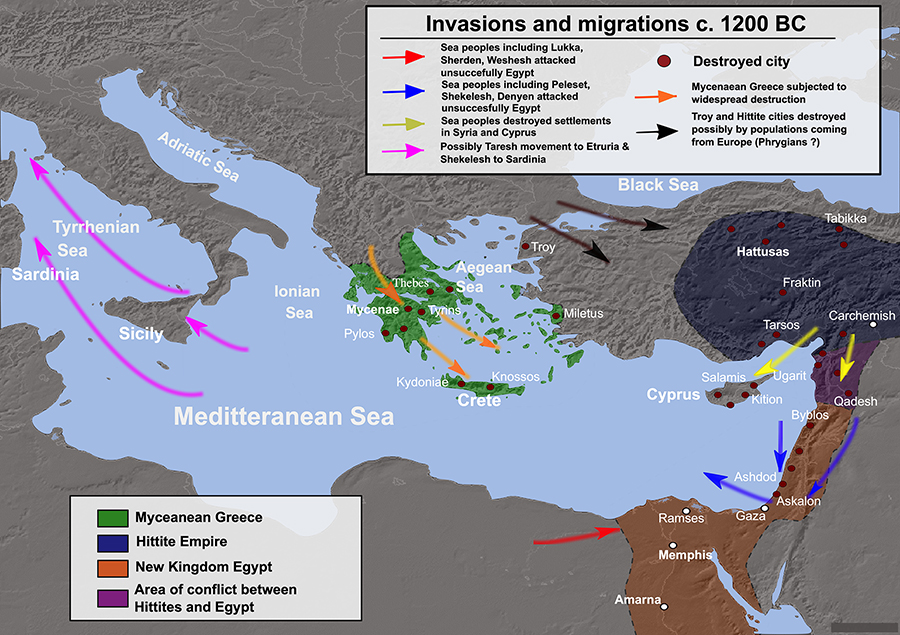
The Late Bronze Age collapse was a dark age transition in a large area covering much of Southeast Europe, West Asia and North Africa (comprising the overlapping regions of the Near East, the Eastern Mediterranean and North Africa, with the Balkans, the Aegean, Anatolia, and the Caucasus), which took place from the Late Bronze Age to the emerging Early Iron Age.
It was a transition which historians believe was violent, sudden, and culturally disruptive, and involved societal collapse for some civilisations during the 12th century BC. The palace economy of Mycenaean Greece, the Aegean region and Anatolia that characterised the Late Bronze Age disintegrated, transforming into the small isolated village cultures of the Greek Dark Ages. The Hittite Empire of Anatolia and the Levant collapsed, while states such as the Middle Assyrian Empire in Mesopotamia and the New Kingdom of Egypt survived but were considerably weakened.
Competing and even mutually incompatible theories for the ultimate cause of the Late Bronze Age collapse have been made since the 19th century. These include volcanic eruptions, droughts, invasions by the Sea Peoples or migrations of Dorians, economic disruptions due to the rising use of ironworking, and changes in military technology and methods of war that saw the decline of chariot warfare.
Text: Wikipedia
Photo: Alexikoua
Permission: Creative Commons Attribution-Share Alike 3.0 Unported license.
Description: Migrations, invasions and destructions during the end of the Bronze Age (circa 1200 BC), Topography taken from DEMIS Mapserver, which are public domain, other wise self-made.
Merneptah and the first skirmishes of the Late Bronze Age collapse
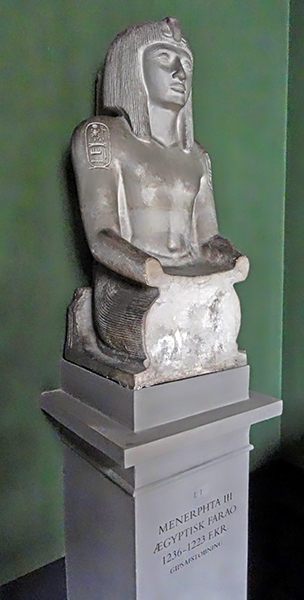
Nineteenth Dynasty: 1 292 BC - 1 187 BC
Merneptah
Merneptah was already an elderly man in his late 60s, if not early 70s, when he assumed the throne. Merneptah moved the administrative center of Egypt from Piramesse (Pi-Ramesses), his father's capital, back to Memphis, where he constructed a royal palace next to the temple of Ptah. This palace was excavated in 1915 by the University of Pennsylvania Museum, led by Clarence Stanley Fisher.
Merneptah had to carry out several military campaigns during his reign. In the fifth year of his rule, he fought against the Libyans, who - with the assistance of the Sea Peoples - were threatening Egypt from the west. Merneptah led a victorious six hour battle against a combined Libyan and Sea People force at the city of Perire, probably located on the western edge of the Nile delta. His account of this campaign against the Sea Peoples and Libu (an Ancient Libyan tribe of Berber origin, from which the name Libya derives) is described in prose on a wall beside the sixth pylon at Karnak, KIU 4246, which states:
[Beginning of the victory that his majesty achieved in the land of Libya]
-I, Ekwesh, Teresh, Lukka, Sherden, Shekelesh, Northerners coming from all lands.
Later in the inscription, Merneptah receives news of the attack:
...the third season, saying: 'The wretched, fallen chief of Libya, Meryre, son of Ded, has fallen upon the country of Tehenu with his bowmen - Sherden, Shekelesh, Ekwesh, Lukka, Teresh, taking the best of every warrior and every man of war of his country. He has brought his wife and his children - leaders of the camp, and he has reached the western boundary in the fields of Perire.'
An inscription on the Athribis Stele, now in the garden of Cairo Museum, declares 'His majesty was enraged at their report, like a lion', assembled his court, and gave a rousing speech. Later he dreamed he saw Ptah handing him a sword and saying 'Take thou (it) and banish thou the fearful heart from thee.' When the bowmen went forth, says the inscription, 'Amun was with them as a shield.' After six hours the surviving Nine Bows threw down their weapons, abandoned their baggage and dependents, and ran for their lives. Merneptah states that he defeated the invasion, killing 6 000 soldiers and taking 9 000 prisoners. To be sure of the numbers, among other things, he took the penises of all uncircumcised enemy dead and the hands of all the circumcised, from which history learns that the Ekwesh were circumcised, a fact causing some to doubt that they were Greek.
There is also an account of the same events in the form of a poem from the Merneptah Stele, widely known as the Israel Stele, which makes reference to the supposed utter destruction of Israel in a campaign prior to his fifth year, in Canaan: 'Israel has been wiped out...its seed is no more.' This is the first recognised ancient Egyptian record of the existence of Israel - 'not as a country or city, but as a tribe' or people.
Photo: Daderot
Permission: Public Domain
Source: Thorvaldsens Museum, Copenhagen, Denmark
Text: Wikipedia
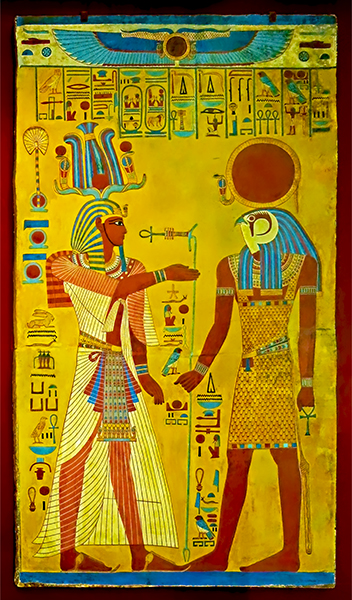
Nineteenth Dynasty: 1 292 BC - 1 187 BC
Merneptah
Cast from the Tomb of King Merneptah
( Note that these colours are highly subjective - we have no way of knowing the brightness of the original hues. I have seen other representations of this piece with much more garish colours - Don )
Valley of the Kings, Egypt
Tomb carved 1 210 - 1 204 BC
Cast made by Joseph Bonomi 1824 - 1834
Catalog: Hay Collection AES
Photo: Don Hitchcock 2015
Source: Original, British Museum
Text: Card at the British Museum, © Trustees of the British Museum, CC BY-NC-SA 4.0
Nineteenth Dynasty: 1 292 BC - 1 187 BC
Khabekhnet
Chabechnet in front of royal families of the 16th Century BC.
Tomb relief circa 1 210 BC, during the reign of Merneptah, 1 210 - 1 200 BC.
Khabekhnet was the eldest son of Sennedjem (TT1). He lived during the 19th dynasty when Ramesses II (1 279 - 1 213 BC) was on the throne. His title was 'Servant in the Place of Truth'. He lived in Deir el-Medina and worked in the royal tombs at the Valley of the Kings.
Khabekhnet's house was located in the southwestern part of the village. It stood next to the house of his father Sennedjem. Khabekhnet was buried along with his wife, Sahte, and their family in tomb TT2 above and slightly to the south of his father's tomb.
Khabekhnet's family was as extensive as Sennedjem's family. A stela found in the courtyard of the tomb contains the names of Khabekhnet, his brother Khons and several children: Mose, Anhotep, Amenemheb, Isis and Henutweret.
Davies (1999) suggests that they all were Khabekhnet's offspring.
The relief comes from his tomb. It shows Khabekhnet standing in a gesture of adoration on the right in front of a row of deceased kings. The purpose of this relief might lie in the fact that he could have been responsible for the care of their tombs.
Catalog: TT2, Deir el-Medine, Tomb of Chabechnet, Plaster on limestone, ÄM 1625
Photo: Don Hitchcock 2018
Source: Original, Staatliche Museen zu Berlin, Neues Museum, Germany
Text: © Card at the Staatliche Museen zu Berlin, (CC BY-NC-SA 3.0 DE)
Additional text: http://www.deirelmedina.com/lenka/NeuesMuseum.html
Nineteenth Dynasty: 1 292 BC - 1 187 BC
Calcite Jars
Calcite storage jars for funerary oils.
1 210 BC - 1 204 BC.
These jars formed part of a cache of 13 calcite vessels discovered near the entrance to the tomb of Merneptah. Some of the jars were inscribed with hieratic texts indicating that they had held oils used at the funeral of the king.
(left) EA55013: Calcite vase, two handles with animal-heads at the base.
Dimensions: Diameter 254 mm, height 324 mm.
(right) EA55012: Bulbous vase of banded calcite, height 299 mm.
Catalog: Calcite, Valley of the Kings EA55013, EA55012
Photo: Don Hitchcock 2018
Source: Original, British Museum
Text: © Card at the Museum, http://www.britishmuseum.org/research/ © Trustees of the British Museum, CC BY-NC-SA 4.0,
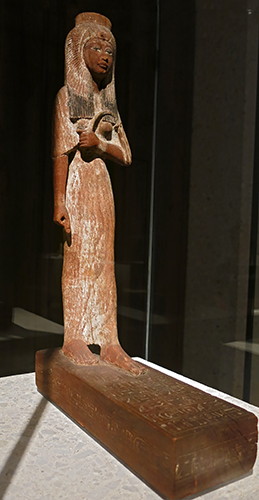

Nineteenth Dynasty: 1 292 BC - 1 187 BC
Queen Ahmose-Nofretari
Statue is circa 1200 BC.
Queen Ahmose-Nofretari herself, is from the Eighteenth Dynasty: 1 550 BC - 1 292 BC This statue is, however, from the 19th Dynasty, as a result of posthumous worship.
Height 440 mm.
Standing figure of Queen Ahmose-Nofretari, or Ahmosi Nefertere, mother of King Amenhotep I.
This small wooden figure represents Queen Ahmose-Nefertari (Ahmes-Nefertari / Nofretari). She was the sister and consort of King Ahmose (early 18th dynasty), who ended the domination of the Hyksos in Egypt and founded the 18th dynasty. Ahmose-Nefertari was one of the first 'goddesses of Amun'.
Ahmet-Nefertari and her son Amenhotep I were divinely revered after their death, especially by the craftsmen of the labourers' settlement in Deir el Medina, whom they regarded as their guardian goddess. The sculptor of the figure was 'Pai', who worked as a painter of Amun in Karnak, and who wanted 'a perfect life of health, comfort and daily joy, a beautiful funeral in old age on the western side of Thebes' from the deified queen.
Catalog: Wood, painted, Thebes, ÄM 6908
Photo: Don Hitchcock 2015, 2018
Source: Original, Staatliche Museen zu Berlin, Neues Museum, Germany
Text: © Card at the Staatliche Museen zu Berlin, (CC BY-NC-SA 3.0 DE)
Additional text: Margret Pirzer, https://www.flickr.com/photos/57703761@N06/31075006346
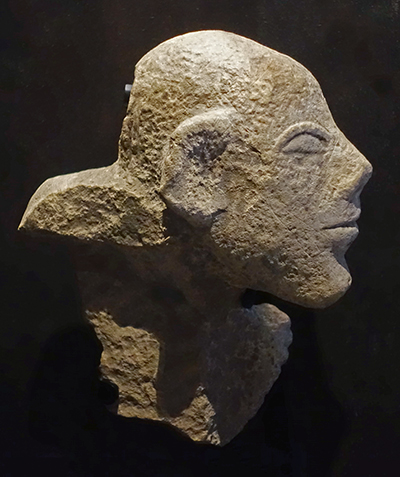
Nineteenth Dynasty: 1 292 BC - 1 187 BC
Asiatic
Head of a subjugated Asiatic, circa 1 200 BC.
This is an architectural element from a temple wall.
Catalog: Limestone, ÄS 7215
Photo: Don Hitchcock 2018
Source: Original, Ägyptischen Museum München
Text: Museum card, © Ägyptischen Museum München
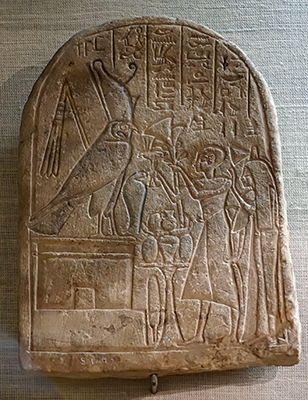
Nineteenth Dynasty: 1 292 BC - 1 187 BC
Horus Stele
Married couple in front of the Horus falcon, circa 1 200 BC.
Catalog: Limestone, provenance unknown, Inv. Nr. 1935.200.218
Photo: Don Hitchcock 2018
Source and text: Original, Museum August Kestner, Hannover
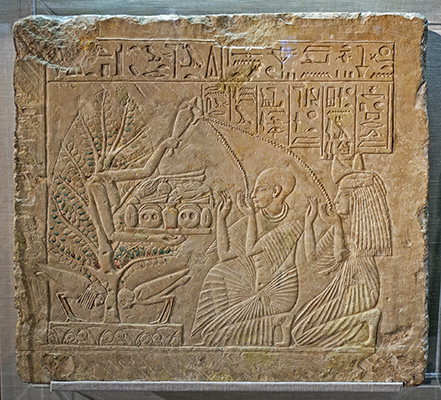
Nineteenth Dynasty: 1 292 BC - 1 187 BC
Tree Goddess
Married couple before a tree goddess, early 19th Dynasty.
( This limestone relief was originally painted, and vestiges of paint may be discerned on the piece - Don )
Catalog: Limestone, Abusir (Saqqara?), Inv. Nr. 2933
Photo: Don Hitchcock 2018
Source and text: Original, Museum August Kestner, Hannover
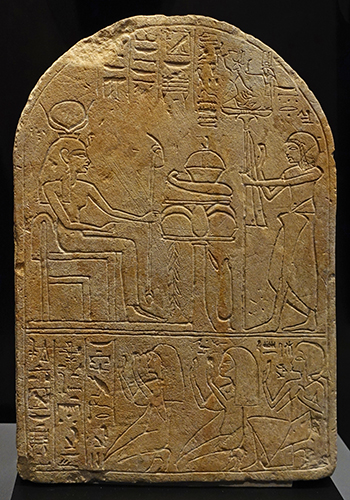
Nineteenth Dynasty: 1 292 BC - 1 187 BC
Stela
Stela of the Standard-bearer Kel.
Catalog: Limestone, Assiut, ÄS 7922
Photo: Don Hitchcock 2018
Source: Original, Ägyptischen Museum München
Text: Museum card, © Ägyptischen Museum München
Nineteenth Dynasty: 1 292 BC - 1 187 BC
Hori, High Priest
Sarcophagus of Hori, High Priest of Memphis.
Hori was the High Priest of Ptah at the very end of the reign of Ramesses II. Hori succeeded Neferronpet in office. He was a son of prince Khaemwaset and hence a grandson of Ramesses II. Hori had an older brother named Ramesses who had served as Sem priest of Ptah.
Catalog: Sandstone, Memphis, ÄM 87
Photo: Don Hitchcock 2015, 2018
Source: Original, Staatliche Museen zu Berlin, Neues Museum, Germany
Text: © Card at the Staatliche Museen zu Berlin, (CC BY-NC-SA 3.0 DE)
Additional text: Wikipedia

Nineteenth Dynasty: 1 292 BC - 1 187 BC
Hori, High Priest
It was Hori, however, who would eventually follow in his father's footsteps and become high priest.
Hori also had a sister named Isetnofret. It is possible that Isetnofret married her uncle Merenptah and served as his queen. If so, Hori would have been both a nephew and a brother-in-law to pharaoh Merenptah.
Catalog: Sandstone, Memphis, ÄM 87
Photo: Einsamer Schütze
Permission: GNU Free Documentation License, Version 1.2
Source: Original, Staatliche Museen zu Berlin, Neues Museum, Germany
Text: © Card at the Staatliche Museen zu Berlin, (CC BY-NC-SA 3.0 DE)
Additional text: Wikipedia
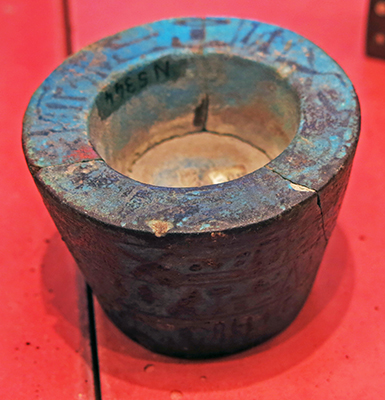
Nineteenth Dynasty: 1 292 BC - 1 187 BC
Godet
Godet for water in the name of Paser, Vizier (Prime Minister) of Seti I and Ramses II.
Blue-black silicious earthenware (faience), circa 1 290 BC - 1 210 BC
Inscription: Let any scribe about to write using this godet make a libation (pour a few drops on the ground) by saying: an offering of a thousand loaves and beers to the ka of His Excellency ... the Vizier Paser.
Paser was vizier in the reigns of Seti I and Ramesses II, during the 19th Dynasty. He would later also become High Priest of Amun.
Height 49 mm, diameter 68 mm.
Catalog: Faience, E 5344
Location: Sully, Salle 335, Writing and the scribes, Vitrine 2
Photo: Don Hitchcock 2015
Source and text: Original, Louvre Museum, https://collections.louvre.fr/
Additional text: Wikipedia

Nineteenth Dynasty: 1 292 BC - 1 187 BC
Shabti of Merenset
Painted wooden shabti of Merenset with a black lappet-wig, a brown modelled face with traced features and a yellow, green and red collar that envelopes the parallel brown hands.
The front of the leg section is inscribed with a column of black painted Hieroglyphs upon a yellow ground outlined in black; the body is white and the back is decorated with a representation of a yellow seed-basket and a red yoke with two pendular nu-pots.
Height 178 mm, width 52 mm, depth 35 mm.
Catalog: EA30803
Photo: Don Hitchcock 2015
Source: Original, British Museum
Text: © Card at the Museum, http://www.britishmuseum.org/research/ © Trustees of the British Museum, CC BY-NC-SA 4.0
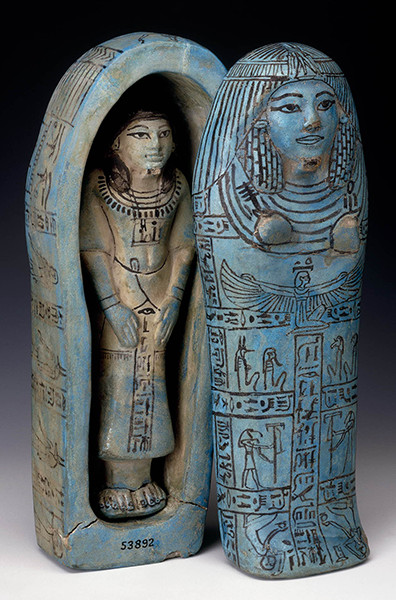
Nineteenth Dynasty: 1 292 BC - 1 187 BC
Shabti of Amenmose
Blue glazed composition shabti with anthropoid coffin inscribed for Amenmose: the absence of glaze in the recesses indicates that it was self-glazed. Along the vertical band of the blue coffin, and similarly along the vertical band on the shabti's kilt, the owner's name and titles are painted in black (probably manganese). The style of Amenmes' linen dress, his curled duplex wig, and the position of his hands flat on the skirt date the figure to the Nineteenth Dynasty.
Unlike the coffin, the shabti is not in the shape of a mummy, and does not hold the usual agricultural implements for work in the Underworld. Instead he appears in the dress of daily life, perhaps to signal his rebirth as a 'sah'. Amenmose is equipped for eternity by the protective texts running around his coffin. Four horizontal bands of text, a format introduced in the New Kingdom, wrap around the coffin like mummy bandages and describe Amenmes as revered before a number of gods, including the Four Sons of Horus.
For eternal protection, his image on the coffin holds the 'tyt'-girdle of Isis in his right hand, and the 'djed'-pillar of stability of the god of the Underworld, Osiris, in his left. Nut, the winged goddess of heaven, is painted across the chest of his coffin.
Height 292 mm (coffin), width 112 mm (coffin)
Height 285 mm (coffin lid), depth 125 mm (combined)
Height 228 mm (shabti), width 75 mm (shabti) depth 45 mm (shabti)
Inscription Translation:
Words spoken by the Osiris, fanbearer on the right of the king, royal scribe, overseer of the Shrine [lit.: Great House], overseer of the treasury of the Temple of Amun, Amenmes of Thebes.
Revered before Imsety, the Osiris, overseer of the treasury, Amenmes of Thebes.
Revered before Anubis, foremost of the god's booth, the overseer of the treasury, Amenmes of Thebes.
Revered before Duamutef, the Osiris, overseer of the treasury of Amen, Amenmes of Thebes.
Words spoken: revered before Horus the mighty protector of his father, Amenmes of the Treasury.
Revered before Hapy, the Osiris, Amenmes.
Revered before Anubis the mighty who is in the place of embalming, the Osiris, overseer of the treasury, Amenmes.
Words spoken: revered before Kebehsenuef, (Amen)-mes of Thebes.
Words spoken: revered before Thoth,the seat of Ra, the Osiris (Amen)-mes.
Right line. Words spoken by Nut the great: He is (my) son, (the) Osiris, Overseer of the Shrine [Great House] in the Temple of Amen-mes of Thebes.
Left line. Words spoken by Geb: He is (my) son, the Osiris, Overseer of the Treasury, Amen-mese, (the) offspring of Geb, ruler of the two lands.
Curator's comments: The abundant tomb shabtis of the New Kingdom were often stored in wooden boxes, while other shabtis, of a type in vogue since the end of the Seventeenth Dynasty, were placed in their own miniature anthropoid coffins. Most such shabtis with coffins were made of wood or clay, but this exceptional example, belonging to a man of some administrative status, is in glazed composition.The meaning of this coffined shabti is probably to be distinguished from that of the standard shabti that served until the late New Kingdom as a double of the deceased. Neither figure nor coffin carry the usual shabti agricultural implements nor the typical shabti inscription, Chapter 6 of the 'Book of the Dead'. Since the provenance of these coffined shabtis is generally unknown, determining their meaning is difficult. Some examples have been found as votive deposits.
Catalog: Thebes(?) EA53892
Photo (above): Don Hitchcock 2015, 2018
Photo (lower): © Trustees of the British Museum, CC BY-NC-SA 4.0
Source: Original, British Museum
Text: © Card at the Museum, http://www.britishmuseum.org/research/, © Trustees of the British Museum, CC BY-NC-SA 4.0

Nineteenth Dynasty: 1 292 BC - 1 187 BC
Setau
Sandstone stela of the Egyptian Viceroy of Kush, Setau, from Wadi Halfa, 1200s BC (19th Dynasty).
Abyssinia, or Ethiopia, was known as Kush to the ancient Egyptians.
Setau is shown on the right pouring a libation over an altar and offering incense to the goddess Renenutet, represented as a serpent seated upon a 'neb' basket on a stand.
The cartouche with the name of Ramesses II is inscribed behind the goddess.
Behind her on the extreme left is a cartouche with the prenomen of Ramses II. All figures are in sunk relief and the texts are deeply incised. The relief is well preserved and there are no traces of colour.
Height: 530 mm, width 470 mm, thickness: 155 mm
The stela is from Wadi Halfa, a city in the Northern state of Sudan on the shores of 'Lake Nubia' (the Sudanese section of Lake Nasser) near the border with Egypt. It is the terminus of a rail line from Khartoum and the point where goods are transferred from rail to ferries going down the lake. The town is located amidst numerous ancient Nubian antiquities and was the focus of much archaeological work by teams seeking to save artefacts from the flooding caused by the completion of the Aswan Dam.
Archaeological evidence indicates that settlement has been in the area since ancient times, and during the Middle Kingdom period, the Egyptian colony of Buhen across the river existed until the Roman period.
Catalog: Sandstone, Wadi Halfa, EA1055
Photo: Don Hitchcock 2015
Source: Original, British Museum
Text: Card with the display at the British Museum, http://www.britishmuseum.org/, © Trustees of the British Museum, CC BY-NC-SA 4.0
Nineteenth Dynasty: 1 292 BC - 1 187 BC
Khaemwase
Head of a statue of Prince Khaemwase, or Chaemwese, son of Pharoah Ramses II, circa 1 260 BC
Dimensions 250 x 230 x 220 mm
This almost life-size head of a statue probably represents Prince Chaemwese, son of Ramses II, and royal consort Isisnofret. Chaemwese wears a short, straight-edged chin-beard. The face is very full and round, as are other statues, which are certainly assigned to him, show. His eyes appear very small and shown close to the nose, but the mouth is not very wide and is surrounded by nasolabial and mouth folds. The prince's hairstyle is about chin length and forms a straight edge on the forehead.
From the top of the head, a braided plait runs along the right side of the head, which extends beyond the length of the fracture point of the statuary fragment shown here. This braid and the described beard characterise him as a high priest. Chaemwese held the office of the high priest of the god Ptah in Memphis for more than thirty years.
On the left half of the body, Chaemwaset held a divine staff, of which there are remnants, and which extended to the ground. In the British Museum in London (EA947) there is a comparable statue of the prince, with a staff on each side of the body, so the Berlin head can also be reconstructed as a standing figure with a staff.
Catalog: Quartzite, ÄM 13460
Photo: Don Hitchcock 2015, 2018
Source: Original, Staatliche Museen zu Berlin, Neues Museum, Germany
Text: © Card at the Staatliche Museen zu Berlin, Jessica Jancziak at http://www.smb-digital.de/ (CC BY-NC-SA 3.0 DE)
Nineteenth Dynasty: 1 292 BC - 1 187 BC
Khaemwase
Slaughter of cattle from the tomb of Prince Chaemwese, son of Pharoah Ramesses II, circa 1 240 BC
Catalog: Limestone, Saqqara, Inv. Nr. 1935.200.183
Photo: Don Hitchcock 2018
Source and text: Original, Museum August Kestner, Hannover
Additional text: Wikipedia
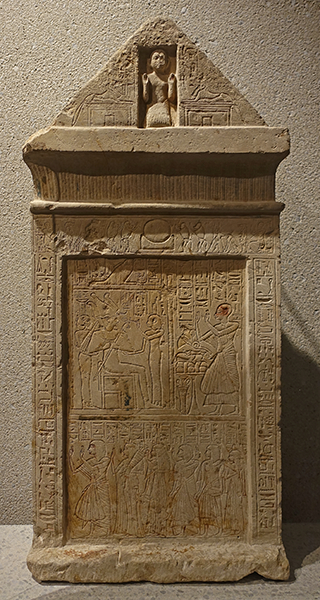
Nineteenth Dynasty: 1 292 BC - 1 187 BC
Seba
Stela of Seba, scribe of the treasury of the god Ptah, circa 1250 BC.
Catalog: Memphis, Limestone, ÄM 7315
Photo: Don Hitchcock 2018
Source: Original, Staatliche Museen zu Berlin, Neues Museum, Germany
Text: © Card at the Staatliche Museen zu Berlin (CC BY-NC-SA 3.0 DE)
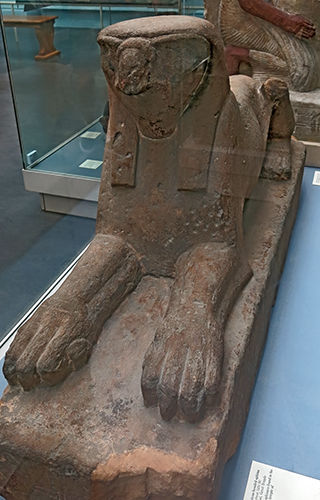
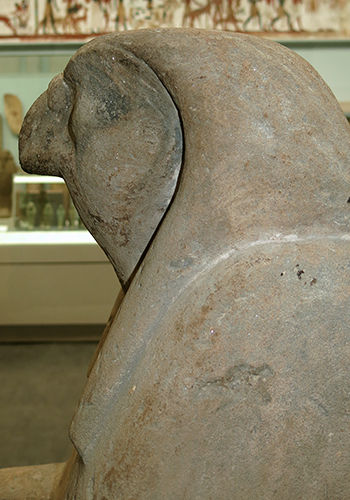
Nineteenth Dynasty: 1 292 BC - 1 187 BC
Sphinx
Sandstone falcon-headed sphinx from the 19th Dynasty, about 1250 BC.
One of a pair of sphinxes found in the Great Hall of the temple of Ramesses II.
Catalog: Abu Simbel, Great Temple, EA13
Photo: Don Hitchcock 2015
Source: Original, British Museum
Text: Card at the British Museum, © Trustees of the British Museum, CC BY-NC-SA 4.0
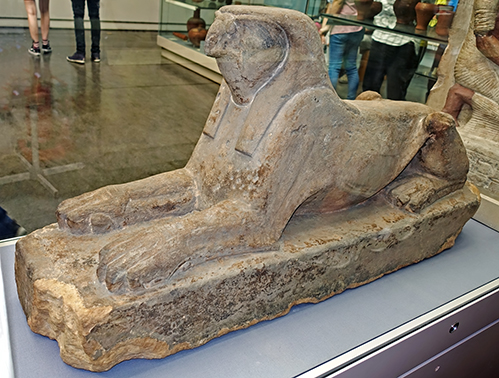
Nineteenth Dynasty: 1 292 BC - 1 187 BC
Sphinx
Sandstone falcon-headed sphinx from the 19th Dynasty, about 1250 BC.
Height 330 mm, length 1065 mm.
The sphinx represents royal power. The composite creature combines the physical strength of the lion with the worldly might of the king, thus creating a creature with terrifying power. A hawk-headed sphinx, also called a gryphon, wearing a royal lappet head-dress, is often shown as a representation of the king treading on his enemies. The statue shown here and a similar one (EA11) were set up near the Temple of Ramesses II at Abu Simbel. It is possible that this hawk-headed sphinx was intended to represent the king's powerful ability to defeat his enemies in the lands south of Egypt.
Catalog: sandstone, Temple of Ramesses II at Abu Simbel, EA13
Photo: Don Hitchcock 2015, 2018
Source: Original, British Museum
Text: Card at the British Museum, © Trustees of the British Museum, CC BY-NC-SA 4.0
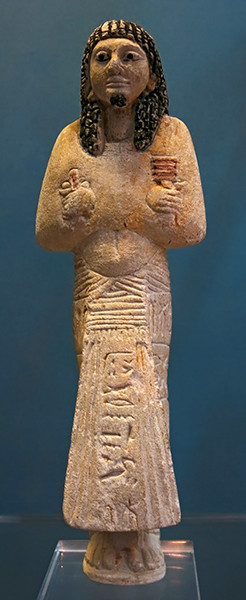
Nineteenth Dynasty: 1 292 BC - 1 187 BC
Shabti of Djehutymose
Limestone, height 242 mm, Hieroglyphic text on apron and kilt.
The Theban Tomb TT32 is located in El-Khokha, part of the Theban Necropolis, on the west bank of the Nile, opposite to Luxor. It is the burial place of the Ancient Egyptian official, Djehutymose.
Djehutymose (or Tuthmose) was a chief steward of Amun and overseer of the granaries of Upper and Lower Egypt during the reign of Ramesses II (19th Dynasty). His wife Esi (Isis) is shown in the hall and the passage of the tomb.
The British museum image of this shabti, in the online catalog, has printed on its base:
(57341)
Shabti of Thutimes, King's scribe and overseer of the cattle, wearing ordinary costume.
Catalog: EA57341
Photo: Don Hitchcock 2015
Source: Original, British Museum
Text: © Card at the Museum, http://www.britishmuseum.org/research/ © Trustees of the British Museum, CC BY-NC-SA 4.0, Wikipedia

Nineteenth Dynasty: 1 292 BC - 1 187 BC
Shabti of Djehutymose
Painted limestone, height 228 mm, ordinary dress.
This shabti shows Djehutymose represented as a living individual, as in a portrait.
Catalog: EA9447
Photo: Don Hitchcock 2015
Source: Original, British Museum
Text: © Card at the Museum, http://www.britishmuseum.org/research/ © Trustees of the British Museum, CC BY-NC-SA 4.0, Wikipedia
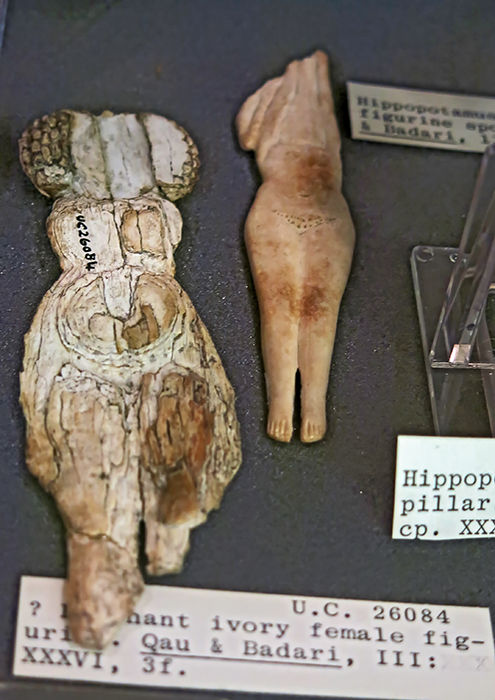
Nineteenth Dynasty: 1 292 BC - 1 187 BC
Female Figurine
Elephant ivory female figurine. Qau & Badari, III:XXXVI, 3f
Ivory female figurine from Qau, Dynasty 19, with no arms and legs below knees missing. Ivory in friable state, face chipped away. Short layered wig carved at side of head on front of figurine.
length 128 mm, width 37 mm
Catalog: III:XXXVI, 3f, U.C. 26084
Photo: Don Hitchcock 2015
Source: Original, Petrie Museum, London, England
Text: Card / online catalogue, the Petrie Museum, © 2015 UCL. CC BY-NC-SA license
Nineteenth Dynasty: 1 292 BC - 1 187 BC
Paser
Sandstone statue of the viceroy Paser presenting a vase with a ram's head, from the 19th Dynasty, about 1250 BC.
From Abu Simbel, the Great Temple.
Found in two pieces in the interior of the temple. Paser, the second viceroy of that name, held office in the middle years of the reign of Ramesses II. He left statues and inscriptions at Abu Simbel and was responsible for repairing structural damage at the Great Temple caused by an earthquake.
Catalog: EA1376
Photo: Don Hitchcock 2015, 2018
Source: Original, British Museum
Text: Card at the British Museum, © Trustees of the British Museum, CC BY-NC-SA 4.0
Nineteenth Dynasty: 1 292 BC - 1 187 BC
Henutmehyt
Wooden inner coffin of Henutmehyt with gilt and glass decoration from the New Kingdom, Thebes / Luxor.
Henutmehyt was the name of a Theban priestess, of Ancient Egypt who lived during the 19th Dynasty, around 1250 BC. The extensive use of gold, and the high quality and detail of her coffin indicates that Henutmehyt was a wealthy woman. On the front of the coffin are the figures of Isis and Nephthys, the protectors of the deceased.
Height 187 cm, width 46 cm.
Catalog: EA48001
Photo: Don Hitchcock 2015, 2018
Source: Original, British Museum
Text: © http://www.britishmuseum.org/research/ and card at the Museum, © Trustees of the British Museum, CC BY-NC-SA 4.0
Additional text: Wikipedia
Nineteenth Dynasty: 1 292 BC - 1 187 BC
Henutmehyt
Closeups, with detail of the wig pattern on the right hand image.
Catalog: EA48001
Photo: Don Hitchcock 2015, 2018
Source: Original, British Museum
Nineteenth Dynasty: 1 292 BC - 1 187 BC
Henutmehyt
Inner mummy-case (left) and inner coffin (right) of Henutmehyt.
The mummiform inner mummy-case was placed inside the inner coffin, directly over the wrapped body. It comprises a mask made of cedarwood, plastered, gilded and with inlaid eyes, and an openwork cover for the legs, made from the wood of the native sycomore fig.
The cover retains its backing of linen, originally coloured purple. It is decorated with a figure of the goddess Nut and scenes of the deceased adoring deities.
( The reddish colouring of the gold on both parts of the mummy-board may be the effect of the oxidation of impurities in the gold, most likely from copper, although red coloured gold may be created by a mixture of 75% gold and 25% copper, so it may have been deliberate - Don )
Henutmehyt was buried in a set of gilded coffins and a gilded mummy board. A wooden shabti box which was painted with a scene showing Henutmehyt adoring two of the canopic deities and receiving food and wine from the goddess Nut. There were four shabti boxes in total, containing shabtis made of both wood and pottery.
A funerary papyrus was included in her burial as well. The text is Spell 100 from the Book of the Dead and is written rather unusually in red and white ink. The papyrus was placed over the outer wrappings of the mummy. These types of texts became more common after the New Kingdom.
Magic bricks made of unbaked mud must have been placed in niches in the burial chamber. Henutmehyt's magic bricks were well preserved. They supported amuletic figures: a Djed pillar, the figure of Anubis, a wooden mummiform figure, and a reed. The bricks themselves were inscribed with magic spells.
A wooden box, painted black and containing fowl wrapped in linen and meat possibly from a goat may also belong to the funerary equipment of Henutmehyt. The box contains enough food for a meal.
Catalog: EA48001
Photo: Don Hitchcock 2015
Source: Original, British Museum
Text: © http://www.britishmuseum.org/research/ and card at the Museum, © Trustees of the British Museum, CC BY-NC-SA 4.0
Additional text: Wikipedia

Nineteenth Dynasty: 1 292 BC - 1 187 BC
Henutmehyt
Inner mummy-case of Henutmehyt, showing the complete mummy-case in the photo on the lower left.
Catalog: EA48001
Photo (upper left, centre): Don Hitchcock 2018
Photo (upper right): Google Arts and Culture Project, © Trustees of the British Museum, CC BY-NC-SA 4.0
Photo (lower left): High resolution stitched image, Don Hitchcock 2018
Source: Original, British Museum
Text: © http://culturalinstitute.britishmuseum.org/ © Trustees of the British Museum, CC BY-NC-SA 4.0
Left: Inner mummy-case and outer coffin of Henutmehyt from the left hand side.
Centre and right: Outer coffin of Henutmehyt shown from the right hand side.
Catalog: EA48001
Photo: Don Hitchcock 2015, 2018
Source: Original, British Museum
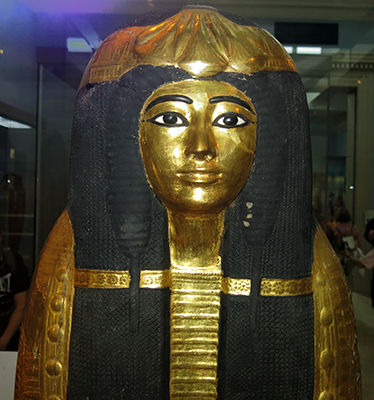
Nineteenth Dynasty: 1 292 BC - 1 187 BC
Henutmehyt
Close up of the face of Henutmehyt on the wooden inner coffin.
Catalog: EA48001
Photo: Don Hitchcock 2015
Source: Original, British Museum
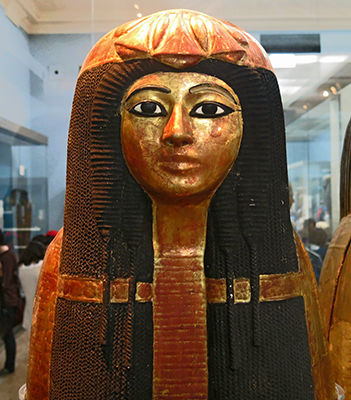
Nineteenth Dynasty: 1 292 BC - 1 187 BC
Henutmehyt
Close up of the face of Henutmehyt on the inner mummy-case.
As noted above, the reddish colour of the gold may be the effect of tarnishing of impurities in the gold, or it may be deliberate by making a gold alloy with 25% copper.
Catalog: EA48001
Photo: Don Hitchcock 2015
Source: Original, British Museum
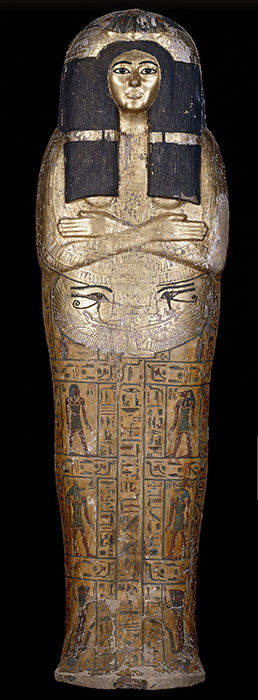
Nineteenth Dynasty: 1 292 BC - 1 187 BC
Henutmehyt
Gilded outer coffin of Henutmehyt.
The coffins of Henutmehyt, originally placed one inside the other, were all anthropoid (human-shaped). Like tomb-statues, this type of coffin was believed to provide the spirit with a substitute body if the mummy should perish. The physical form, with crossed arms, together with the inscriptions and the figures of protective gods and goddesses all emphasised the identification of the dead person with the god Osiris. The implication was that, like him, they might experience resurrection.
Henutmehyt's outer coffin provides a magnificent idealised image of the dead woman, adorned with her full wig. A collar is spread over the breast, and below it hangs a pectoral (chest) ornament flanked by protective wedjat eyes. The sky-goddess Nut spreads her winged arms protectively across the body, and the hieroglyphic text immediately below invokes her.Vertical and horizontal bands divide the remainder of the lid into compartments which are occupied by figures of the Sons of Horus and the goddesses Isis and Nephthys. Further divine figures are painted along the sides of the coffin.
Height 206 cm, width 59 cm.
Catalog: EA48001
Photo (top three): Don Hitchcock 2015, 2018
Photo (left): Google Arts and Culture Project, © Trustees of the British Museum, CC BY-NC-SA 4.0
Source: Original, British Museum
Text: © http://culturalinstitute.britishmuseum.org/ © Trustees of the British Museum, CC BY-NC-SA 4.0
Nineteenth Dynasty: 1 292 BC - 1 187 BC
Henutmehyt
Painted wooden shabti-box containing eight painted shabtis (four in each compartment); Hieroglyphic text on sides and top naming Henutmehyt. The scenes on the sides depict Henutmehyt adoring Osiris and three of the sons of Horus.
In this view, Henutmehyt adores Duamutef and Qebehsenuef, two of the sons of Horus ( Imsety on the left and Duamutef on the right - Don ). The scene on the other side shows the deceased offering a tray of food to Hathor of the Sycamore Tree. This is returned by the goddess, who also supplies a libation (liquid offering), symbolic of purification. Henutmehyt wears the flowing robe, long wig and lotus flower that was fashionable when she lived.
Height 345 mm, width 180 mm, length 335 mm.
Catalog: EA41549
Photo : Don Hitchcock 2015, 2018
Source: Original, British Museum
Text: Card at museum display, http://culturalinstitute.britishmuseum.org/, © Trustees of the British Museum, CC BY-NC-SA 4.0
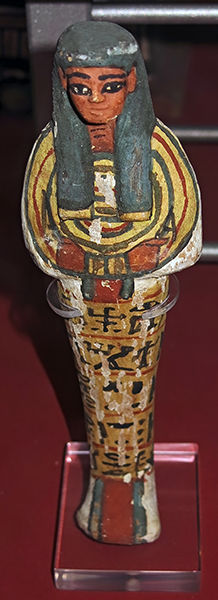
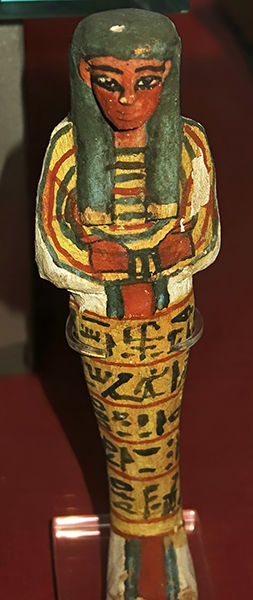
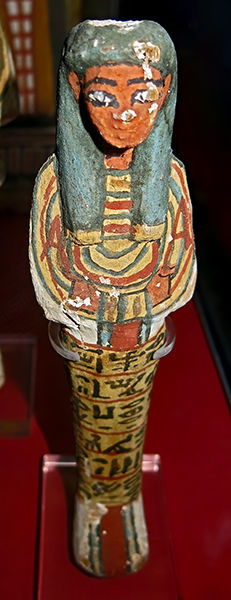
Nineteenth Dynasty: 1 292 BC - 1 187 BC
Henutmehyt
Shabti from the tomb of Henutmehyt.
Catalog: EA41549
Photo : Don Hitchcock 2015
Source: Original, British Museum
Text: Card at museum display, http://culturalinstitute.britishmuseum.org/, © Trustees of the British Museum, CC BY-NC-SA 4.0
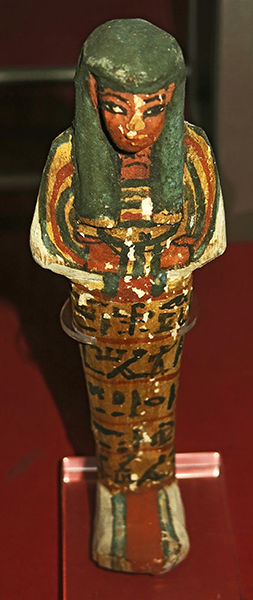
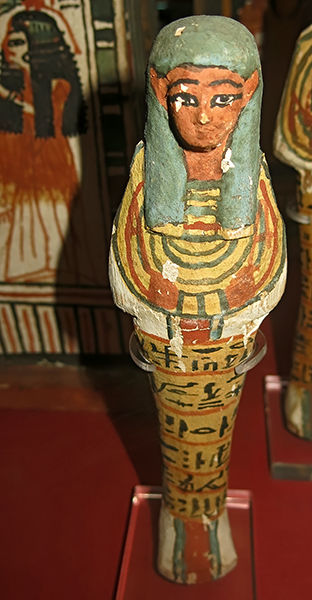
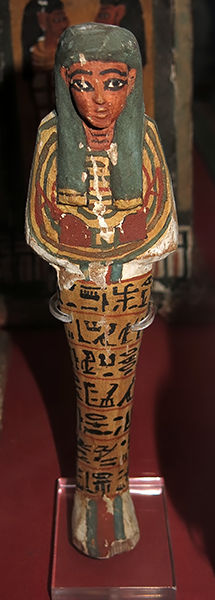
Nineteenth Dynasty: 1 292 BC - 1 187 BC
Henutmehyt
Shabti from the tomb of Henutmehyt.
Catalog: EA41549
Photo : Don Hitchcock 2015
Source: Original, British Museum
Text: Card at museum display, http://culturalinstitute.britishmuseum.org/, © Trustees of the British Museum, CC BY-NC-SA 4.0
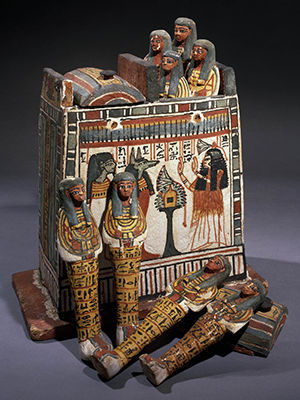
Nineteenth Dynasty: 1 292 BC - 1 187 BC
Henutmehyt
The complete shabti box and the eight shabti.
Catalog: EA41549
Photo : © Trustees of the British Museum, CC BY-NC-SA 4.0
Source: Original, British Museum
Text: Card at museum display, http://culturalinstitute.britishmuseum.org/, © Trustees of the British Museum, CC BY-NC-SA 4.0
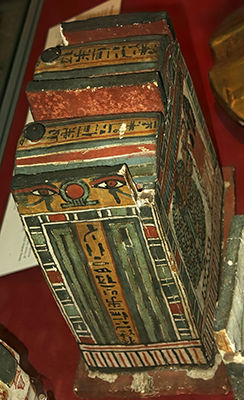
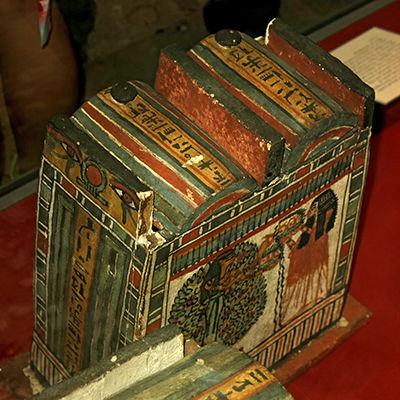
Nineteenth Dynasty: 1 292 BC - 1 187 BC
Henutmehyt
On the other side of the box she receives food and water from a goddess (probably Nut) in a tree. ( note the difference of opinion by scholars as to the identity of the goddess, and whether Henutmehyt is giving or receiving (or both) food and water - Don )
This box, one of four made for Henutmehyt is in the form of two conjoined shrines, although it contains only one internal cavity. The four sides are inscribed and painted with scenes of a funerary character: on the front, Henutmehyt adores Duamutef and Qebehsenuef, two of the sons of Horus (Imsety and Duamutef on the left and right), and on the back she receives food and water from a goddess (probably Nut) in a tree.
Catalog: EA41549
Photo : Don Hitchcock 2015
Source: Original, British Museum
Text: Card at museum display, http://culturalinstitute.britishmuseum.org/, © Trustees of the British Museum, CC BY-NC-SA 4.0
Additional text: Taylor (2010)

Nineteenth Dynasty: 1 292 BC - 1 187 BC
Henutmehyt
This image, a version of the vignette of spell 59 in of the Book of the Dead, is common on shabti boxes, perhaps because the shabtis' agricultural labours were a stage in the process of procuring food for the dead.
Early shabtis were stored individually in the tomb inside miniature coffins, but in the New Kingdom these were superseded by specially designed wooden boxes, the shape of which reproduced the form of a shrine. The adoption of this type of container probably reflects the shabti's character as a hypostasis (the underlying or essential part of anything as distinguished from attributes; substance, essence, or essential principle) of its owner, who was supposed to have acquired divine attributes after death. This box, one of four made for Henutmehyt (see cat nos. 15, 38, 54 and 134 ) is in the form of two conjoined shrines, although it contains only one internal cavity.
The four sides are inscribed and painted with scenes of a funerary character: on the front, Henutmehyt adores Duamutef and Qebehsenuef, two of the sons of Horus (Imsety and Duamutef on the left and right), and on the back she receives food and water from a goddess (probably Nut)in a tree. This image, a version of the vignette of spell 59 in of the Book of the Dead, is common on shabti boxes, perhaps because the shabtis' agricultural labours were a stage in the process of procuring food for the dead.
Catalog: EA41549
Photo : Don Hitchcock 2018
Source: Original, British Museum
Text: Card at museum display, http://culturalinstitute.britishmuseum.org/, © Trustees of the British Museum, CC BY-NC-SA 4.0
Additional text: Taylor (2010)
The shabti figure emerged as an important item of funerary equipment in the early Middle Kingdom. A spell to activate these images as substitutes to work on behalf of the dead is first attested in the Coffin Texts, as spell 472.
In the New Kingdom this text was incorporated into the book of the dead as spell 6, and was often inscribed on the body of the figure. This group, EA41549, is part of a set of forty shabtis that was provided for the Chantress of Amun, Henutmehyt.
They are typical of their period in representing the owner holding agricultural tools for use in the process of food production in the afterlife. An abbreviated version of the spell is written on the body.
Originally each person possessed only one or two shabtis, but during the New Kingdom the number gradually increased, the forty belonging to Henutmehyt reflect not only this trend, but also her high status.
Text above: Taylor (2010)
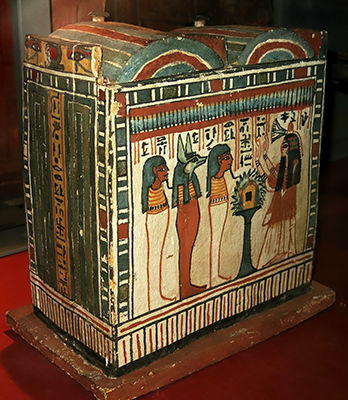
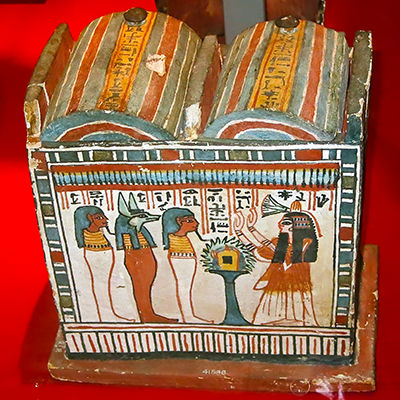
Nineteenth Dynasty: 1 292 BC - 1 187 BC
Henutmehyt
Another shabti box made for Henutmehyt.
This painted wooden shabti-box contained twelve painted shabtis (six in each compartment). There is hieroglyphic text on the sides and top naming Henutmehyt.
Dimensions of the box: Height 350 mm, length 340 mm, width 192 mm, weight 2 kilograms.
Catalog: EA41548
Photo : Don Hitchcock 2015
Source: Original, British Museum
Text: Card at museum display, http://culturalinstitute.britishmuseum.org/, © Trustees of the British Museum, CC BY-NC-SA 4.0
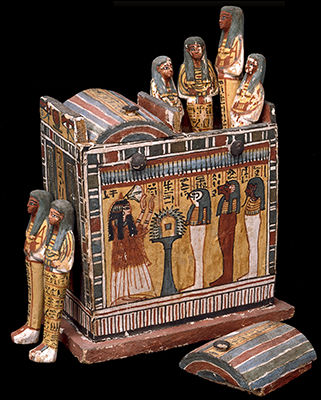
Nineteenth Dynasty: 1 292 BC - 1 187 BC
Henutmehyt
Shabti box made for Henutmehyt.
During the New Kingdom (about 1550-1070 BC), the number of shabtis to be included in a tomb increased considerably. The miniature coffins in which they had been kept became large boxes, decorated with funerary scenes. One of the scenes on the box of Henutmehyt shows her adoring the sons of Horus, who protected the internal organs of the deceased. This motif is perhaps more suited to the decoration of canopic chests.
Faience is the material most commonly associated with shabti figures, though Spell 6 of the Book of the Dead specifies that they should be made of wood, as these are. Although all the figures are similar, there are small differences in details such as the treatment of the necklaces and bracelets. Some are inscribed with the full version of the spell to activate the figures to carry out agricultural work, while others have only an abbreviated version.
Dimensions of the box: height 350 mm, width 192 mm, length 340 mm, weight 2 kg.
Catalog: EA41548
Photo : © Trustees of the British Museum, CC BY-NC-SA 4.0
Source: Original, British Museum
Text: © Trustees of the British Museum, CC BY-NC-SA 4.0, http://culturalinstitute.britishmuseum.org/
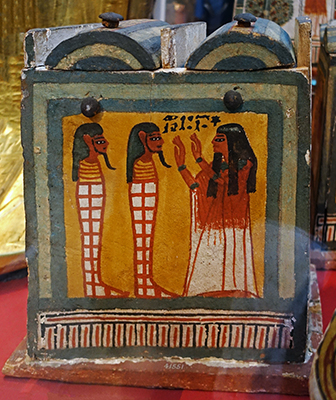
Nineteenth Dynasty: 1 292 BC - 1 187 BC
Henutmehyt
Another painted wooden shabti-box made for Henutmehyt containing ten shabtis (five in each compartment)
Dimensions of the box: Height 333 mm, length 330 mm, width 173 mm.
Catalog: EA41551
Photo : Don Hitchcock 2018
Source: Original, British Museum
Text: Card at museum display, http://culturalinstitute.britishmuseum.org/, © Trustees of the British Museum, CC BY-NC-SA 4.0
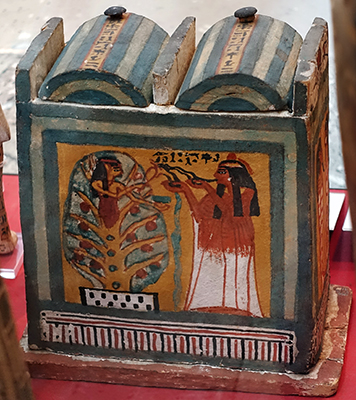
Nineteenth Dynasty: 1 292 BC - 1 187 BC
Henutmehyt
Painted wooden shabti-box made for Henutmehyt containing ten shabtis (five in each compartment)
This side shows Henutmehyt receiving food and drink from a goddess who stands within the branches of a tree.
Catalog: EA41551
Photo : Don Hitchcock 2018
Source: Original, British Museum
Text: Card at museum display, http://culturalinstitute.britishmuseum.org/, © Trustees of the British Museum, CC BY-NC-SA 4.0
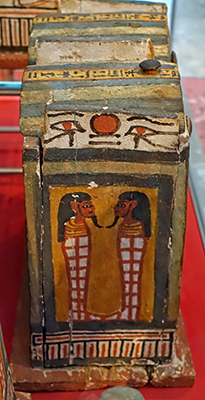
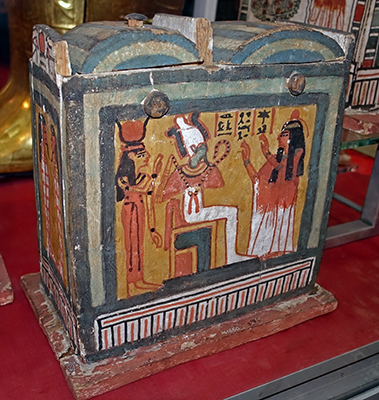
Nineteenth Dynasty: 1 292 BC - 1 187 BC
Henutmehyt
Painted wooden shabti-box made for Henutmehyt containing ten shabtis (five in each compartment)
( here Henutmehyt is shown in the right hand image adoring Osiris, with Hathor behind Osiris - Don )
Dimensions of the box: height 336 mm, length 342 mm, width 203 mm.
Catalog: EA41550
Photo : Don Hitchcock 2018
Source: Original, British Museum
Text: Card at museum display, http://culturalinstitute.britishmuseum.org/, © Trustees of the British Museum, CC BY-NC-SA 4.0
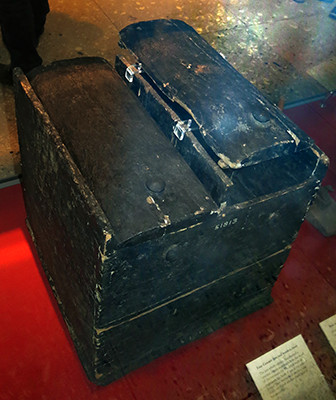
Nineteenth Dynasty: 1 292 BC - 1 187 BC
Henutmehyt
This large black-varnished wooden chest of sycomore fig wood with two lids was made to hold the four canopic jars of Henutmehyt.
The canopic jars contain a bundle of organs within a coffinette.
Height 482 mm (chest), length 432 mm (chest), height 406 mm (each jar)
Catalog: EA51813
Photo : Don Hitchcock 2015
Source: Original, British Museum
Text: Card at museum display, http://culturalinstitute.britishmuseum.org/, © Trustees of the British Museum, CC BY-NC-SA 4.0

Nineteenth Dynasty: 1 292 BC - 1 187 BC
Henutmehyt
Canopic jars of Henutmehyt.
The canopic jars contain a bundle of organs within a coffinette.
Height 406 mm (each jar)
Catalog: EA51813
Photo : Don Hitchcock 2018
Source: Original, British Museum
Text: Card at museum display, http://culturalinstitute.britishmuseum.org/, © Trustees of the British Museum, CC BY-NC-SA 4.0
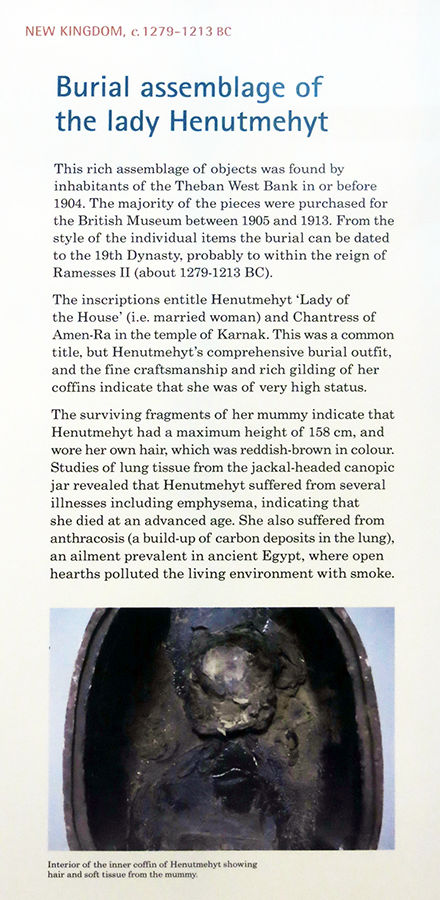
Nineteenth Dynasty: 1 292 BC - 1 187 BC
Henutmehyt
Text of the poster at left:
New Kingdom, circa 1279 BC - 1213 BC.
Burial assemblage of the lady Henutmehyt
This rich assemblage of objects was found by inhabitants of the Theban West Bank in or before 1904. The majority of the pieces were purchased for the British Museum between 1905 and 1913. From the style of the individual items the burial can be dated to the 19th Dynasty, probably to within the reign of Ramesses II (about 1279-1213 BC).
The inscriptions entitle Henutmehyt 'Lady of the House' (i.e. married woman) and Chantress of Amen-Ra in the temple of Karnak. This was a common title, but Henutmehyt's comprehensive burial outfit, and the fine craftsmanship and rich gilding of her coffins indicate that she was of very high status. The surviving fragments of her mummy indicate that Henutmehyt had a maximum height of 158 cm, and wore her own hair, which was reddish-brown in colour.
Studies of lung tissue from the jackal-headed canopic jar revealed that Henutmehyt suffered from several illnesses including emphysema, indicating that she died at an advanced age. She also suffered from anthracosis (a build-up of carbon deposits in the lung), an ailment prevalent in ancient Egypt, where open hearths polluted the living environment with smoke.
Photo on the poster: Interior of the inner coffin of Henutmehyt showing hair and soft tissue from the mummy.
Photo: Poster, British Museum
Rephotography: Don Hitchcock 2015
Text: Poster, © Trustees of the British Museum, CC BY-NC-SA 4.0
Magical Bricks
During the New Kingdom (about 1550-1070 BC), magic bricks with sockets were placed in tombs, in order to protect the deceased from the enemies of the god Osiris. They were positioned at the four cardinal points of the tomb (north, east, south and west). An amulet was set in each socket, standing so it faced the opposite wall. Each brick was inscribed with a portion of Spell 151 of the Book of the Dead. This spell identifies the deceased with Osiris, Isis and Nephthys.Text above: Taylor (1999)
The four sons of Horus offer their protection; the amuletic figures of the magic bricks specifying the ways in which they will defend the deceased from attack. The brick beside the west wall contains a faience djedpillar, representing the backbone of Osiris. It was thus an amulet which promoted stability and endurance. The brick by the east wall is surmounted by a clay figure of the jackal god Anubis. He presided over the mummification process, and protected the necropolis (cemetery). The mummiform figure by the north wall is identified in the spell as a shabti. This amulet offers to perform agricultural tasks on behalf of the deceased. The brick by the south wall contains a reed to hold a torch, burning the path of those who wish the deceased harm.
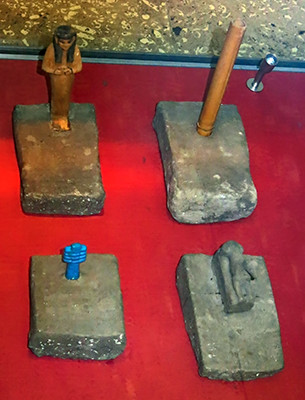
Nineteenth Dynasty: 1 292 BC - 1 187 BC
Henutmehyt
All bricks are of unfired clay, only practical when they are in the sealed environment of a dry tomb, not exposed to the weather.
EA41544: Clay magical brick with a reed. Height 40 mm (brick), width 108 mm, length 165 mm. Reed height 195 mm.
EA41545: Clay magical brick with a representation of Anubis. Height 25 mm, width 92 mm, length 145 mm
EA41546: Wooden shabti on a brick, 145 mm high.
EA41547: Clay magical brick with a djed-pillar amulet, height 43 mm (brick), width 95 mm, length 110 mm. Amulet height 58 mm.
Catalog: EA41544, EA41545, EA41546, EA41547
Photo : Don Hitchcock 2015
Source: Original, British Museum
Text: Card at museum display, http://culturalinstitute.britishmuseum.org/, © Trustees of the British Museum, CC BY-NC-SA 4.0
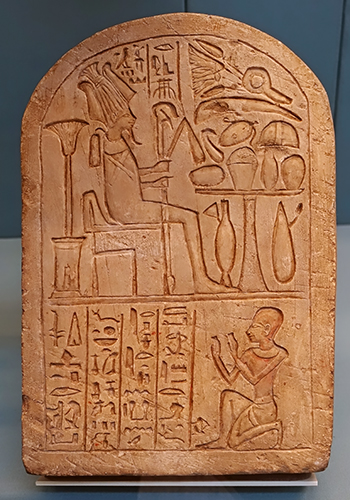
Nineteenth Dynasty: 1 292 BC - 1 187 BC
Amunerhatef
Limestone stela of Amunerhatef showing adoration of Osiris.
On this stela from a chapel at Abydos, the god Osiris is depicted seated before a table of offerings. The hieroglyphic text in the lower section contains Amunerhatef's request to the god to provide funerary offerings for his own ka.
This Limestone stela isw inscribed with 2 registers of hieroglyphs mentioning Imn-r-hat-f, circa 1 250 BC.)
( note that this type of stela makes more sense to modern viewers if it is read from top to bottom as though it were left to right - Don )
Height: 280 mm, width 190 mm.
Catalog: Abydos, EA345
Photo: Don Hitchcock 2018
Source: Original, British Museum
Text: Card with the display at the British Museum, http://www.britishmuseum.org/, © Trustees of the British Museum, CC BY-NC-SA 4.0
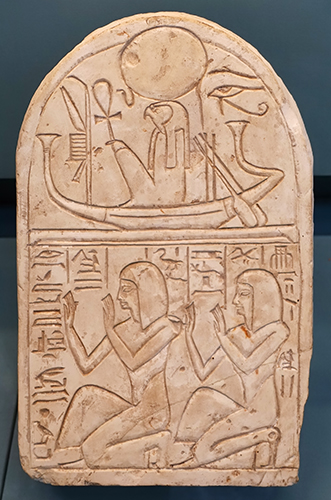
Nineteenth Dynasty: 1 292 BC - 1 187 BC
Wenenkhu
Limestone stela of Wenenkhu
Limestone stela of workman Wenenkhu: a round-topped stela divided into two registers with figures carved in shallow sunk relief and incised texts. In the upper register the god Ra is depicted in the solar boat. In the lower register the workman Wennekhu and his son Penpakhenty,
P(ʒ)-n-pʒ-ḫnty, kneel facing left with their arms raised in adoration. The stela has a large crack in the lower right portion and is slightly chipped in places. There are traces of red paint on the body of Penpakhenty.
Dimensions: Height 353 mm, width 235 mm.
Catalog: Painted limestone, Deir el-Medina (Thebes), EA1248
Photo: Don Hitchcock 2018
Source: Original, British Museum
Text: Card with the display at the British Museum, http://www.britishmuseum.org/, © Trustees of the British Museum, CC BY-NC-SA 4.0

Nineteenth Dynasty: 1 292 BC - 1 187 BC
Painted Stela
Painted limestone stela showing adoration of deceased members of the 18th Dynasty royal family.
In the upper scene the dedicator adores the deities Osiris, Isis and Horus. Below, he worships King Amenhotep I, and the queens Ahmose-Nefertari and Sitkamose.
These three individuals, particularly the first two, were the focus of popular devotion in the late New Kingdom.
Height 435 mm, width 300 mm.
Catalog: Painted limestone, Abydos, EA297
Photo: Don Hitchcock 2018
Source: Original, British Museum
Text: Card at museum display, https://www.britishmuseum.org/, © Trustees of the British Museum, CC BY-NC-SA 4.0
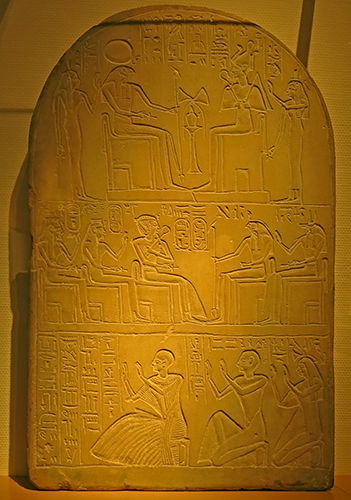
Nineteenth Dynasty: 1 292 BC - 1 187 BC
Rama
The Stele of Rama, Limestone, Thebes / Luxor site, ca 1225 -1200 BC (19th Dynasty)
Rama was the high priest of Amun in the Karnak Temple. He is pictured below left in an attitude of prayer.
Above in the centre are the seated gods Re-Harakhty (with a falcon head, one of the forms of the god Horus) and Osiris. On the far left is the goddess Isis, with the goddess Maat on the far right.
Seated in the middle are the gods Horus (with the head of a falcon) and Anubis (with a jackal head) on the right, with Pharaoh Amenhotep and the queens Ahmes-Nefertiti and Anhotep on the left. These deified rulers were considered the guardians of the Theban cemetery.
Photo: Don Hitchcock 2014
Source and text: Original, Rijksmuseum van Oudheden, National Museum of Antiquities, Leiden.
Additional text: Wikipedia
Nineteenth Dynasty: 1 292 BC - 1 187 BC
Shabti box of Pa-ni-Rutenutet
To store the so-called shabtis, which were included with the deceased in the tomb as his deputies to take over the otherworldly services, wooden boxes were often used. The painted wooden box of Pa-ni-renenutet, in which there were still some shabtis, has a rectangular plan as shown in the series of photographs below. The walls are slightly sloped. Four high partitions are added over the two narrow walls and over the box to divide it into three equal sections. Three domed lids, each with a round knob, can be seen between the four partitions. Three more round buttons are attached to one of the longitudinal walls. They serve to tie and seal the lid. The shape of the shabti box corresponds to three adjacent, Egyptian chapels.
Catalog: Thebes West, Wood, stuccoed, painted, ÄM 733
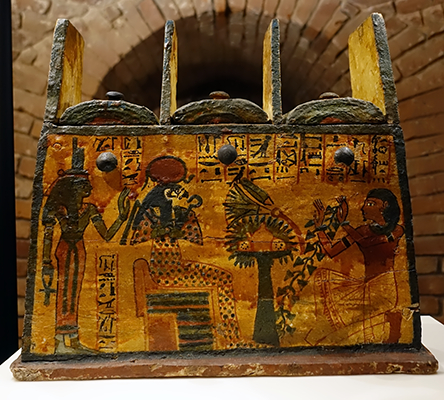
Nineteenth Dynasty: 1 292 BC - 1 187 BC
Shabti box of Pa-ni-Rutenutet
During the reign of Seti II, 1 203 BC - 1 197 BC.
Dimensions: 360 x 410 x 180 mm.
Depicted on one long side (as at left) of the box is the kneeling, adoring Pa-en-renenutet in front of Re-Harachten and Isis.
Photo: Don Hitchcock 2018
Source: Original, Staatliche Museen zu Berlin, Neues Museum, Germany
Text: © Card at the Staatliche Museen zu Berlin, http://www.smb-digital.de/, (CC BY-NC-SA 3.0 DE)
Additional text: I.Liao
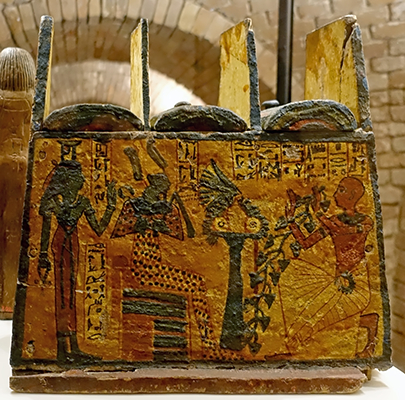
Nineteenth Dynasty: 1 292 BC - 1 187 BC
Shabti box of Pa-ni-Rutenutet
On the other side one can see the deceased kneeling in front of a sacrificial table, who is adoring the enthroned Osiris in the company of Nephthys.
( Nephthys, sister of Isis, can be distinguished by the shallow bowl atop her headdress - Don )
Between the hands of the worshiper in the two scenes, one ivy tendril hangs down, the green colour of which resembles the skin colour of the four deities depicted, and symbolises rejuvenation or resurrection.
Photo: Don Hitchcock 2018
Source: Original, Staatliche Museen zu Berlin, Neues Museum, Germany
Text: © Card at the Staatliche Museen zu Berlin, http://www.smb-digital.de/, (CC BY-NC-SA 3.0 DE)
Additional text: I.Liao
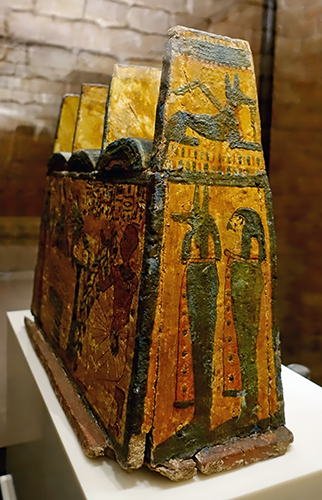
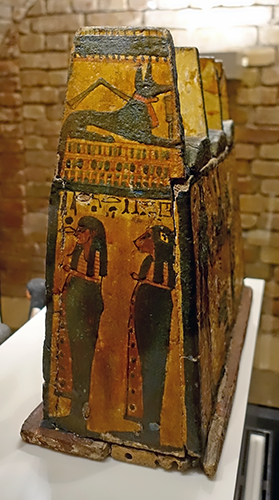
Nineteenth Dynasty: 1 292 BC - 1 187 BC
Shabti box of Pa-ni-Rutenutet
On one of the short walls, two mummiform sons of Horus are shown below a representation of a jackal lying on a shrine.
( On the other short wall, the gods Anubis and Horus are shown below a representation of a jackal lying on a shrine - Don )
According to the inscriptions, Pa-ni-renenutet (literally, 'The one belonging to the serpent goddess Renenutet') was a supervisor of the porters in the Amun temple. The mention of Thebes West in an inscription, however, indicates that he may not have worked in the great Karnak Temple in Thebes, but in one of the smaller Amun shrines on the west bank.
(L. Liao)
Photo: Don Hitchcock 2018
Source: Original, Staatliche Museen zu Berlin, Neues Museum, Germany
Text: © Card at the Staatliche Museen zu Berlin, http://www.smb-digital.de/, (CC BY-NC-SA 3.0 DE)
Additional text: I.Liao
Catalog: Thebes West, Wood, stuccoed, painted, ÄM 733
Photo: Don Hitchcock 2018
Source: Original, Staatliche Museen zu Berlin, Neues Museum, Germany
Text: © Card at the Staatliche Museen zu Berlin, http://www.smb-digital.de/, (CC BY-NC-SA 3.0 DE)
Additional text: I.Liao
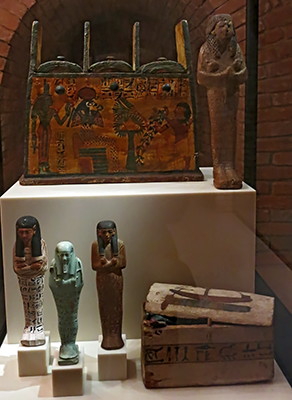
Nineteenth Dynasty: 1 292 BC - 1 187 BC
Shabtis
These are shabtis of the woman Tamit (right lower), the priest Wah-ib-Rê-em-akhet (centre) and Khonsu (left), see larger images below.
Since the Middle Kingdom, small statuettes - mostly in the form of mummies - have been placed in the graves as representatives to meet the needs of the grave owner on the other side. They were the 'answerers' who, according to a death book saying that is often on the front of the statuettes, should respond to divine work requests and carry them out accordingly.
On the right is a Ushabti box with ushabtis made by mass production, from the 26th Dynasty, 746 - 525 BC. Wood, Faience.
Catalog: Wood, Faience and Limestone, ÄM 4652, ÄM 937, ÄM 10193
Photo: Don Hitchcock 2015
Source: Original, Staatliche Museen zu Berlin, Neues Museum, Germany
Text: © Card at the Staatliche Museen zu Berlin, http://www.smb-digital.de/, (CC BY-NC-SA 3.0 DE)
Additional text: Wikipedia
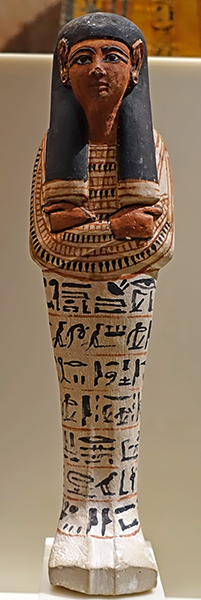
Nineteenth Dynasty: 1 292 BC - 1 187 BC
Shabti of Khonsu
The painted shabti of Khonsu / Chonsu, made of limestone, comes from the tomb of Sennedjem (TT 1) in Deir el-Medine. It is mummy-shaped, adorned with a long, black wig and with a wide neck collar with stylized, floral motifs. His arms are crossed over his chest. He holds a hoe and shears in his half-sculpted hands, which are framed with black lines. Additional cords can be seen on the shoulders, which belong to a mesh-like grain sack. Since the New Kingdom, it was customary to give the shabhtis the necessary tools for field work.
In addition, seven lines of hieroglyphic inscription are written in black ink on the mummy-shaped body. The inscription names the official of the Theban necropolis named Chonsu, the son of Sennedjem from the 19th dynasty. Together with other family members, Chonsu was buried in his father's grave.
(I. Liao, via http://www.smb-digital.de/)
( note that there was another Khonsu at much the same time who was First Prophet of Menkheperre (Thutmose III), during the reign of Ramesses II in the 19th Dynasty. He is attested with two wives in his tomb TT31. His first wife Ruia was the mother of the High Priest of Sobek Usermontu and other children. His second wife May was mother to the Stablemaster Usermontu and the Second Prophet of Menkheperre Khaemwaset and others. Khonsu is also the name of the Ancient Egyptian god of the moon. His name means 'traveller', and this may relate to the nightly travel of the moon across the sky - Don )
Limestone, painted.
Dimensions: 235 x 60 x 46 mm.
Catalog: Shabti of Chonsu, Deir el-Medine (Egypt / Upper Egypt / Thebes West), TT 1 (Sennedjem) (tomb), ÄM 10193
Photo: Don Hitchcock 2018
Source: Original, Staatliche Museen zu Berlin, Neues Museum, Germany
Text: © Card at the Staatliche Museen zu Berlin, http://www.smb-digital.de/, (CC BY-NC-SA 3.0 DE)
Additional text: Wikipedia

Nineteenth Dynasty: 1 292 BC - 1 187 BC
Shabti of the woman Tamit
Catalog: Wood, painted, ÄM 4652
Photo: Don Hitchcock 2018
Source: Original, Staatliche Museen zu Berlin, Neues Museum, Germany
Text: © Card at the Staatliche Museen zu Berlin, http://www.smb-digital.de/, (CC BY-NC-SA 3.0 DE)

Nineteenth Dynasty: 1 292 BC - 1 187 BC
Shabti with a Ba-bird
The Ba-bird was one of the three souls of the deceased.
( note that this is not the standard form for a shabti, although there are remnants of what look like tools in the hands of the person depicted. It looks more like a tiny model of an anthropomorphic mummy case, depicting the deceased being covered/protected by the Ba-bird - Don )
Dimensions: 390 x 105 x 110 mm (including base).
Catalog: Wood, painted, Saqqara (necropolis), ÄM 808
Photo: Don Hitchcock 2018
Source: Original, Staatliche Museen zu Berlin, Neues Museum, Germany
Text: © Card at the Staatliche Museen zu Berlin, http://www.smb-digital.de/, (CC BY-NC-SA 3.0 DE)

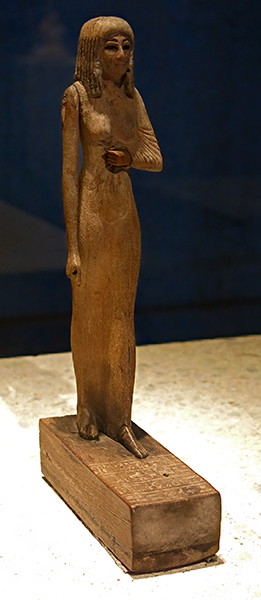
Nineteenth Dynasty: 1 292 BC - 1 187 BC
Lady Nehi
Standing-striding figure of Lady Nehi, donated (?) by her husband Khonsu.
( I have been unable to positively identify her husband Khonsu in the literature, it appears to have been a common name at the time - Don )
The statuette of Lady Nehi is one of the most beautiful female figurines in the New Kingdom. She was probably holding a small formal linear bouquet in her left hand.
This is lost, as is the lotus flower (or a cloth) which she held in the right.
The elongated limbs and the delicate physique show Nehi as a very young woman. She wears a long, narrow, smooth undergarment and over it a kind of pleated coat, which was knotted under the bust and coquettishly covered the left arm. The hairstyle is unusual. Perhaps the statue shows her own shoulder-length hair. Included is a (painted) neck collar and earrings as accessories. The transparent clothing increases the modelling of the body with a fine erotic aura. This sculpture has lost its paint and the original coloured glass inlays for wig, eyes and earrings.
From: Kischkewitz, Hannelore, in: Priese, Karl-Heinz, Egyptian Museum Berlin, Museum Island Berlin, Mainz 1991, p. 152, via http://www.smb-digital.de/
From the reign of Ramses II, 1 279 BC - 1 213 BC.
Dimensions: 24 x 5 x 12 cm
Catalog: Wood, painted, Memphis / Saqqara, ÄM 4651
Photo: Don Hitchcock 2015
Source: Original, Staatliche Museen zu Berlin, Neues Museum, Germany
Text: © Card at the Staatliche Museen zu Berlin, http://www.smb-digital.de/, (CC BY-NC-SA 3.0 DE)
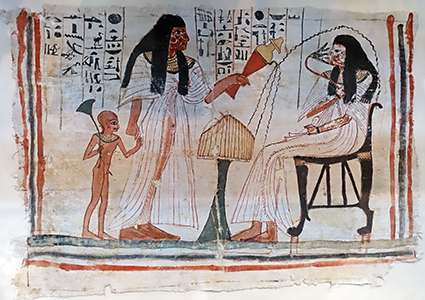
Nineteenth/Twentieth Dynasty: 1 292 BC - 1 077 BC
Funerary Cloth
Painted funerary cloth of a woman named Asetnefret.
The dead woman, seated at right, sniffs a lotus flower while receiving a libation from her daughter, who holds the hand of her son Penpara.
Cloths of this type were placed over the breast of the mummy or coffin.
Catalog: Provenance unknown, EA65347
Photo: Don Hitchcock 2018
Source: Original, British Museum
Text: Card with the display at the British Museum, © Trustees of the British Museum, CC BY-NC-SA 4.0
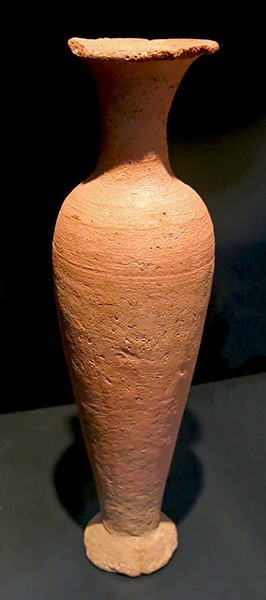
Nineteenth/Twentieth Dynasty: 1 292 BC - 1 077 BC
Libation Vessel
Vessels with this characteristic shape were used for pouring libations, circa 2 635 - 2155 BC.
Catalog: Ceramic
Photo: Don Hitchcock 2015
Source and text: Badisches Landesmuseum Karlsruhe Germany
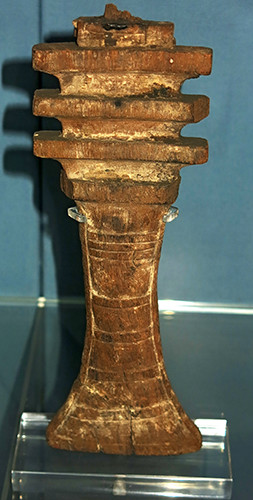
Nineteenth/Twentieth Dynasty: 1 292 BC - 1 077 BC
Djed pillar
From the Valley of the Kings
The Djed pillar embodied the concepts of endurance and stability. It also came to be interpreted as the backbone of Osiris, and was frequently represented in funerary art in place of the god himself.
Catalog: EA2086
Photo: Don Hitchcock 2015
Source: Original, British Museum
Text: Card with the display at the British Museum, http://www.britishmuseum.org/, © Trustees of the British Museum, CC BY-NC-SA 4.0
Nineteenth - Twentieth Dynasty: 1 292 BC - 1 077 BC
Crocodile: the god Sebek-Re
Height 67 mm, length 182 mm, width 60 mm.
Catalog: Tamarisk wood, limestone base, Deir el-Medinah, Sully, Rez-de-chaussée, Le Nil, Salle 336, Vitrine 2: le Nil, E 16358
Photo: Don Hitchcock 2015, 2018
Source: Original, Musée du Louvre
Text: © Musée du Louvre, http://metmuseum.org/, http://cartelfr.louvre.fr/cartelfr/visite?srv=car_not_frame&idNotice=19302&langue=fr
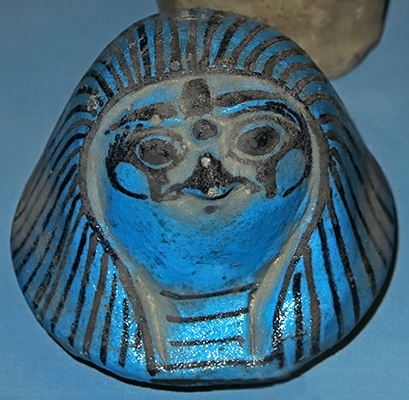
Nineteenth - Twentieth Dynasty: 1 292 BC - 1 077 BC
Faience Canopic Jar lid
Height 120 mm, width 110 mm.
Blue glazed faience falcon-headed Canopic jar lid, depicting Qebhsenuef, with black detail.
Circa 1 295 BC - 1 070 BC.
Catalog: Faience Canopic Jar lid, Provenance unknown, circa 1 295 BC - 1 070 BC, EA57339
Photo: Don Hitchcock 2015
Source: Original, British Museum
Text: Card with the display at the British Museum, https://www.britishmuseum.org/, © Trustees of the British Museum, CC BY-NC-SA 4.0
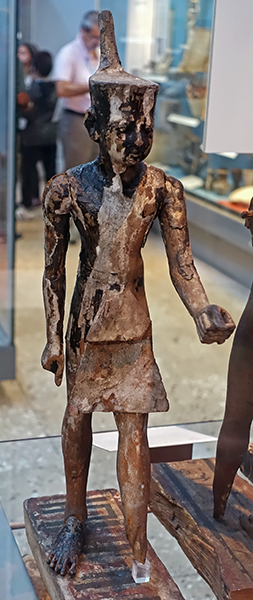
19th - 20th Dynasty, 1 292 BC - 1 077 BC
King wearing the Red Crown
Wooden figure of a king wearing the red crown and a bipartite apron. Left hand raised to hold a missing staff, left foot lost. Painted decoration on top of the plinth. Very worn plaster and resin coating. From the Valley of the Kings.
Dimensions: Height 570 mm, length (plinth) 298 mm, width 135 mm.
A pair of gilded wooden statuettes representing the king wearing the crown of Upper and Lower Egypt was found in the tomb of Tutankhamun. This example probably formed part of a similar pair from the tomb of a later ruler. The outstretched hand probably originally grasped a staff. The figure is made from Tamarisk wood. The base is a 19th century restoration, made from a fragment of ancient wood.
Catalog: wood, plaster, resin, painted, Biban el-Muluk (Valley of the Kings - Thebes), EA11490
Photo: Don Hitchcock 2018
Source: Original, British Museum
Text: Card at museum display, http://www.britishmuseum.org/, © Trustees of the British Museum, CC BY-NC-SA 4.0
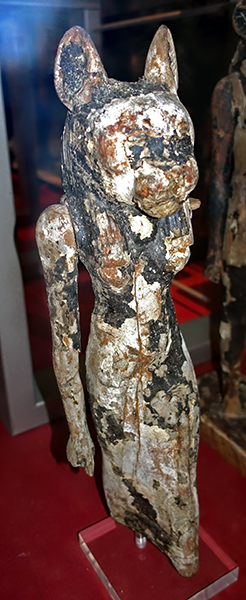
19th - 20th Dynasty, 1 292 BC - 1 077 BC
Cat Goddess
Wooden figure of a cat headed goddess, Bastet, covered with a bitumenous substance, from the Valley of the Kings.
The legs and left arm are missing.
Dimensions: Height 459 mm, length 100 mm, width 125 mm.
Catalog: Valley of the Kings, EA60254
Photo: Don Hitchcock 2018
Source: Original, British Museum
Text: Card at museum display, https://www.britishmuseum.org/, © Trustees of the British Museum, CC BY-NC-SA 4.0
19th - 20th Dynasty, 1 292 BC - 1 077 BC
Fan
Fan-handle, with modern ostrich feathers attached. A plain wooden handle is topped with a finely carved terminal. This bears a carved depiction of the face of Hathor, with cow ears. The top of the terminal is pierced with holes to take the feathers.
Height 70 millimetres, length 160 mm (handle only), thickness 30 mm, width 95 mm (handle only), width 500 mm total.
Catalog: wood, ivory, ostrich feathers, Thebes, EA20767
Photo: Don Hitchcock 2018, 2015
Source: Original, British Museum
Text: © http://www.britishmuseum.org/research/ and card at the Museum, © Trustees of the British Museum, CC BY-NC-SA 4.0

19th - 20th Dynasty, 1 292 BC - 1 077 BC
Child God Horus
Figurine of the god Hor / Horus as a child, Harpocrates.
Black and gold bronze, modern base. Black bronzes are alloys of copper, silver and gold whose patina highlights metal inlays of different colours.
The nails and the child's head are inlaid with gold. Horus must have been sitting on the lap of his mother Isis, turned towards her breast.
Harpocrates seated, nude, with the sidelock of youth, head turned to the right.
The sidelock of youth (also called a Horus lock, Prince's lock, Princess' lock, or side braid) was an identifying characteristic of the child in Ancient Egypt. It symbolically indicates that the wearer is a legitimate heir of Osiris. The sidelock was used as a divine attribute from at least as early as the Old Kingdom. It is usually depicted as a braid rather than a lock, with its end twisted into a spiral.
Height: 142 mm.
The child-god Harpocrates was a popular subject for terracotta figurines in Graeco-Roman Egypt. A juvenile form of Horus, the name Harpocrates is derived from the Egyptian Hor-Pa-Khered ('Horus-the-child')
Harpocrates was the god of silence, secrets and confidentiality in the Hellenistic religion developed in Ptolemaic Alexandria (and also an embodiment of hope, according to Plutarch). Harpocrates was adapted by the Greeks and Romans from the Egyptian child god Hor.
The figure is of a male deity in a seated position. It depicts the god Horus, son of Osiris and Isis, as a child. The figurine was possibly originally part of a larger figurine group, being seated on his mother, Isis', lap.
Horus is the most important of the avian deities who takes on so many forms and is depicted so differently in various inscriptions that it is nearly impossible to distinguish the true Horus. Horus is mostly a general term for a great number of falcon deities. However, the name 'Horus' will usually be found to designate either the older god of the first five, or the son of Isis and Osiris who defeated his uncle Set and restored order to the land.
Catalog: Aile Sully, Room 334, Materials and Techniques, Vitrine 2, E 7735
Photo: Don Hitchcock 2018
Source and text: Original, Louvre Museum, Paris, France, https://collections.louvre.fr/
Additional text: https://www.worldhistory.org/Horus/, Wikipedia

19th - 20th Dynasty, 1 292 BC - 1 077 BC
A King's Head
Head from a colossal figure of a king.
Circa 1 200 BC - 1 150 BC.
Photo: Don Hitchcock 2018
Catalog: Pink Granite, Thebes West, ÄS 7161
Source: Original, Ägyptischen Museum München
Text: Museum card, © Ägyptischen Museum München
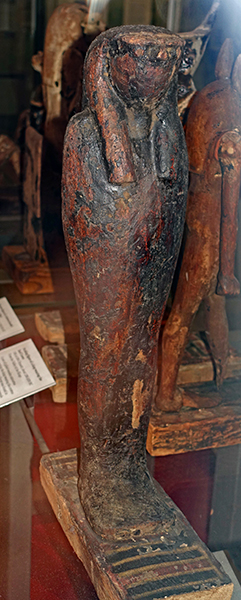
19th - 20th Dynasty, 1 292 BC - 1 077 BC
Qebhsenuef
Wooden figure of a mummiform falcon headed deity, Qebhsenuef, on a pedestal, coated in bitumen.
The base, although made from an ancient wood, is a 19th century restoration.
Dimensions: Height: 462 mm, width 43 mm.
Catalog: Wood and bitumen, Biban el-Muluk (Valley of the Kings - Thebes), EA60393
Photo: Don Hitchcock 2018
Source: Original, British Museum
Text: Card at museum display, https://www.britishmuseum.org/, © Trustees of the British Museum, CC BY-NC-SA 4.0
19th - 20th Dynasty, 1 292 BC - 1 077 BC
Mnevis-bull
Circa 12th Century BC
Two votive stelae for the Mnevis-bull
Mnevis is the Greek name of an ancient Egyptian bull god which had its centre of worship at Heliopolis, and was known to the ancient Egyptians as Mer-wer or Nem-wer.
Although initially a separate god, it was later assimilated with the god Atum-Ra as his physical manifestation, and also considered as the ba of Ra. Mnevis is often depicted as a black bull wearing a solar disk and uraeus. As reported by Plutarch, the Mnevis bull was second only to the Memphite Apis bull in importance. Similarly to the Apis bull, the Mnevis bull's movements were thought to be driven by divine will, and used as an oracle. The priesthood of Mnevis also went as far as to claim that Mnevis was none other than the father of the more famous Apis.
Catalog: Limestone, Heliopolis, ÄS 1399, ÄS 1400
Photo: Don Hitchcock 2018
Source: Original, Ägyptischen Museum München
Text: Museum card, © Ägyptischen Museum München
Additional text: Wikipedia
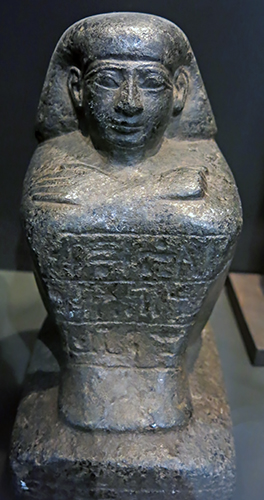
19th - 20th Dynasty, 1 292 BC - 1 077 BC
Statuette of a Squatting Man
After their shape, such statues were called 'cube stools'. They represented the deceased in tombs, or represented benefactors in temples.
Catalog: Granite, H 415
Photo: Don Hitchcock 2015
Source and text: Badisches Landesmuseum Karlsruhe Germany
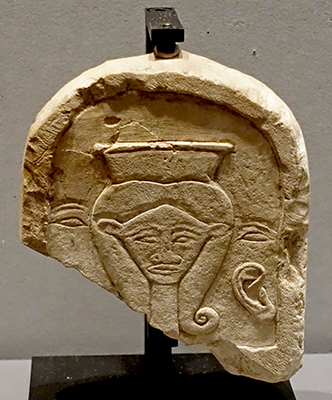
19th - 20th Dynasty, 1 292 BC - 1 077 BC
Hathor
Votive stela with Hathor's head, and ears, circa 1 200 BC - 1 150 BC.
( Note that the face of Hathor itself has cow's ears, but there is a human ear on the right, presumably originally mirrored on the left in the complete stela - Don )
Catalog: Limestone ÄS 1394
Photo: Don Hitchcock 2018
Source: Original, Ägyptischen Museum München
Text: Museum card, © Ägyptischen Museum München

19th - 20th Dynasty, 1 292 BC - 1 077 BC
Hapy
Painted wooden figure of a baboon headed deity, Hapy.
The base, although made from an ancient wood, is a 19th century restoration. Arm and leg lost.
Dimensions: Height: 500 mm, length 247 mm, width 114 mm.
Catalog: Painted wood, Biban el-Muluk (Valley of the Kings - Thebes), EA61110
Photo: Don Hitchcock 2018
Source: Original, British Museum
Text: Card at museum display, https://www.britishmuseum.org/, © Trustees of the British Museum, CC BY-NC-SA 4.0
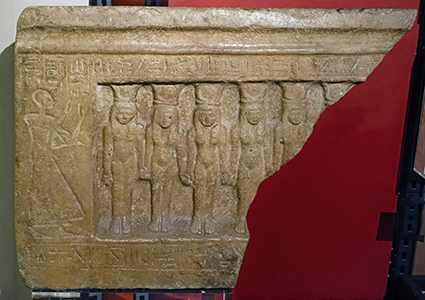
Nineteenth - Twentieth Dynasty: 1 292 BC - 1 077 BC
The Seven Hathors
Hathor took many forms and appeared in a wide variety of roles. The Egyptologist Robyn Gillam suggests that these diverse forms emerged when the royal goddess promoted by the Old Kingdom court subsumed many local goddesses worshipped by the general populace, who were then treated as manifestations of her. Egyptian texts often speak of the manifestations of the goddess as 'Seven Hathors', or, less commonly, of many more Hathors - as many as 362. For these reasons, Gillam calls her 'a type of deity rather than a single entity'. Hathor's diversity reflects the diversity of traits that the Egyptians associated with goddesses. More than any other deity, she exemplifies the Egyptian perception of femininity.
Catalog: Red sandstone, Inv. Nr. 1935.200.226
Photo: Don Hitchcock 2018
Source and text: Original, Museum August Kestner, Hannover
Additional text: Wikipedia
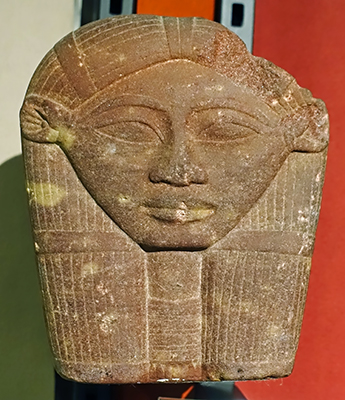
Nineteenth - Twentieth Dynasty: 1 292 BC - 1 077 BC
Hathor
Head of the goddess Hathor.
Catalog: Red sandstone, Inv. Nr. 1935.200.123
Photo: Don Hitchcock 2018
Source and text: Original, Museum August Kestner, Hannover
Nineteenth - Twentieth Dynasty: 1 292 BC - 1 077 BC
Tamutnefret
Tamutnefret (mistress of the house, chanteuse-chémayt (singer - shemayt, šmꜥyt, musician of high status) of Amen, mummy cover in two parts.
Tripartite wig, braid, forehead band, lotus flower, crossed arms, bracelet, Usekh collar, pectoral.
On the top section, on the abdomen, below the arms, a boat of Ra (with a sun disc) flanked by two images of Anubis as a jackal/wolf.
On the first register of the lower section is a winged goddess, kneeling, with wings spread.
On the second register, on the left of the image, is Thoth, the ibis headed god, kneeling, and offering the eye of Wedjat, in front of a seated god, with the sign of the Goddess of the West behind, unequal rods supporting a semicircle, on which is a falcon feather.
On the third register is a woman standing in an attitude of adoration, holding a sistrum. She is adoring Imset, one of the four sons of Horus, usually, as here, shown with a human head.
On the fourth register is an adoration scene, with a woman standing worshipping Anubis, the jackal/wolf headed god, who is dressed similarly to Imset, in the scene above.
On the fifth register, the scene on the fourth above it is repeated, with a woman worshipping Anubis.
( note that at the time of writing, 2021.07.07, the image of this object in the Louvre Catalog has been flipped left to right, as often used to happen before the digital revolution, when physical colour film in the form of colour slides was the common medium of reproduction - Don )
Length 1110 mm, width 330 mm, thickness 210 mm.
Catalog: Gilded, painted openwork wood, West Thebes, probably Sheikh abd-el-Gurnah, Aile Sully, Room 321, the Sarcophagi, N 2620, N 2623
Photo: Don Hitchcock 2015
Source and text: Original, Louvre Museum, Paris, France, https://collections.louvre.fr/

Nineteenth - Twentieth Dynasty: 1 292 BC - 1 077 BC
Tamutnefret
Tamutnefret (mistress of the house, chanteuse-chémayt (singer - shemayt, šmꜥyt, musician of high status) of Amen
Mummiform coffin (interior, but enclosing the mummy cover above), length 1920 mm, width 595 mm, thickness 430 mm.
Shroud, crossed arms, tripartite wig, headband, lotus flower, usekh collar, bracelet, ring, pectoral, inlaid eyes and eyebrows.
On the abdomen is the boat of the sun god Ra, and below that the winged goddess Nut kneels, wings spread, offering protection.
Length 1800 mm, width 485 mm.
Catalog: Gilded, painted wood and stucco, West Thebes, probably Sheikh abd-el-Gurnah, Aile Sully, Room 321, the Sarcophagi, N 2571
Photo: Don Hitchcock 2015
Source and text: Original, Louvre Museum, Paris, France, https://collections.louvre.fr/
Nineteenth - Twentieth Dynasty: 1 292 BC - 1 077 BC
Tamutnefret
Tamutnefret (mistress of the house, chanteuse-chémayt (singer - shemayt, šmꜥyt, musician of high status) of Amen
Mummiform coffin (exterior), length 1920 mm, width 595 mm, thickness 430 mm.
Shroud, crossed arms, tripartite wig, headband, lotus flower, usekh collar, pectoral, inlaid eyes.
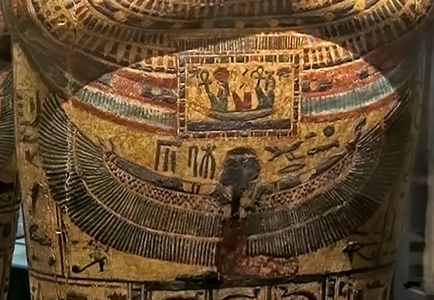
On the abdomen we can see Osiris wearing the Atef crown, flanked by a falcon headed god and a scarab headed god, all seated in a divine boat, indicated by the sun disk above the falcon headed god.
Below this register we can see the winged goddess Nut, kneeling with spread wings.
Catalog: Gilded, painted wood, West Thebes, probably Sheikh abd-el-Gurnah, Aile Sully, Room 321, the Sarcophagi, N 673, N 2631, N 2598
Photo: Don Hitchcock 2015
Source and text: Original, Louvre Museum, Paris, France, https://collections.louvre.fr/
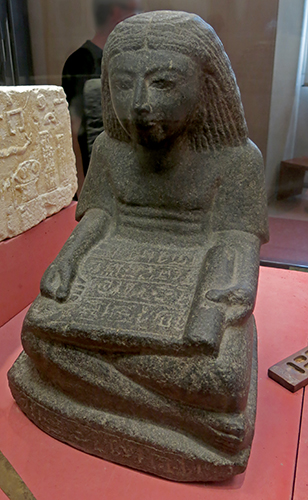
Nineteenth - Twentieth Dynasty: 1 292 BC - 1 077 BC
Scribe
The priest-lector Ouenennefer is represented as a scribe, seated cross-legged.
Height 515 mm, width 346 mm, depth 345 mm, weight 90 kg.
Catalog: Diorite, A 82, N 83, AF 51, Salt n° 3794
Photo: Don Hitchcock 2015
Source and text: Original, Louvre Museum, https://collections.louvre.fr/
Nineteenth - Twentieth Dynasty: 1 292 BC - 1 077 BC
Toy Lion
Wooden figure of a striding cat or lion, upon an integral base. Rock crystal inlays are used for the eyes, and the teeth are of bronze. The lower jaw can be moved, using a string (modern) which runs through a hole which runs through from the top of the head.
Height 53 mm, length 117 mm, width 30 mm.
Catalog: Wood, rock crystal, bronze, Thebes, EA15671
Photo: Don Hitchcock 2015
Source: Original, British Museum
Text: © Card at the Museum, http://www.britishmuseum.org/research/ © Trustees of the British Museum, CC BY-NC-SA 4.0
Nineteenth - Twentieth Dynasty: 1 292 BC - 1 077 BC
Toy Mouse
Toy mouse, with body modelled in clay, and decorated with black lines of paint. The lower jaw and tail are of wood, and are both moveable (pivoting around wooden pins through the main body).
Height 46 mm, length 63 mm (body), 73 mm (tail) 120 mm (together) width 38 mm, weight 910 gm.
( Note that this weight appears to be well out, given in the catalog as 0.91 kilograms. Using 4.6 x 6.3 x 7.3 cm as the dimensions of a rectangular block of fired clay (we can ignore the tail for this calculation) we get 110 cm3 as the volume. Using 2.7 gm/cm3 as the density of fired clay, we get nearly 300 gm. Since the mouse is partially hollow and the ears are included in the height, and the nose is included in the length, 200 gm might be a reasonable estimate, even including the light wooden tail - Don )
Catalog: Clay, wood, painted, EA65512
Photo: Don Hitchcock 2015
Source: Original, British Museum
Text: © Card at the Museum, http://www.britishmuseum.org/research/ © Trustees of the British Museum, CC BY-NC-SA 4.0
Nineteenth - Twentieth Dynasty: 1 292 BC - 1 077 BC
Toy Mouse
Toy mouse, with body modelled in poorly fired ceramic, decorated with brownish-purple paint. The lower jaw is of wood and is moveable (pivoting around wooden pins through main body). A wooden toggle pin is attached to the lower jaw by a string enabling movement.
( Note that the text on the museum card read, in 2018, "Clay and wood toy mouse with moving mouth and tail. EA65512", however the mouse is obviously EA38540, which has a description in the online catalog as "Toy mouse, with body modelled in poorly fired ceramic, decorated with brownish-purple paint. The lower jaw is of wood and is moveable (pivoting around wooden pins through main body). A wooden toggle pin is attached to the lower jaw by a string enabling movement."
The model as arranged in 2018 showed the wooden toggle pin in the position of a tail, albeit attached to the body by a string, as in this photo.
Note also that the given height in the online catalog of 150 mm, and depth of 330 mm appear to me to be wildly out, height and length are much too big. The given width of 32 mm and weight of 66 grams may be correct - Don )
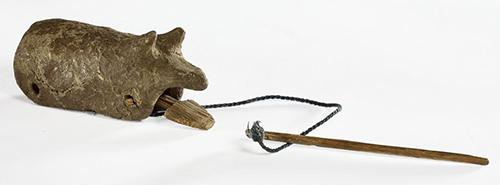
Image in the BM online catalog of EA38540.
Photo: © Trustees of the British Museum, CC BY-NC-SA 4.0
Catalog: Poorly fired ceramic, wood, EA38540
Photo (top): Don Hitchcock 2018
Photo (below): © Trustees of the British Museum, CC BY-NC-SA 4.0
Source: Original, British Museum
Text: © Card at the Museum, http://www.britishmuseum.org/research/ © Trustees of the British Museum, CC BY-NC-SA 4.0
Nineteenth - Twentieth Dynasty: 1 292 BC - 1 077 BC
Pregnant woman
Figure of a pregnant woman lying on a bed, circa 1 200 - 1 100 BC.
Catalog: Limestone, ÄS 7257
Photo: Don Hitchcock 2018
Source: Original, Ägyptischen Museum München
Text: Museum card, © Ägyptischen Museum München
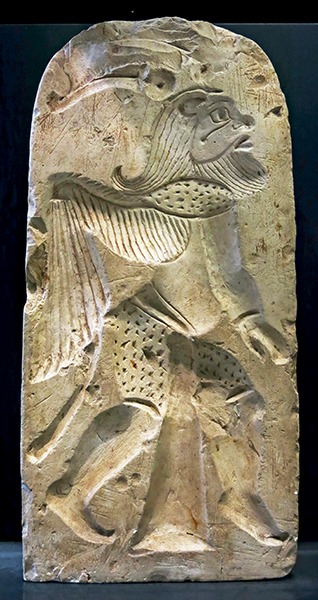
Nineteenth - Twentieth Dynasty: 1 292 BC - 1 077 BC
Bes mold
Bes is dancing, with wings, and wearing an animal skin and a beard.
Height 333 mm, width 161 mm, thickness 62 mm.
Catalog: Limestone, AF 1957, CC 237, AF 51, Thédenat-Duvent n° 17
Location: Aile Sully, Salle 317, Gods and Magic, Vitrine 2
Photo: Don Hitchcock 2015
Source and text: Original, Louvre Museum, https://collections.louvre.fr/
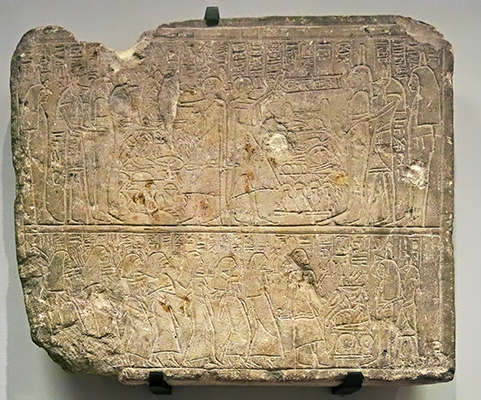
Nineteenth - Twentieth Dynasty: 1 292 BC - 1 077 BC
Imenmes
Stele with two registers, the rites of opening the mouth. A representation of the burial rites of several members of the same family, in front of grieving attendants.
Decoration: Rites before the tomb, mourners, sarcophagus, Anubis.
Names and titles: Imenmes (priest, son), Henuttaouy (housewife, wife)
Height 280 mm, width 340 mm, thickness 50 mm.
Catalog: Limestone, E 25496
Photo: Don Hitchcock 2015
Source and text: Original, Louvre Museum, https://collections.louvre.fr/
The Twentieth Dynasty
1 187 BC - 1 077 BC
The Pharaohs of the 20th dynasty ruled for approximately 110 years. The dates and names in the table are mostly taken from 'Chronological Table for the Dynastic Period' in Erik Hornung, Rolf Krauss & David Warburton (editors), Ancient Egyptian Chronology (Handbook of Oriental Studies), Brill, 2006. Many of the pharaohs were buried in the Valley of the Kings in Thebes (designated KV). More information can be found on the Theban Mapping Project website.
BackgroundText above from Wikipedia.
Pharaoh Setnakhte was likely already middle aged when he took the throne after Queen Twosret. He ruled for only around 4 years when he was succeeded by his son Ramesses III. Egypt was threatened by the Sea Peoples during this time period, but Ramesses III was able to defeat this confederacy from the Near East. The king is also known for a harem conspiracy in which Queen Tiye attempted to assassinate the king and put her son Pentawere on the throne. The coup was not successful in the end. The king may have died from the attempt on his life, but it was his legitimate heir Ramesses IV who succeeded him to the throne. After this a succession of kings named Ramesses take the throne, but none would truly achieve greatness.
Tomb robberies
The period of these rulers is notable for the beginning of the systematic robbing of the royal tombs. Many surviving administrative documents from this period are records of investigations and punishment for these crimes, especially in the reigns of Ramses IX and Ramses XI.
Decline
As happened under the earlier Nineteenth Dynasty, this group struggled under the effects of the bickering between the heirs of Ramesses III. For instance, three different sons of Ramesses III are known to have assumed power as Ramesses IV, Ramesses VI and Ramesses VIII respectively. However, at this time Egypt was also increasingly beset by a series of droughts, below-normal flooding levels of the Nile, famine, civil unrest and official corruption – all of which would limit the managerial abilities of any king.
The power of the last king, Ramesses XI, grew so weak that in the south the High Priests of Amun at Thebes became the de facto rulers of Upper Egypt, while Smendes controlled Lower Egypt even before Ramesses XI's death. Smendes would eventually found the Twenty-First dynasty at Tanis.
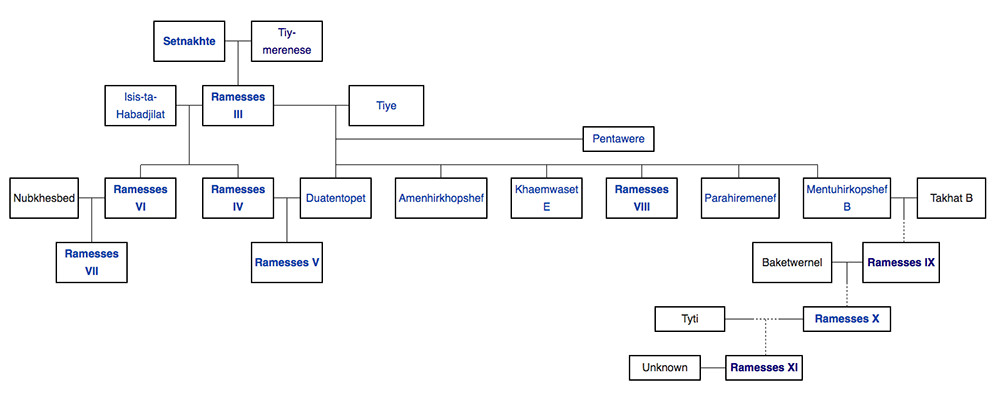
Family tree of the Twentieth dynasty of Egypt, which was the last of the New Kingdom of Egypt, from Wikipedia.
| Twentieth Dynasty | ||||||
|---|---|---|---|---|---|---|
| Name | Horus (Throne) Name | Consort | Burial | Years | Dates | Comments |
| Setnakhte | Userkhaure | Tiy-merenese | KV14 | 3 | 1 187 BC - 1 186 BC | |
| Ramesses III | Usermaatre-Meryamun | Iset Ta-Hemdjert Tiye |
KV11 | 31 | 1 186 BC - 1 155 BC | |
| Ramesses IV | Usermaatre (later Heqamaatre) Setepenamun |
Duatentopet | KV2 | 6 | 1 155 BC - 1 149 BC | |
| Ramesses V Amenhirkhepeshef I |
Usermaatre Sekheperenre | Henutwati Tawerettenru |
KV9 | 4 | 1 149 BC - 1 145 BC | |
| Ramesses VI Amenhirkhepeshef II |
Nebmaatre Meryamun | Nubkhesbed | KV9 | 8 | 1 145 BC - 1 137 BC | |
| Ramesses VII Itamun |
Usermaatre Setepenre Meryamun | KV1 | 7 | 1 136 BC - 1 129 BC | ||
| Ramesses VIII Sethhirkhepeshef |
Usermaatre Akhenamun | 1 | 1 130 BC - 1 129 BC | |||
| Ramesses IX Khaemwaset I |
Neferkare Setepenre | Baketwernel | KV6 | 18 | 1 129 BC - 1 111 BC | |
| Ramesses X Amenhirkhepeshef III |
Khepermaatre Setepenre | Tyti | KV18 | 4 | 1 111 BC - 1 107 BC | |
| Ramesses XI Khaemwaset II |
Menmaatre Setpenptah | Tentamun | KV4 | 30 | 1 107 BC - 1 077 BC | |

Twentieth Dynasty: 1 187 BC - 1 077 BC
Ramesses III
Shabti in bronze.
Dimensions: Height: 126 mm, width 34 mm, depth 20 mm
Catalog: Bronze, KV11, EA33938
Photo: Don Hitchcock 2018
Source: Original, British Museum
Text: Card with the display at the British Museum, http://www.britishmuseum.org/,© Trustees of the British Museum, CC BY-NC-SA 4.0
Twentieth Dynasty: 1 187 BC - 1 077 BC
Ramesses / Ramses III, reigned 1 186 BC - 1 155 BC
Mummiform funerary servant
Shroud, tripartite wig, curled false beard, crossed arms.
Dimensions: (left) Height: 125 mm, width 34 mm, thickness 25 mm
Catalog: (left) Bronze, Sully Wing, level -1, vitrine 3, KV 11, tomb of Ramses III, Valley of the Kings, N 656 A, Salt n°3372
Dimensions: (right) Height: 125 mm, width 35 mm, thickness 26 mm
Catalog: (right) Bronze, Sully Wing, level -1, vitrine 3, KV 11, tomb of Ramses III, Valley of the Kings, N 656 B, Salt n°3373
Photo: Don Hitchcock 2015
Source and text: Original, Louvre Museum, Paris, France, collections.louvre.fr
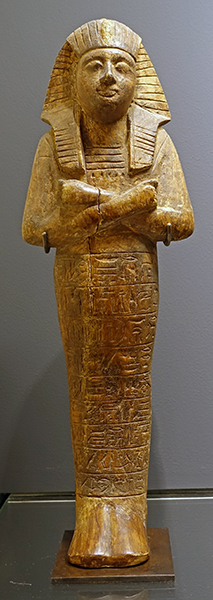
Nineteenth Dynasty: 1 292 BC - 1 187 BC
Ramses III
Mummiform funerary servant from the tomb of Ramses III, 1 186 BC - 1 155 BC.
The shabti wears a shroud, Nemes headdress, and Usekh necklace. It has pierced ears, crossed arms, and is holding two hoes. Height 395 mm, width 132 mm, thickness 80 mm.
Catalog: Wood, KV 11, Tomb of Ramses III, Valley of the Kings, AF 425
Location: Aile Sully, Salle 323, Crypte d'Osiris, Vitrine 3
Photo: Don Hitchcock 2018
Source and text: Original, Louvre Museum, Paris, France, https://collections.louvre.fr/
Nineteenth Dynasty: 1 292 BC - 1 187 BC
Stelae
(left) Limestone stela with pointed top. The scene shows two identical male figures, seated face to face, with an offering table between them. Each figure wears a duplex wig and a kilt and holds a loop of cloth in one hand. The other hand grasps the stem of a large lotus flower, the head of which is positioned in front of the face. Hieroglyphic inscriptions above and behind the figures identify the man on the left as Pennub, and that on the right as Khamwy.
The persons named on the stela are also depicted on stela EA 372.
Height 240 mm, width 160 mm.
Catalog: Limestone, Deir el-Medina (Thebes) EA 359
(right) Pointed-topped limestone stela divided into two registers:
Upper - Standard of the West flanked by the figures of Isis and Nephthys kneeling in adoration.
Lower - Scene of two figures seated on either side of a table; six columns of Hieroglyphic text above. The inscription names the man on the left as Pennub, and that on the right as Khamwy.
Height 330 mm, width 205 mm.
Catalog: Limestone, Deir el-Medina (Thebes) EA 372
Photo: Don Hitchcock 2018
Source and text: Original, Louvre Museum, Paris, France, https://collections.louvre.fr/
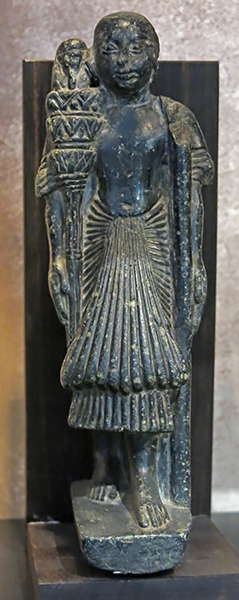
Nineteenth - Twentieth Dynasty: 1 292 BC - 1 077 BC
Priest
Priest with standard and bouquet.
Bouquets of flowers were used as consecration gifts in shrines.
Catalog: Dark steatite, Inv. H 956
Photo: Don Hitchcock 2015
Source and text: Badisches Landesmuseum Karlsruhe Germany
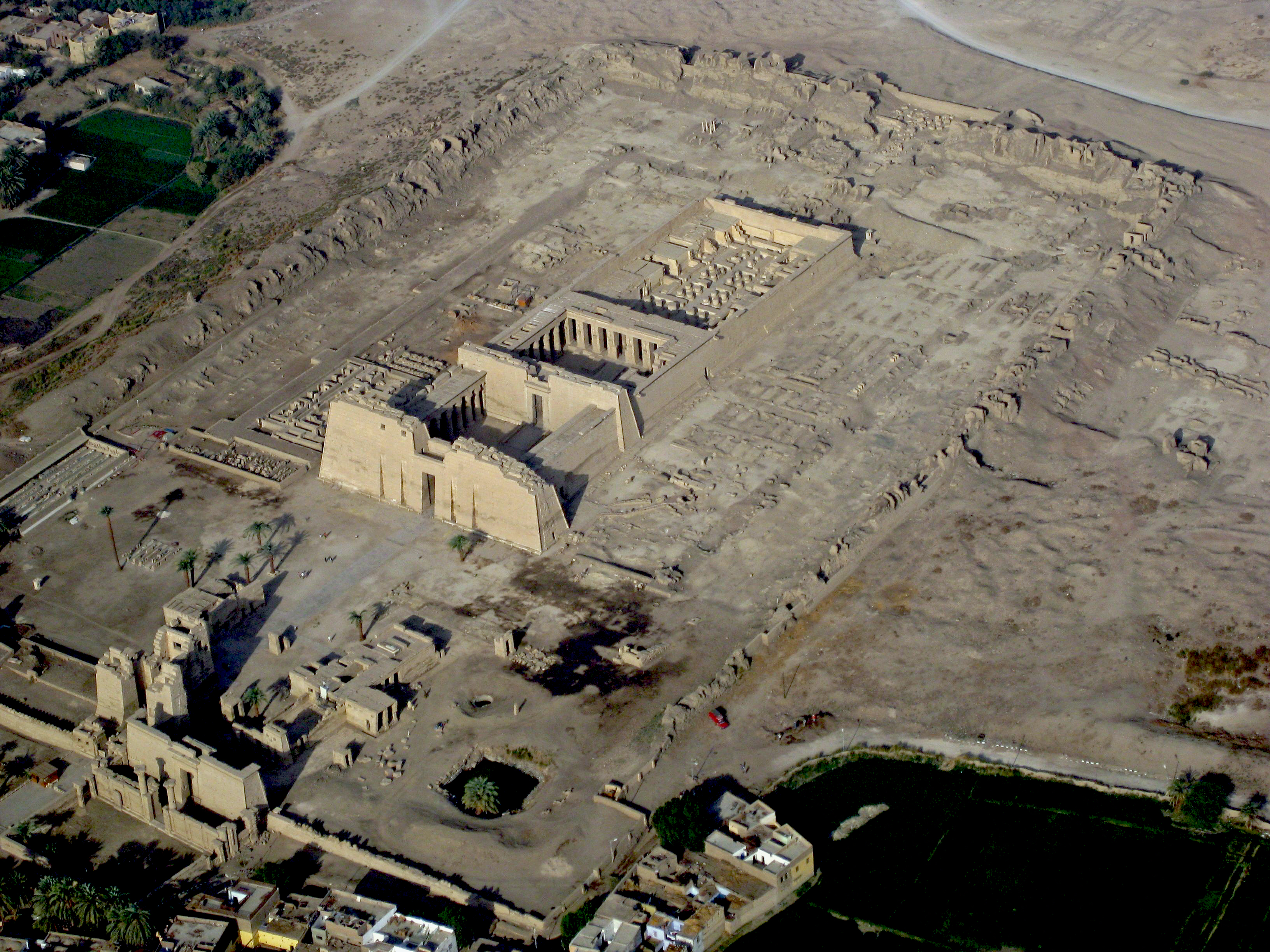
Twentieth Dynasty: 1 187 BC - 1 077 BC
Ramesses III
Temple of Ramesses III at Medinet Habu.
Photo: Steve F-E-Cameron
Permission: Creative Commons Attribution 3.0 Unported license.
Twentieth Dynasty: 1 187 BC - 1 077 BC
Ramesses III
In this scene from the Temple of Ramesses III at Medinet Habu, the severed hands of the enemy are tossed onto a pile so that they can be more easily and accurately counted.
Photo: Asta
Permission: Public Domain, https://en.wikipedia.org/wiki/File:Bas-relief_at_the_mortuary_temple_of_Ramesses_III_17.jpg


Twentieth Dynasty: 1 187 BC - 1 077 BC
Osiris
Painted wooden statue of Osiris, circa 1 170 BC.
The figure depicts the god wearing his characteristic feathered crown and grasping the royal crook and flail sceptres. The green colouring of the skin reflects the god's associations with vegetation as a metaphor for rebirth. This statuette contained the rolled funerary papyrus of the lady Anhai.
Height 635 mm.
When this uninscribed Osiris figure was examined, the funerary papyrus of Anhai (registration no. 1888,0512.222.7) was found in a recess in the base. Figurines of this type are the forerunner of the more common and later Ptah-Sokar-Osiris figures, and take the form of a mummiform figure of the god of the dead; the presence of this deity in the tomb would help ensure resurrection and new life after death.
This example is particularly elaborate and wears the feathered atef crown, a floral collar, and an elaborately decorated red covering on the upper body, with a decorated white covering from the waist down. This bright colouring can also be seen in depictions of Osiris in tomb paintings from the Eighteenth and Nineteenth Dynasties. As in many other depictions, Osiris' face is green - the colour of vegetation, another symbol of new life associated with this deity. Some other figurines of this type are painted black, symbolising the fertility of the earth with which Osiris was associated. He carries the crook and flail of kingship.
Catalog: Painted wood, Akhmim, EA20868
Photo: Don Hitchcock 2015, 2018
Source: Original, British Museum
Text: Card at the British Museum, http://www.britishmuseum.org/, © Trustees of the British Museum, CC BY-NC-SA 4.0
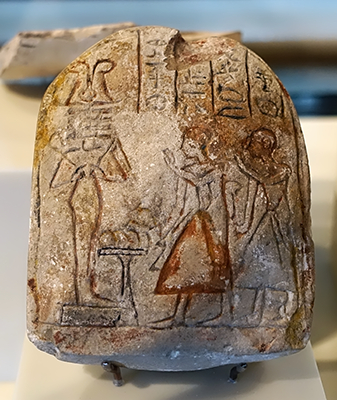
Twentieth Dynasty: 1 187 BC - 1 077 BC
Votive stela of Ta
Osiris is shown with a djed-pillar in place of his head. Osiris is the Egyptian god of the afterlife, the underworld, and the dead. The djed-pillar is commonly understood to represent his spine. Circa 1 152 BC - 1 145 BC
Catalog: Painted limestone, Deir el-Medine, ÄM 20989
Photo: Don Hitchcock 2018
From the excavations of the German Oriental Society in Der el-Medine under the direction of Georg Möller, 1911 to 1913
Source: Original, Staatliche Museen zu Berlin, Neues Museum, Germany
Text: © Card at the Staatliche Museen zu Berlin, (CC BY-NC-SA 3.0 DE)
Additional text: Wikipedia
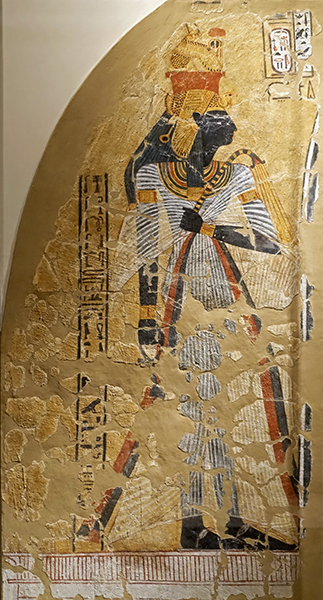
Twentieth Dynasty: 1 187 BC - 1 077 BC
Queen Ahmose-Nofretari / Ahmose-Nefertari
Painting from a tomb: Representation of the deified queen Ahmose-Nefertari, circa 1 186 BC - 1 070 BC
Queen Ahmose-Nofretari herself, is from the Eighteenth Dynasty: 1 550 BC - 1 292 BC This painting is, however, from the 20th Dynasty, as a result of posthumous worship.
Ahmet-Nefertari and her son Amenhotep I were divinely revered after their death, especially by the craftsmen of the labourers' settlement in Deir el Medina, whom they regarded as their guardian goddess.
Ahmose-Nefertari wears a flowing, pleated dress, typical in representations of elite women of the Ramesside period (about 1 295 BC - 1 069 BC)
rather than the period during which the Queen was alive. On her head she wears the vulture head-dress of the goddess Mut, consort of the god Amun of Thebes, surmounted by a sun-disc and ostrich plumes. The cobra on her crown indicates her royal status. The lotus blossom was often held by deceased women, thought to be representing rebirth. The black colour of Ahmose-Nefertari's skin does not reflect her true coloration, but may symbolise regeneration.
Catalog: Deir el-Medine, Inherkau's tomb, Grave TT 359, Nile mud, stucco, painted ÄM 2060
Photo: Don Hitchcock 2018
Source: Original, Staatliche Museen zu Berlin, Neues Museum, Germany
Text: © Card at the Staatliche Museen zu Berlin, (CC BY-NC-SA 3.0 DE)
Additional text: Margret Pirzer, https://www.flickr.com/photos/57703761@N06/31075006346, http://www.deirelmedina.com/lenka/TempleAmenhotep.html
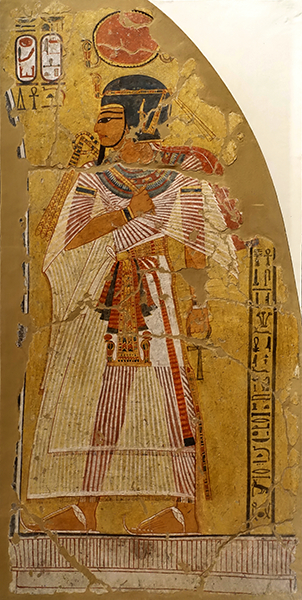
Twentieth Dynasty: 1 187 BC - 1 077 BC
Pharoah Amenhotep I
Painting from a tomb: Representation of the deified pharoah Amenhotep I.
Amenhotep I is shown wearing a blue cap-wig, with a uraeus on its front. It is topped with a sun-disc. Amenhotep holds a crook and a flail, symbols of royalty, in his right hand. He holds an ankh, symbol of life, in his left hand. The king is shown wearing the classic shendjyt-kilt, and a longer see-through linen garment.
Amenhotep I was the second Pharaoh of the 18th dynasty of Egypt. His reign is generally dated from 1 526 BC - 1 506 BC. He was a son of Ahmose I and Ahmose-Nefertari, but had at least two elder brothers, Ahmose-ankh and Ahmose Sapair, and was not expected to inherit the throne. However, sometime in the eight years between Ahmose I's 17th regnal year and his death, his heir apparent died and Amenhotep became crown prince. He then acceded to the throne and ruled for about 21 years.
He inherited the kingdom formed by his father's military conquests and maintained dominance over Nubia and the Nile Delta but probably did not attempt to maintain Egyptian power in the Levant. He continued the rebuilding of temples in Upper Egypt and revolutionised mortuary complex design by separating his tomb from his mortuary temple, setting a trend in royal funerary monuments which would persist throughout the New Kingdom. After his death, he was deified as a patron god of Deir el-Medina.
Catalog: Deir el-Medine, Inherkau's tomb, Grave TT 359, Nile mud, stucco, painted ÄM 2061
Photo: Don Hitchcock 2018
Source: Original, Staatliche Museen zu Berlin, Neues Museum, Germany
Text: © Card at the Staatliche Museen zu Berlin, (CC BY-NC-SA 3.0 DE)
Additional text: http://www.deirelmedina.com/lenka/TempleAmenhotep.html
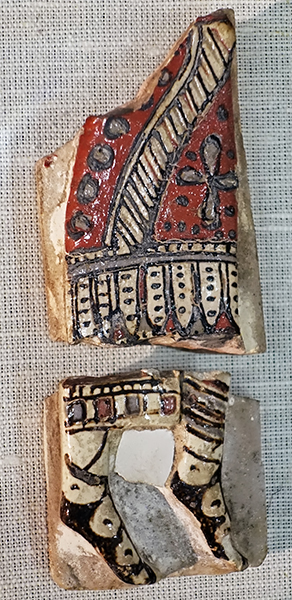
Twentieth Dynasty: 1 187 BC - 1 077 BC
Wall tiles
Six fragments of wall tiles.
Ceramic with coloured glazes, circa 1 160 BC.
Catalog: Ceramic with coloured glazes, probably from Medinet Habu (Thebes), Inv. No. 1950.148 a-c, g, f; 1950.149
Photo: Don Hitchcock 2018
Source and text: Original, Museum August Kestner, Hannover
Twentieth Dynasty: 1 187 BC - 1 077 BC
Hori
Sandstone lintel of the viceroy Hori, a fragment of a large lintel consisting of the torus roll and cornice with incised scenes and texts. In the centre of the lintel are the cartouches of Ramses III. On the left side the viceroy of Kush Hori and the mayor of Buhen, Harmose kneel in adoration.
Several columns of text are inscribed with a prayer to the king on their behalf. The lintel is battered about the edges, with the loss of the upper left corner and the right side which was recovered separately. The surface is worn in places so that the text is difficult to interpret. There are no traces of colour. The Egyptian Viceroy of Kush, Hod, and the mayor of Buhen, Harmose, kneel in adoration. A similar scene would have been carved on the right side.
A portion of the right side of the lintel was discovered separately and is now unlocated (Smith, 2006)
From Buhen, early 1100s BC (20th Dynasty) ( i.e. during the reign of Ramesses III, now thought to be March 1186 to April 1155 BC - Don )
Buhen was an ancient Egyptian settlement situated on the West bank of the Nile below (to the North of) the Second Cataract in what is now Northern State, Sudan. It is now submerged in Lake Nasser, Sudan. On the East bank, across the river, there was another ancient settlement, where the town of Wadi Halfa now stands. The earliest mention of Buhen comes from stelae dating to the reign of Senusret I. Buhen is also the earliest known Egyptian settlement in the land of Nubia.
Statements of adoration for the pharaoh are given in the columns of hieroglyphs flanking the royal cartouches.
Height 534 mm, length 965 mm (max).
Catalog: EA66667
Photo: Don Hitchcock 2015
Source: Original, British Museum
Text: Card with the display at the British Museum, http://www.britishmuseum.org/,© Trustees of the British Museum, CC BY-NC-SA 4.0
Additional text: Wikipedia
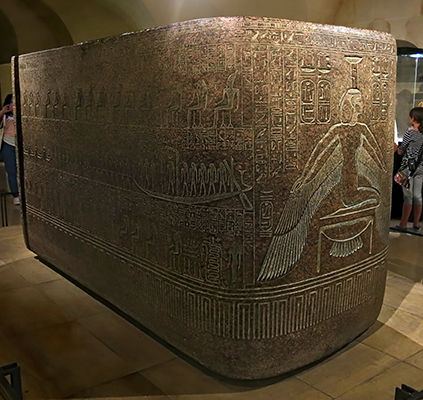
Twentieth Dynasty: 1 187 BC - 1 077 BC
Ramesses III
Sarcophagus of Pharaoh Ramesses III, from his tomb in the Valley of the Kings.
Granite, 18 tons. Height 180 cm, length 305cm, width 150 cm.
This pink granite cartouche-shaped box once contained the nest of coffins of Pharaoh Ramesses III. The lid is now in the Fitzwilliam Museum in Cambridge. The outside of the box is engraved with the seventh and eighth chapters of the 'Book of Amduat', and the inside with the first chapter of the 'Book of Gates.' Certain parts of these texts were very carelessly engraved.
Catalog: Sully Rez-de-chaussée Crypte d'Osiris Salle 13, D 1
Photo: Don Hitchcock 2015
Source: Original, Musée du Louvre
Text: http://www.louvre.fr/en/oeuvre-notices/sarcophagus-box-ramesses-iii
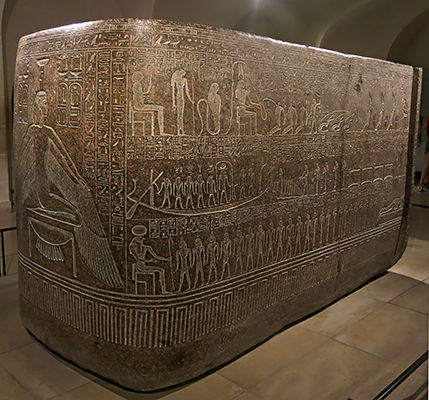
Twentieth Dynasty: 1 187 BC - 1 077 BC
Ramesses III
The decoration of this monolithic cartouche-shaped block is organised around the large winged figure of Isis at the feet of the deceased (on the flat front of the sarcophagus) and that of Nephthys at his head (on the rounded back of the box).
Both long sides are engraved with scenes taken from the "Book of Hidden Chambers" (the Amduat). The decoration begins near the figure of Nephthys at the king's head, with the seventh hour of the Amduat along the right side (looking from the head to the feet), and continues with the eighth hour along the left side.
Around the base of the coffin is the palace façade motif - a relic of Old Kingdom sarcophagi (cf. sarcophagus of Abu Roach, Room 14). The inside of the box features large figures of deities from the first hour of the 'Book of Gates'.
Photo: Don Hitchcock 2015
Source: Original, Musée du Louvre
Text: http://www.louvre.fr/en/oeuvre-notices/sarcophagus-box-ramesses-iii
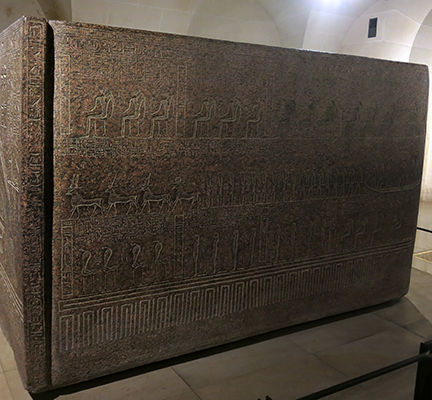
Twentieth Dynasty: 1 187 BC - 1 077 BC
Ramesses III
The Egyptians imagined the sun to travel underground in a boat during the twelve hours of night. The nocturnal sun was represented as a man with a ram's head. Every 'hour' (i.e. every stage of his journey) was marked by a particular event: at the seventh hour, for example (right-hand side of the coffin), the sun confronts the snake Apophis, the 'evil serpent' of Egyptian texts, who tries to stop him on his course.
The sun-god is portrayed armed with knives to destroy him. The left-hand side represents the eighth hour: on the lower register, the creatures of the Underworld are depicted, sitting on the ideogram for fabric (one of the essential funerary offerings). The texts referring to the sun's night-time journey ('Litanies of the Sun', 'Amduat', 'Book of Gates', 'Book of Night', etc.) were composed during the New Kingdom for the exclusive use of the king.
As the pharaoh was associated with the sun god and his perilous journey through the night, the royal tomb featured representations of this recurrent event. After the New Kingdom, some of these texts (especially the Amduat) were also used for the benefit of priests and soldiers who were at the peak of their influence at that time (see the papyri in vitrine 4).
Photo: Don Hitchcock 2015
Source: Original, Musée du Louvre
Text: http://www.louvre.fr/en/oeuvre-notices/sarcophagus-box-ramesses-iii

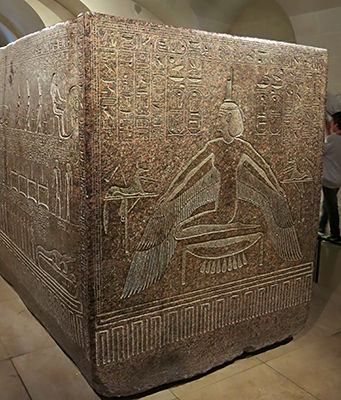
Twentieth Dynasty: 1 187 BC - 1 077 BC
Ramesses III
Slapdash work
Only two scenes from the Amduat are illustrated on the sarcophagus of Ramesses III, which is characterised by extraordinary carelessness on the part of the scribe who engraved the introductory text to the seventh hour (to the right of the figure of Nephthys).
The phrases (and even individual words) are cut up into incoherent elements that cannot be understood without referring to the correct version featured in other tombs. This poor reproduction, without subsequent checking, suggests that, in the late New Kingdom, the monarchy was no longer treated with the respect it had once inspired.
Photo: Don Hitchcock 2015
Source: Original, Musée du Louvre
Text: http://www.louvre.fr/en/oeuvre-notices/sarcophagus-box-ramesses-iii
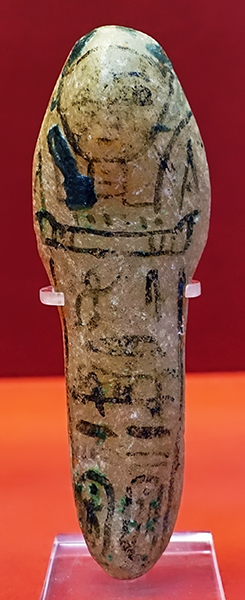
Twentieth Dynasty: 1 187 BC - 1 077 BC
Ramesses IV
Calcite shabti of Ramses IV with black painted detail. A lappet-wig, an unmodelled face and rudimentary arms. Hieroglyphic text on the leg section, traces of green wax.
Dimensions: Height 138 mm, width 45 mm, depth 38 mm
( This shabti is about as minimalist as it is possible to get! - Don )
Catalog: Calcite, green wax, EA58784
Photo: Don Hitchcock 2018
Source: Original, British Museum
Text: Card with the display at the British Museum, http://www.britishmuseum.org/,© Trustees of the British Museum, CC BY-NC-SA 4.0
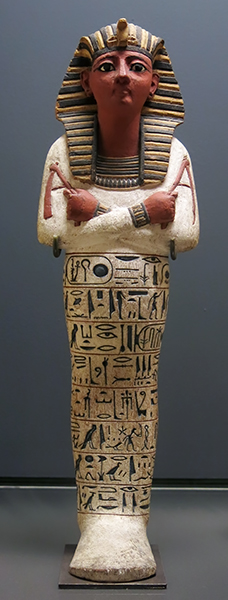
Twentieth Dynasty: 1 187 BC - 1 077 BC
Ramesses IV
Mummiform funerary servant, a shabti, with crossed arms, each hand holding a hoe, dressed in a shroud, a Nemes striped headdress, Usekh necklace, pierced ears, and bracelets.
Dimensions: Height 325 mm, width 98 mm, thickness 61 mm.
Catalog: Painted wood, KV 2, tomb of Ramses IV, Valley of the Kings, N 438
Location: Aile Sully, Salle 323, Crypte d'Osiris, Vitrine 3
Photo: Don Hitchcock 2015
Source and text: Original, Louvre Museum, Paris, France, https://collections.louvre.fr/
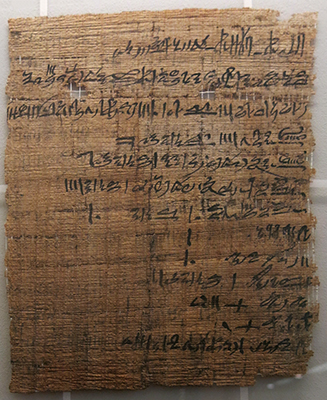
Twentieth Dynasty: 1 187 BC - 1 077 BC
Imenemouia - Ramesses IV
Auditor Imenemouia's report, circa 1 150 BC (year 4 of the reign of Ramses IV).
Papyrus, 'Mallet 1'
Height 210 mm, width 210 mm.
Catalog: Papyrus, Black text, E 11006 1, Anastasi n° 1050
Photo: Don Hitchcock 2015
Source and text: Original, Louvre Museum, https://collections.louvre.fr/

Twentieth Dynasty: 1 187 BC - 1 077 BC
Ramesses VI
Calcite shabti of Ramses VI with black painted detail. An unmodelled face and rudimentary crossed arms; column of Hieroglyphic text down the leg section; remains of a green wax coating.
Dimensions: Height 129 mm, width 31 mm, depth 35 mm
( Like EA58784 above, this shabti is also about as minimalist as it is possible to get! - Don )
Catalog: Calcite, green wax, painted, EA13808
Photo: Don Hitchcock 2018
Source: Original, British Museum
Text: Card with the display at the British Museum, http://www.britishmuseum.org/,© Trustees of the British Museum, CC BY-NC-SA 4.0
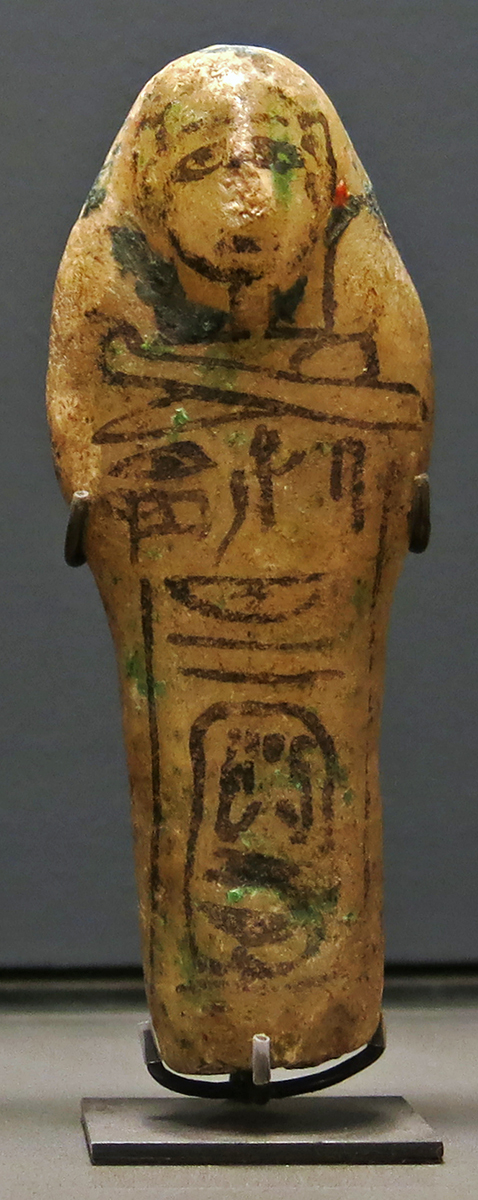
Twentieth Dynasty: 1 187 BC - 1 077 BC
Ramesses VI
Mummiform funerary servant.
1 143 BC - 1 136 BC (Reign of Ramses VI)
Shroud, tripartite wig, crossed arms.
Dimensions: Height 124 mm, width 47 mm, thickness 32 mm.
Catalog: Painted Egyptian alabaster (traces of red wax, black details, surface covered with green paint), KV 9 tomb of Ramesses VI, Valley of the Kings, Room 323 Sully wing, level -1, Vitrine 3, E 585, N 616
Photo: Don Hitchcock 2015
Source and text: Original, Louvre Museum, Paris, France, collections.louvre.fr
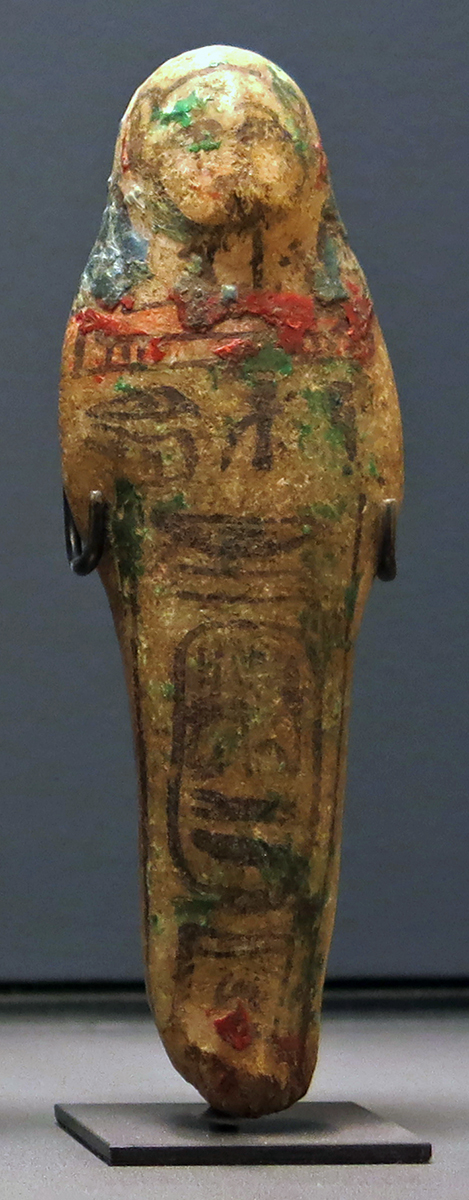
Twentieth Dynasty: 1 187 BC - 1 077 BC
Ramesses VI
Mummiform funerary servant.
1 143 BC - 1 136 BC (Reign of Ramses VI)
Shroud, tripartite wig, crossed arms.
Dimensions: Height 138 mm, width 45 mm, thickness 30 mm.
Catalog: Painted Egyptian alabaster (traces of red wax), details in red and black - surface covered with green paint, KV 9 tomb of Ramesses VI, Valley of the Kings, Room 323 Sully wing, level -1, Vitrine 3, N 2266
Photo: Don Hitchcock 2015
Source and text: Original, Louvre Museum, Paris, France, collections.louvre.fr
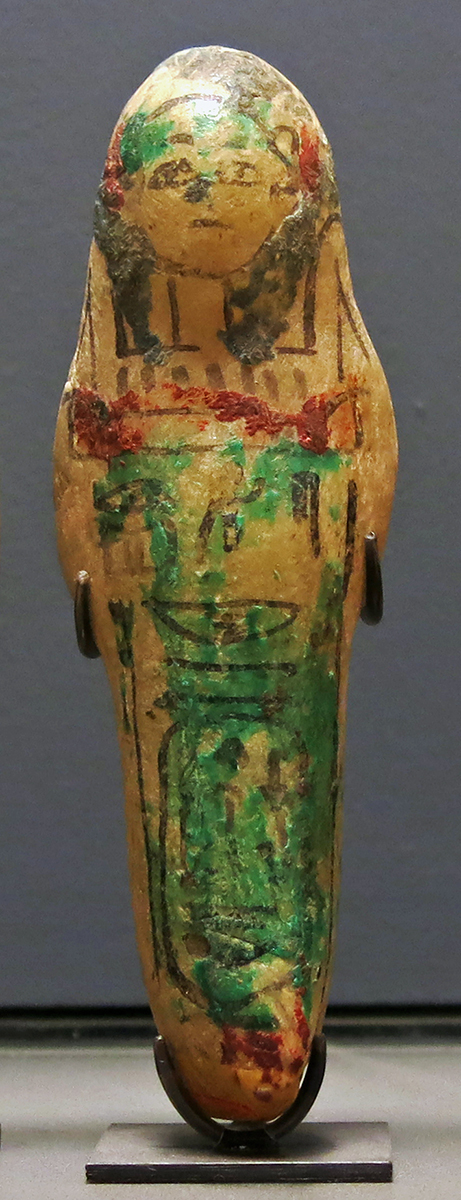
Twentieth Dynasty: 1 187 BC - 1 077 BC
Ramesses VI
Mummiform funerary servant
1 143 BC - 1 136 BC (Reign of Ramses VI)
Shroud, tripartite wig, crossed arms.
Dimensions: Height 146 mm, width 47 mm, thickness 36 mm.
Catalog: Painted Egyptian alabaster, black details enhanced with green, traces of red wax, KV 9 tomb of Ramesses VI, Valley of the Kings, Room 323 Sully wing, level -1, Vitrine 3, E 23924
Photo: Don Hitchcock 2015
Source and text: Original, Louvre Museum, Paris, France, collections.louvre.fr
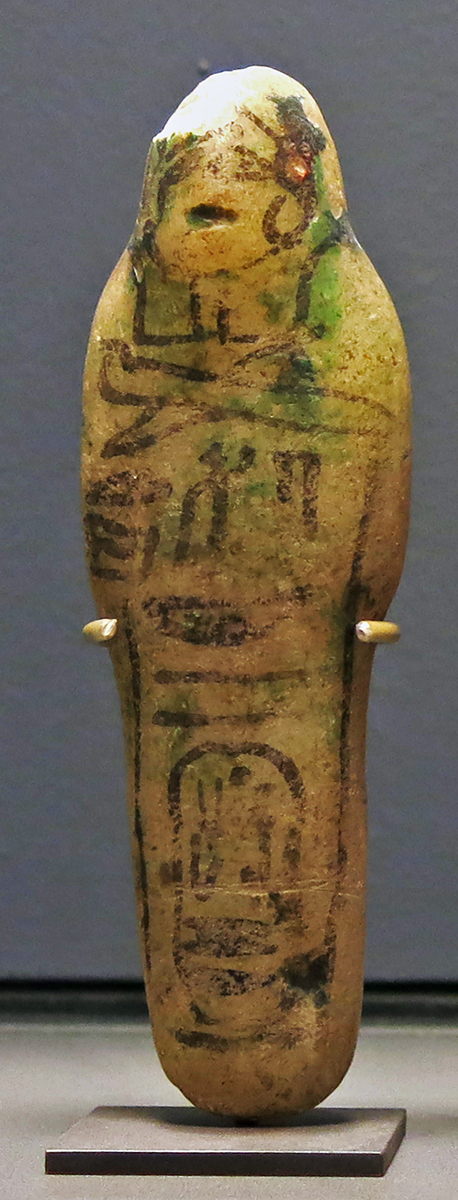
Twentieth Dynasty: 1 187 BC - 1 077 BC
Ramesses VI
Mummiform funerary servant
1 143 BC - 1 136 BC (Reign of Ramses VI)
Shroud, tripartite wig, crossed arms.
Dimensions: Height 129 mm, width 41 mm, thickness 28 mm.
Catalog: Painted Egyptian alabaster, details painted in red and black, traces of green wax, KV 9 tomb of Ramesses VI, Valley of the Kings, Room 323 Sully wing, level -1, Vitrine 3, N 616
Photo: Don Hitchcock 2015
Source and text: Original, Louvre Museum, Paris, France, collections.louvre.fr
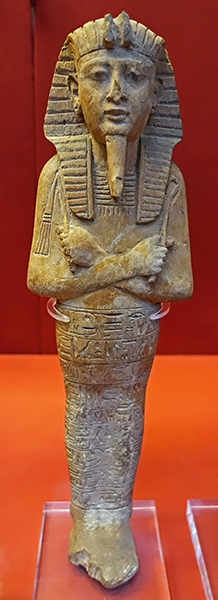

Twentieth Dynasty: 1 187 BC - 1 077 BC
Ramesses VI
Two wooden shabtis of Ramesses VI, circa 1 143 BC - 1 136 BC
Left: EA29998. Wooden shabti of Ramses VI.
Dimensions: Height 382 mm, width 111 mm, depth 65 mm.
Right: EA29999. Wooden shabti of Ramses VI.
Dimensions: Height 398 mm, width 120 mm, depth 70 mm.
Catalog: Wood, Biban el-Muluk (Valley of the Kings - Thebes), Tomb of Ramses VI, EA29998, EA29999
Photo: Don Hitchcock 2018
Source: Original, British Museum
Text: Card at museum display, https://www.britishmuseum.org/, © Trustees of the British Museum, CC BY-NC-SA 4.0
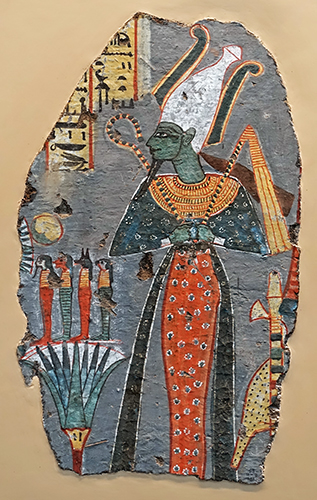
Twentieth Dynasty: 1 187 BC - 1 077 BC
Osiris
Wall painting showing Osiris, circa 1 140 BC
Rectangular fragment of a polychrome tomb-painting representing Osiris, standing and holding the crook and flail, with lotus flower, surmounted by the four sons of Horus, before.
This tomb is now largely destroyed; this register is shown intact in a drawing of Robert Hay: the tomb-owner offers to Osiris (the Hay mss suggest that this figure belongs to a different scene from the figures of Amenhotep I and Ahmose Nefertari); behind Osiris is a Djed pillar in costume.
Dimensions: Height 445 mm.
Catalog: Painted plaster, Thebes, Tomb of Kynebu, EA37995
Photo: Don Hitchcock 2018
Source: Original, British Museum
Text: Card at museum display, https://www.britishmuseum.org/, © Trustees of the British Museum, CC BY-NC-SA 4.0
Twentieth Dynasty: 1 187 BC - 1 077 BC
Imenemwuya
Coffin of Imenemwuya, 'Guardian of the Barque of Amun'.
Catalog: Wood, ÄS 67a-b
Photo: Don Hitchcock 2018
Source: Original, Ägyptischen Museum München
Text: Museum card, © Ägyptischen Museum München
Vitrine in the Ägyptischen Museum München showing coffins from various periods.
Source: Original, Ägyptischen Museum München
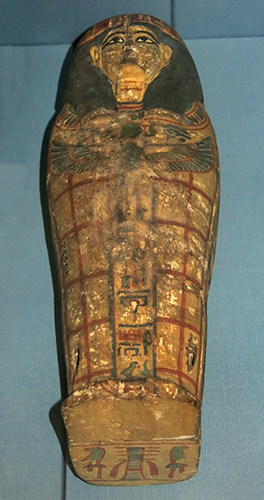
Twentieth Dynasty: 1 187 BC - 1 077 BC
Sutimose
Canopic Coffinette of Sutimose. Late 20th Dynasty, about 1100 BC.
In place of Canopic jars, the four packages of viscera were sometimes enclosed in sets of miniature coffins. The pharaohs Tutankhamen (circa 1327 BC) and Heqakheperre Shoshenq (circa 890 BC) were provided with visceral coffinettes of gold and silver respectively.
The practice occasionally extended to officials. This painted wood example is inscribed for the treasury scribe of Amun, Sutimose, and contained an embalmed lung.
Anthropoid gessoed wood canopic-coffin; lid originally pegged to box by 4 tenons and decorated with black lappeted wig with banded diadem, broad collar, winged scarab, wedjat-eyes on breast, vertical column of text down front, ground ruled with broad chequer-board pattern in red on yellow.
Box decorated with alternating djed and sa-signs beneath banded edging, winged human-headed bird at head end, djed pillar flanked by imntt-signs at foot; contains embalmed lungs wrapped in fine linen, now stored separately.
Length 295 mm, width 105 mm.
Inscription transliteration: ssh n pr-hdj n pr Imn Swty-ms
Coffin in good condition (damage around tenons, water damage to top of lid). Contents fragmentary.
Catalog: Gessoed wood, probably from Thebes, EA25568
Photo: Don Hitchcock 2015
Source: Original, British Museum
Text: Card with the display at the British Museum, https://www.britishmuseum.org/, © Trustees of the British Museum, CC BY-NC-SA 4.0
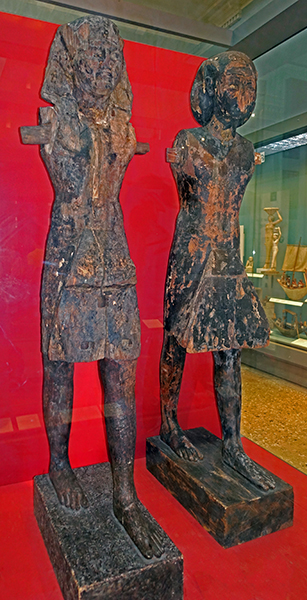
Twentieth Dynasty: 1 187 BC - 1 077 BC
Ramesses IX
Nineteenth Dynasty: 1 292 BC - 1 187 BC
Ramesses I
Right: Statue of King Ramesses I
Height 2007 mm.
The statue is made from the wood of the sycomore fig and was coated with black bitumen. It is one of two life-size statues found in the tomb of Ramesses I. The king wears the bag-like Khat headdress, and would originally have been depicted holding a staff and a mace. Headdress, kilt and other details were originally gilded over a thin layer of gesso, and the eyes and eyebrows were inlaid.
It can be seen from this statue that it is made from separate pieces, notably the arms and the front of the kilt. It is also likely that gilding was placed over certain parts of the statue, but this was stripped off when the tomb was robbed.
Catalog EA883
Left: Statue of King Ramesses IX, (also written Ramses) (originally named Amon-her-khepshef Khaemwaset), 1 129 BC - 1 111 BC was the eighth king of the Twentieth dynasty of Egypt.
Statue from Tomb 6 in the Valley of the Kings. This figure is carved from sycomore fig and represents the king wearing the Nemes Headdress. The surface of this statue was finished using less costly materials than that of Ramesses I. Black paint took the place of resin, and polychrome paint was applied instead of gold leaf. The eyes and eyebrows were carved directly from the wood, instead of being inlaid.
Catalog EA882
Photo: Don Hitchcock 2018
Source: Original, British Museum
Text: © Card with the display at the British Museum, © Trustees of the British Museum, CC BY-NC-SA 4.0, Wikipedia, http://www.britishmuseum.org/
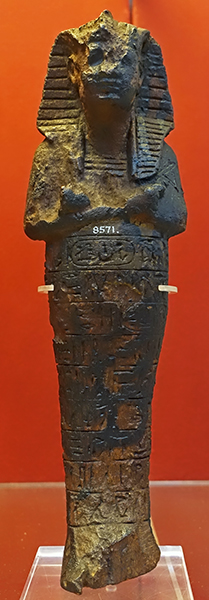
Twentieth Dynasty: 1 187 BC - 1 077 BC
Ramesses IX
Sycomore fig wood shabti of Ramses IX with a striped nemes, a modelled face, a collar and crossed hands in relief holding two incised hoes; nine rows of Hieroglyphic text on the leg section; incised seed-basket at the back; remains of a bitumen coating, circa 1 126 BC - 1 108 BC
Dimensions: Height: 310 mm, width 95 mm, depth 74 mm
Inscription: Hieroglyphic on leg section.
Catalog: Sycomore fig wood, Biban el-Muluk (Valley of the Kings - Thebes), Tomb of Ramses IX, EA8571
Photo: Don Hitchcock 2018
Source: Original, British Museum
Text: Card with the display at the British Museum, http://www.britishmuseum.org/,© Trustees of the British Museum, CC BY-NC-SA 4.0
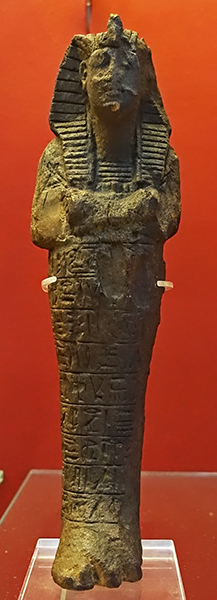
Twentieth Dynasty: 1 187 BC - 1 077 BC
Ramesses IX
Wooden shabti of Ramses IX with incised detail: a striped nemes, a modelled face, a collar and crossed hands in relief holding two small hoes and the string of the seed-basket that hangs over the shoulder; the leg section is inscribed with nine rows of Hieroglyphic text, circa 1 126 BC - 1 108 BC
Dimensions: Height: 313 mm, width 91 mm, depth 68 mm
Inscription: Hieroglyphic text on leg section.
Catalog: Wood, Biban el-Muluk (Valley of the Kings - Thebes), Tomb of Ramses IX, EA8570
Photo: Don Hitchcock 2018
Source: Original, British Museum
Text: Card with the display at the British Museum, http://www.britishmuseum.org/,© Trustees of the British Museum, CC BY-NC-SA 4.0
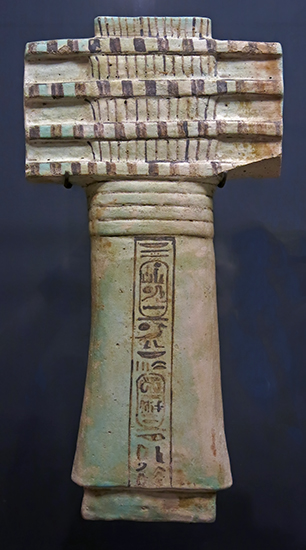
Twentieth Dynasty: 1 187 BC - 1 077 BC
Ramesses IX
Amulet in the form of a Djed pillar with the name of Ramses IX.
Circa 1 129 BC - 1 111 BC
Found in the small subterranean rooms (Serapium = Serapium of Memphis), Saqqara North, in the second room on the left when entering the small subterranean rooms. Specifically in the Chamber of Ramses VIII.
The Serapeum of Saqqara is located north west of the Pyramid of Djoser at Saqqara, a necropolis near Memphis in Lower Egypt. It was a burial place of the Apis bulls, sacred bulls that were incarnations of Ptah. It was believed that the bulls became immortal after death as Osiris-Apis, a name shortened to Serapis in the Hellenic period.
Height 330 mm, width 168 mm, thickness 26 mm.
Light green-brown, discoloured in beige.
The text on the Djed Pillar includes the cartouche, coronation name, birth name, royal name and identification text.
Catalog: Faience, Room 323, Crypt of Osiris, Vitrine 5, N 5416, IM 3120, S 1734
Photo: Don Hitchcock 2015
Source and text: Original, Louvre Museum, Paris, France, https://collections.louvre.fr/
Additional text: Wikipedia
Twentieth Dynasty: 1 187 BC - 1 077 BC
Kaha
Stela of the head sculptor Kaha, circa 1 150 BC.
Catalog: Limestone, Thebes West, Deir el-Medineh ÄS 42
Photo: Don Hitchcock 2015, 2018
Source: Original, Ägyptischen Museum München
Text: Museum card, © Ägyptischen Museum München
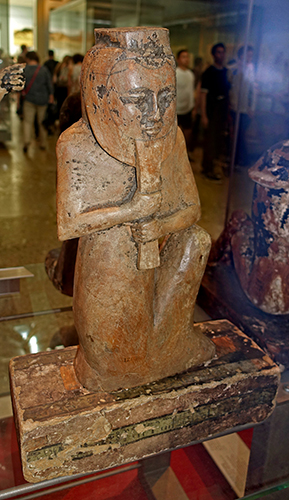
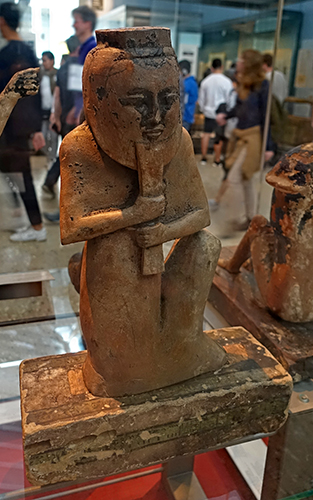
Twentieth Dynasty: 1 187 BC - 1 077 BC
Horti
Wooden figure of a squatting deity with head turned and grasping beard in both hands; recess in back with cover now glued in place. Gessoed and painted plinth. Originally covered in resin. Resin surface mostly gone, gesso chipped.
( this figure is reminiscent of figures from the Orient, it does not seem to be Egyptian in style at all - Don )
Dimensions: Height: 515 mm, width 340 mm, depth 139 mm, weight 3.50 kilograms.
Inscription: Hieroglyphic on base, Hr-ti, P-di-imn-nb-nswt-tawy, or Horti, Padiamunnebnesuttawy.
Catalog: Wood, gesso, resin, painted, Biban el-Muluk (Valley of the Kings - Thebes), Tomb of Ramses IX, EA61283
Photo: Don Hitchcock 2018
Source: Original, British Museum
Text: Card with the display at the British Museum, http://www.britishmuseum.org/,© Trustees of the British Museum, CC BY-NC-SA 4.0
References
- Adams B., Porat N. , 1996: Imported Pottery with Potmarks from Abydos, In: J. Spencer (ed.), Aspects of Early Egypt, London: British Museum Press, p. 98-107.
- Anderson W. , 1989: Badarian Burials: Possible Indicators of Social Inequality in Middle Egypt During the Fifth Millennium B.C., Department of Anthropology McGill University, Montreal April, 1989, a thesis submitted to the Faculty of Graduate Studies and Research in partial fulfilment of the requirements for the degree of Master of Arts
- Böhme I. , 2013: Die privaten Sarkophage des Neuen Reiches – ein Vorbericht, Göttinger Orientforschungen IV Ägypten 54, DAI Kairo - German Archaeological Institute Cairo, preliminary paper for a PhD thesis.
- Breasted J. , 1903: Jewellery from the Tombs of Egypt, The Biblical World, Vol. 22, No. 1 (Jul., 1903), pp. 64-66, published by The University of Chicago Press, http://www.jstor.org/stable/3140533.
- Brunton G., Caton-Thompson C., 1928: The Badarian civilization and predynastic remains near Badari, (British School of Archaeology in Egypt and Egyptian research account : thirtieth year, 1924). 1928
- Brunton G., Morant G., 1937: Mostagedda and the Tasian Culture, British Museum Expedition to Middle Egypt, First and Second Years (1928, 1929), B. Quaritch Limited, 1937 - Egypt - 163 pages
- Caton-Thompson E., Gardner E., 1934: The Desert Fayum, Royal Anthropological Institute of Great Britain and Ireland, London, 1934.
- Cowie S., Johnson T., 2001: The Mummy in Fact, Fiction and Film, McFarland, 3 Dec. 2001 - Performing Arts - 208 pages
- Cramer M., 1936: Zeitschrift für Ägyptische Sprache und Altertumskunde, Volume 72, 1936. pp. 100ff. u. Tf. IX, 1, 2.
- David R., 2002: The Experience of Ancient Egypt, Rutledge, 9 Sep. 2002 - Social Science - 216 pages
- Davies B., 1999: Who's who at Deir el-Medina : a Prosopographic Study of the Royal Workmen's Community, Leiden : Nederlands Instituut voor Het Nabije Oosten, 1999
- Davies Norman de Garis, 1925: The Tomb of Two Sculptors at Thebes, The Metropolitan Museum of Art, Robb de Peyster Tytus Memorial Series Volume IV.
- Dodson A., Hilton D., 2004: The Complete Royal Families of Ancient Egypt, The American University in Cairo Press, London 2004
- Erman A., 1894: Life in Ancient Egypt, Courier Corporation, 1894 - History - 570 pages
- Ertman E., 2013: Gesichtseinlage von König Echnaton / Amenophis IV. aus opak-blauem Glas, Auszug und Übersetzung aus Journal of Glass Studies 2013-55, S. 13-19
- Escolano-Poveda M., 2019: Egypt’s Pharaohs welcomed summer with this fabulous festival, 20/03/20. Retrieved from: https://www.nationalgeographic.com/history/magazine/2019/05-06/ancient-egypt-royal-feast/
- García J., 2013: Ancient Egyptian Administration, BRILL, 7 Jun. 2013 - Reference - 1112 pages
- Gatto M., 2001-2002: Two Predynastic pottery caches at Bir Sahara (Egyptian Western Desert), Sahara, 13: 51 - 60
- Habicht M., 2014: Semenchkare - Phantom-König von Achet-Aton: Beitrag zur Erforschung der rätselhaften Nachfolge von Echnaton,epubli, 17 Feb 2014 - Science - 96 pages
- Harer W., 1985: Pharmacological and Biological Properties of the Egyptian Lotus, Journal of the American Research Center in Egypt, Vol. 22 (1985), pp. 49-54 Published by: American Research Center in Egypt DOI: 10.2307/40000390
- Hartwig M., 2006: A Companion to Ancient Egyptian Art, John Wiley & Sons, 23 Dec. 2014 - Literary Criticism - 624 pages
- Hodel-Hoenes S., 2006: Life and Death in Ancient Egypt: Scenes from Private Tombs in New Kingdom Thebes, Cornell University Press, 2000 - Art - 329 pages
- Holmes D., 1989: The Predynastic Lithic Industries of Upper Egypt: A Comparative Study of the Lithic Traditions of Badari, Nagada and Hierakonpolis, BAR (15) 469, Volumes I and II.
- Humphreys C., Waddington G., 2017: Solar eclipse of 1207 BC helps to date pharaohs, Astronomy & Geophysics, Volume 58, Issue 5, 1 October 2017, Pages 5.39–5.42, https://doi.org/10.1093/astrogeo/atx178, Published: 01 October 2017
- Jung M., 2012a: F. Seyfried (eds.), In the Light of Amarna. 100 years of the discovery of the Nefertiti, Berlin 2012, p. 206 (cat. No. 7).
- Jung M., 2012b: in: F. Seyfried (Hrsg.), Im Licht von Amarna. 100 Jahre Fund der Nofretete, Berlin 2012, p. 332
- Kákosy L., 1995: 'The Soter Tomb in Thebes', in S.P, Vleeming (ed.), Hundred-Gated Thebes: Acts of a Colloqium on Thebes and the Theban area in the Graeco-Roman Period, Leiden: Brill, 61- 67
- Kayser H., 1969: Ägyptisches Kunsthandwerk: ein Handbuch für Sammler und Liebhaber, Braunschweig, Klinkhardt & Biermann, 1969
- Kitchen K., 1993: Ramesside inscriptions : translated and annotated Notes and comments, 1, Ramesses I, Sethos I and contemporaries (Oxford, 1993), 2-3.
- Loret V., 1889: La Tombe de Khâ-M-Hâ, in: Gaston Maspero, in: Urbain Bouriant - Victor Loret - H. Dulac (editors), Mémoires publiés par les membres de la mission archéologique française au Caire, Tome premierFasc. 1, Paris 1889, plate 1 after page 114
- Malkowski E., 2010: Before the Pharaohs: Egypt's Mysterious Prehistory, Inner Traditions / Bear & Co, Apr 12, 2010 - History - 336 pages
- Martin G., 1991: Hidden Tombs of Memphis, Thames and Hudson, London 1991
- Maspero G., 1903: History of Egypt, Chaldea, Syria, Babylonia, and Assyria, London : Grolier Society
- Math N., 2014: Die Badarikultur, Neue Untersuchungen zu einer Kultur des 5. Jahrtausends v. Chr., angestrebter akademischer Grad Master of Arts (MA) Wien, 2014
- McKerrel H., Tylecote R., 1972: The working of copper-arsenic alloys in the Early Bronze Age and the effect on the determination of provenance, Proceedings of the Prehistoric Society, 38, pp. 209–218. doi: 10.1017/S0079497X00012111.
- Mettlen J., 2012: in: F. Seyfried (Hrsg.), Im Licht von Amarna. 100 Jahre Fund der Nofretete, Berlin 2012, p. 344 (cat. No. 126).
- Meyer-Dietrich E., 2017: Auditive Räume des alten Ägypten: Die Umgestaltung einer Hörkultur in der Amarnazeit, Brill, 9 Nov. 2017, pp. 1128.
- O'Connor D., Cline E., 2001: Amenhotep III: Perspectives on His Reign, University of Michigan Press, 2001 - History - 393 pages
- Patch D., Eaton-Krauss M., Allen S., 2011: Dawn of Egyptian Art, Jan 1, 2011 - Art, Ancient - 275 pages
- Pommerening, T., Marinova, E., Hendrickx, S., 2010: The Early Dynastic origin of the water-lily motif, Chronique d'Egypte, 85 (2010): 14-40
- Raven M., 1980: Papyrus-sheaths and Ptah-Sokar-Osiris Statues, RMO, 1980 - 296 pages
- Rawlinson H., 1867: The Assyrian Canon Verified by the Record of a Solar Eclipse, B.C. 763, Athenaeum, #2064 660 (18 May)
- Riemer H., Kuper R., 2000: 'Clayton rings': enigmatic ancient pottery in the Eastern Sahara, Sahara, 12: 91-100.
- Roth A., Roehrig C., 2002: Magical Bricks and the Bricks of Birth, The Journal of Egyptian Archaeology Vol. 88 (2002), pp. 121-139 (19 pages) Published By: Sage Publications, Inc. The Journal of Egyptian Archaeology https://doi.org/10.2307/3822340 https://www.jstor.org/stable/3822340
- Schneider H., Raven M., 1981: De Egyptische Oudheid, Rijksmuseum van Oudheden, Leiden.
- Schneider H., Raven M., 1999: Life and Death Under the Pharaohs, Rijksmuseum van Oudheden, Leiden.
- Schoske S., Wildung D., 2013: Das Münchner Buch der Ägyptischen Kunst, München 2013
- Seyfried F., 2012: Im Licht von Amarna. 100 Jahre Fund der Nofretete, Berlin 2012, p. 322.
- Shaw I., 2000: The Oxford History of Ancient Egypt, Oxford University Press, USA, 31 Aug. 2000 - History - 528 pages
- Smith H., 2006: The Fortress of Buhen: The Inscriptions, (London, 1976), 118-19, no. 1511, pls. XXV/1, LXXIV/2-3
- Spanel D., 2001: in Redford D. (ed.), The Oxford Encyclopedia of Ancient Egypt, vol. 1, Oxford University Press, 2001
- Strudwick N., 2006: Masterpieces of Ancient Egypt, University of Texas Press, 1 Nov. 2006 - Social Science - 352 pages
- Taylor J., 1999: Studies in Egyptian antiquitie, British Museum, Occasional Paper 123 (1999)
- Taylor J., 2010: Journey Through the Afterlife: Ancient Egyptian Book of the Dead, Harvard University Press, 2010 - History - 320 pages
- Verner M., 2014: From The Pyramids, Atlantic Books Ltd, 6 Nov. 2014 - History - 300 pages
- Wallert I., 1967: Der verzierte Löffel. Seine Formgeschichte und Verwendung im Alten ÄgyptenÄgyptologische Abhandlungen, 16,Wiesbaden: Harrassowitz.
- Weber A., 2012: in: F. Seyfried (ed.) Im Licht von Amarna. 100 Jahre Fund der Nofretete, Berlin 2012, S. 226 (Kat.-Nr. 18). Atlantic Books Ltd, 6 Nov. 2014 - History - 300 pages
- Wegner E., 2012: in: F. Seyfried (Hrsg.), Im Licht von Amarna. 100 Jahre Fund der Nofretete, Berlin 2012, p. 348 (cat. No. 129).
- Wilkinson T., 2002: Early Dynastic Egypt, Routledge, 11 Sep. 2002 - Social Science - 440 pages
Back to Don's Maps
 Back to Archaeological Sites
Back to Archaeological Sites
 Back to Egypt Index Page
Back to Egypt Index Page
